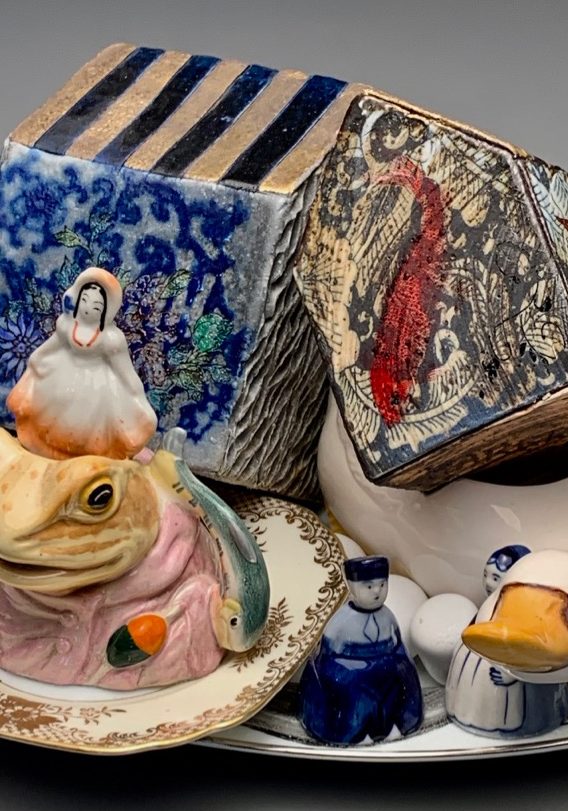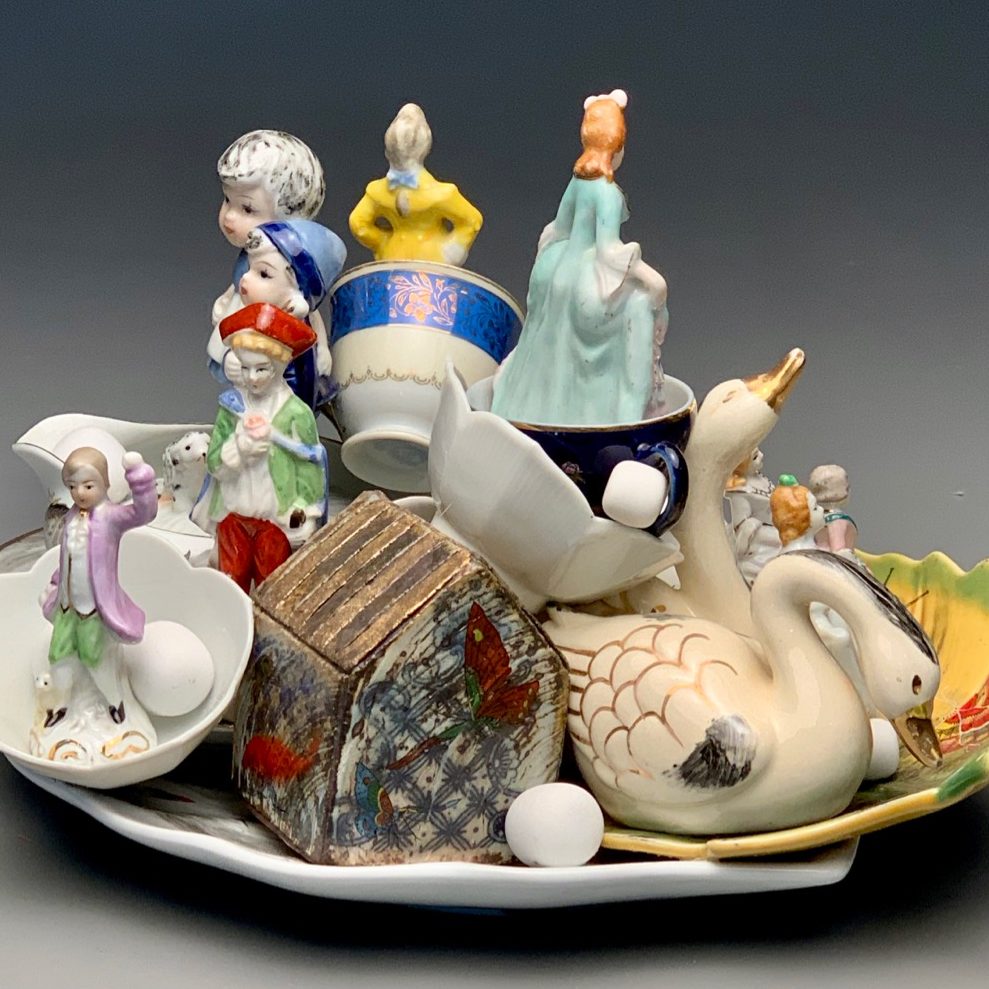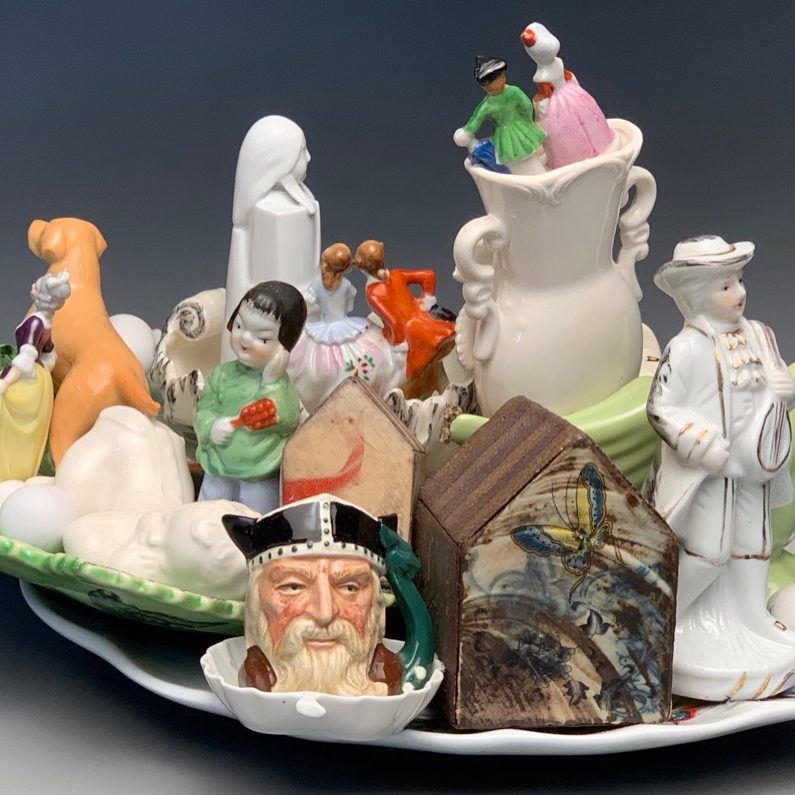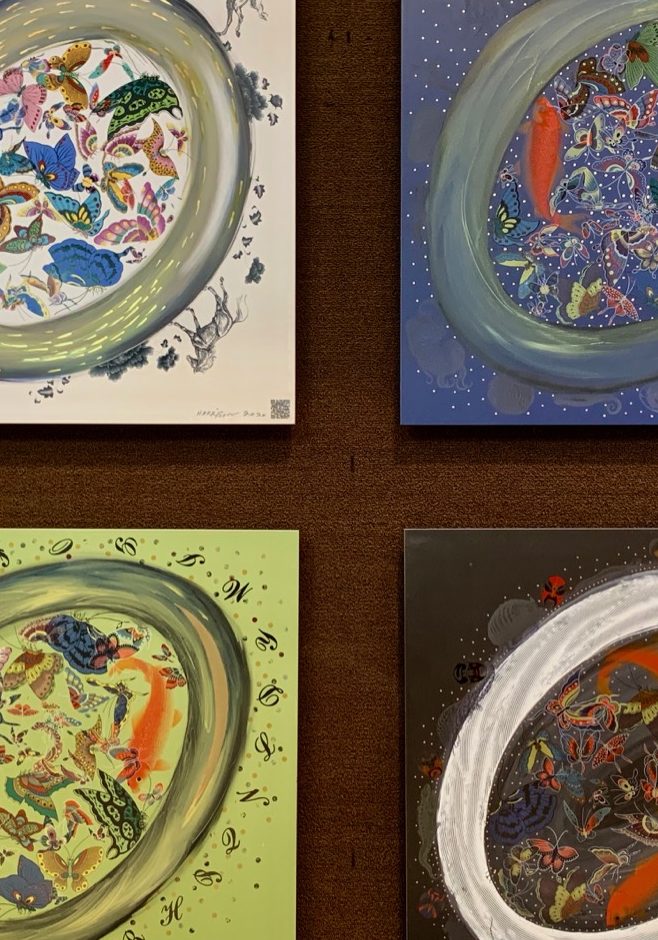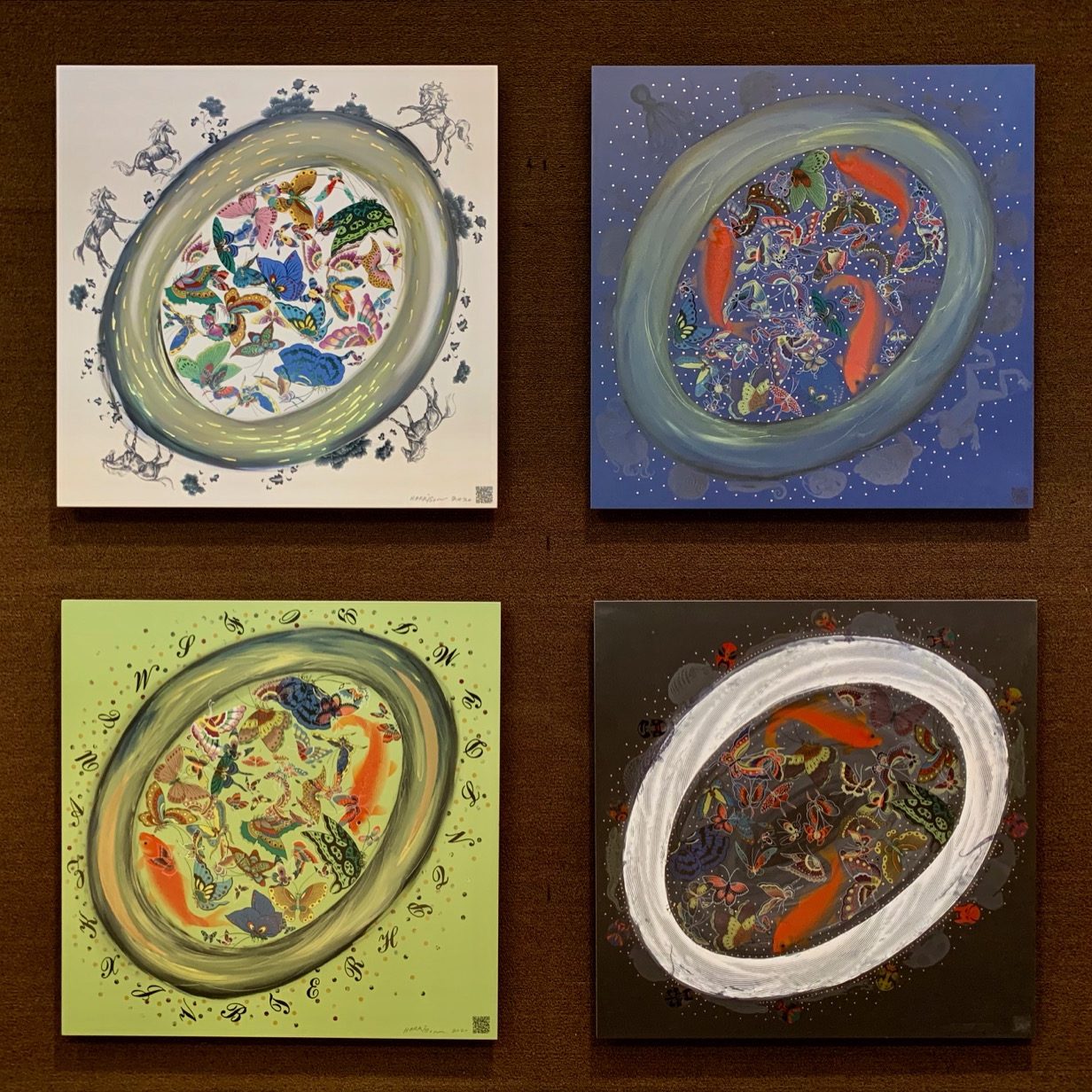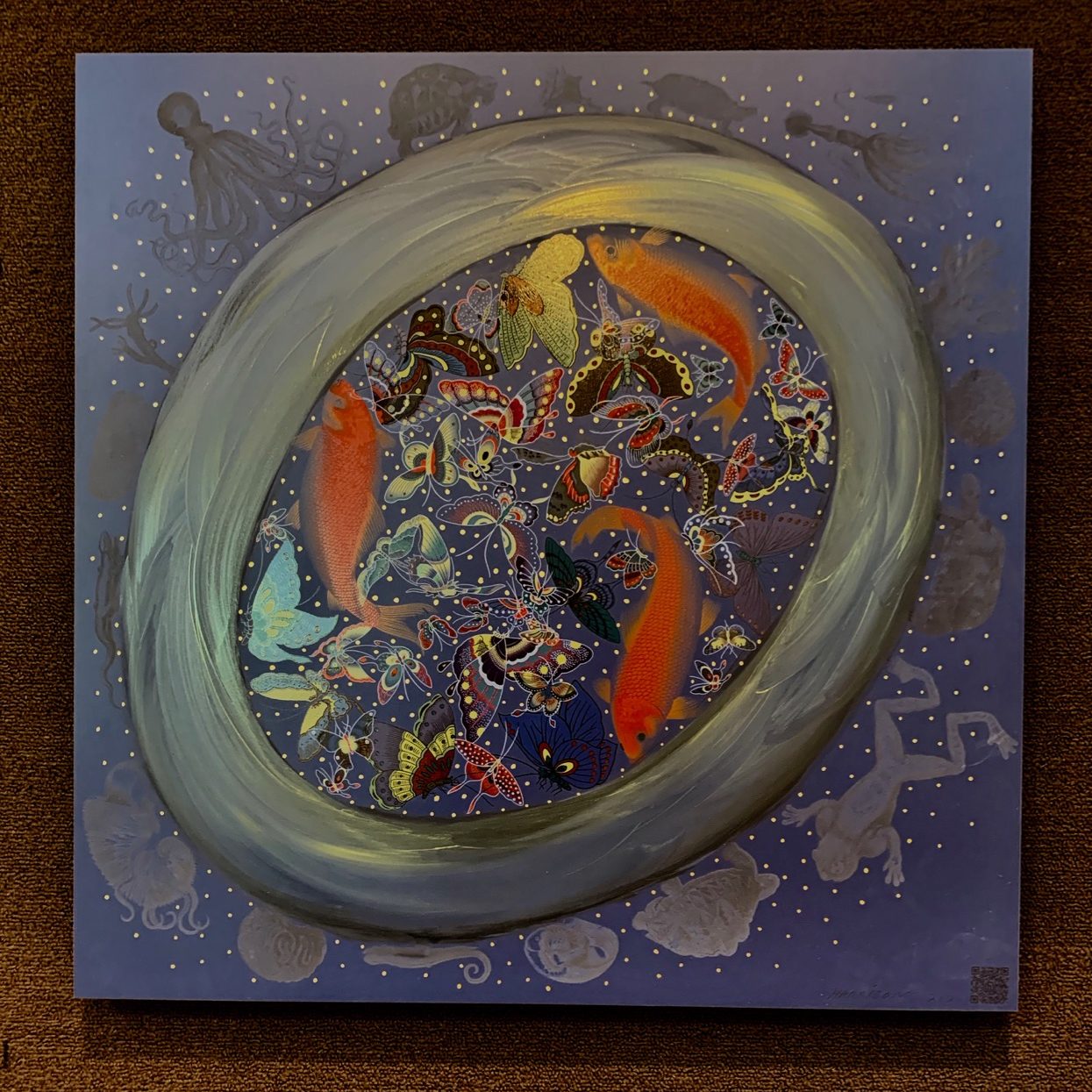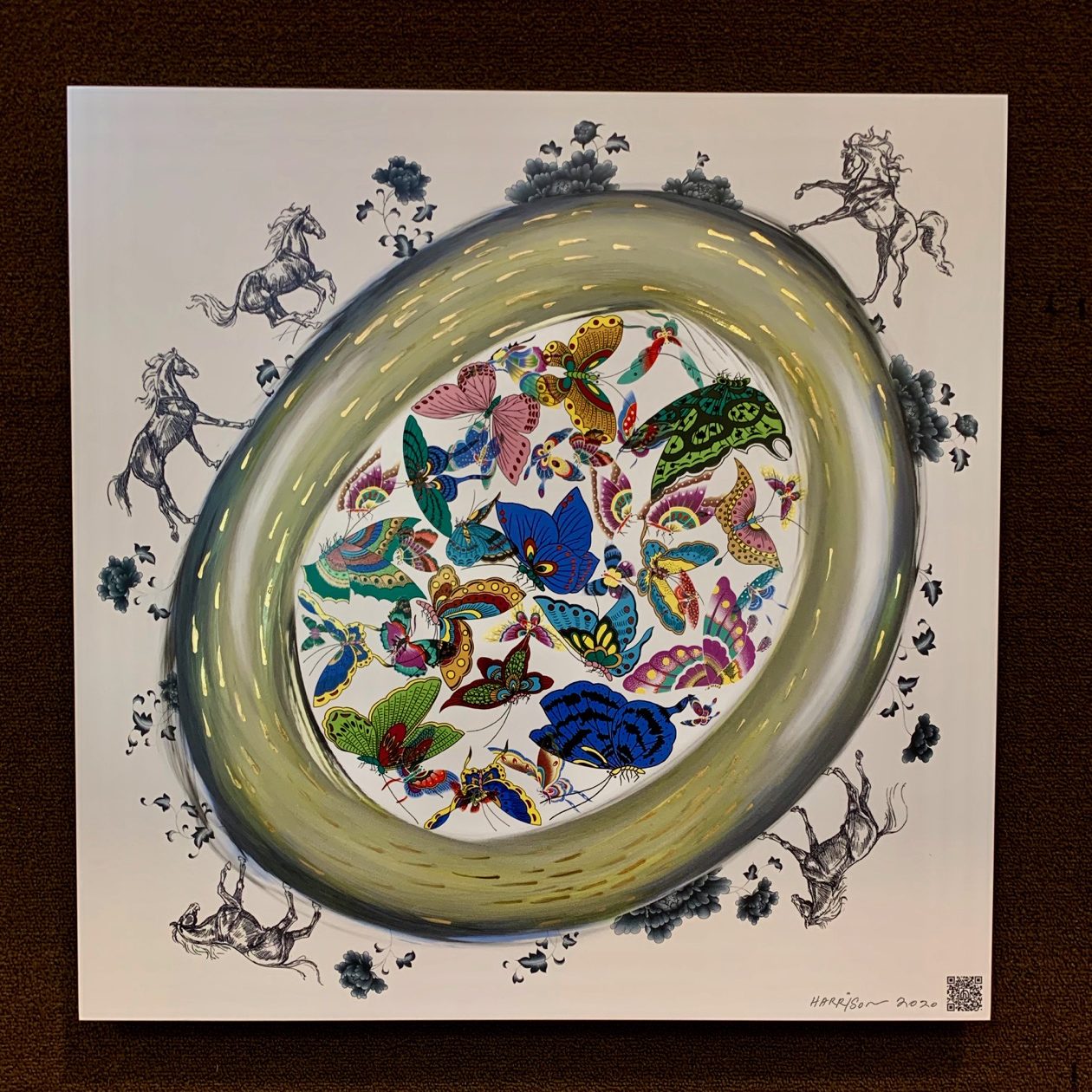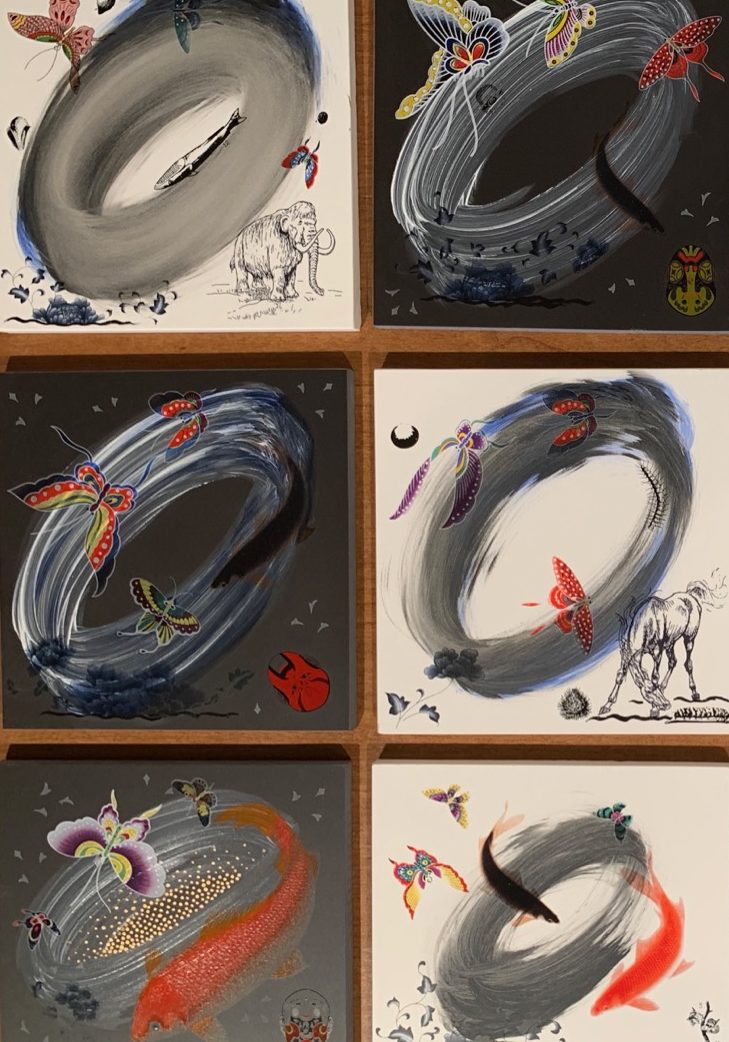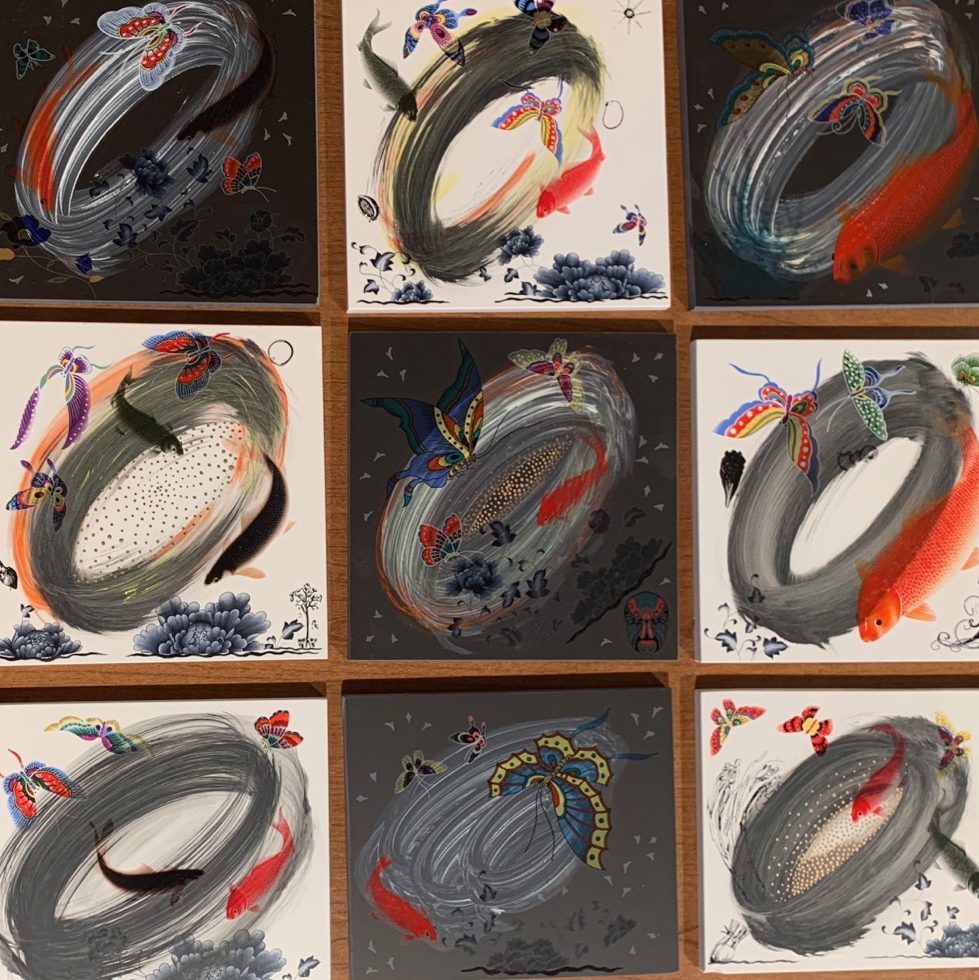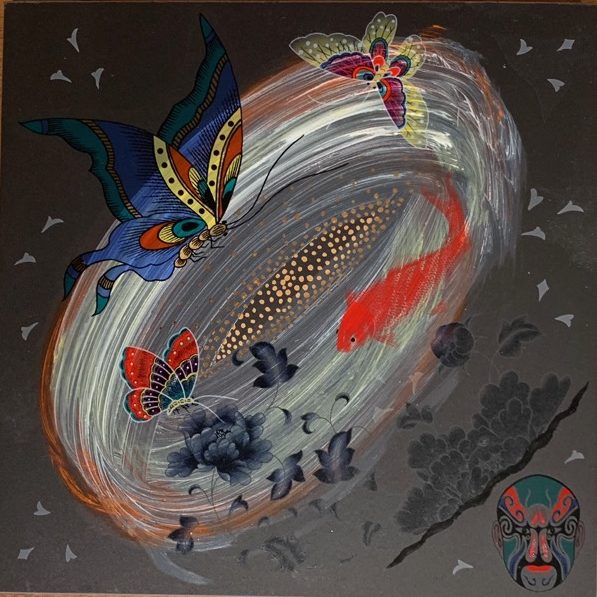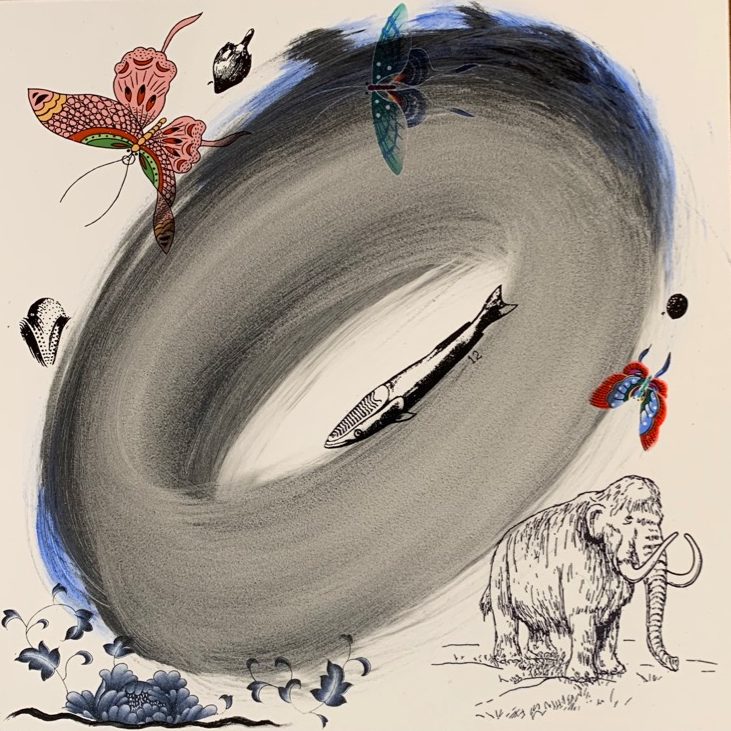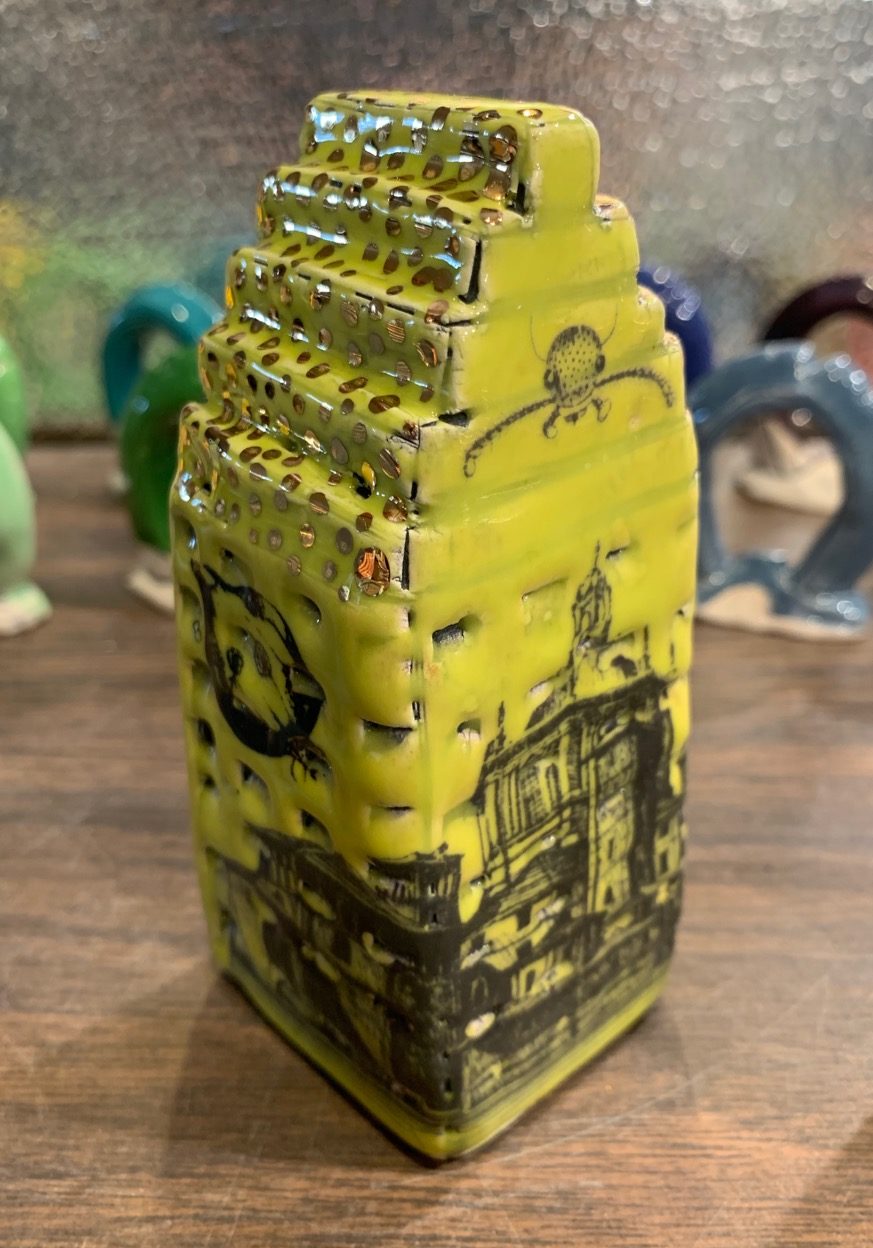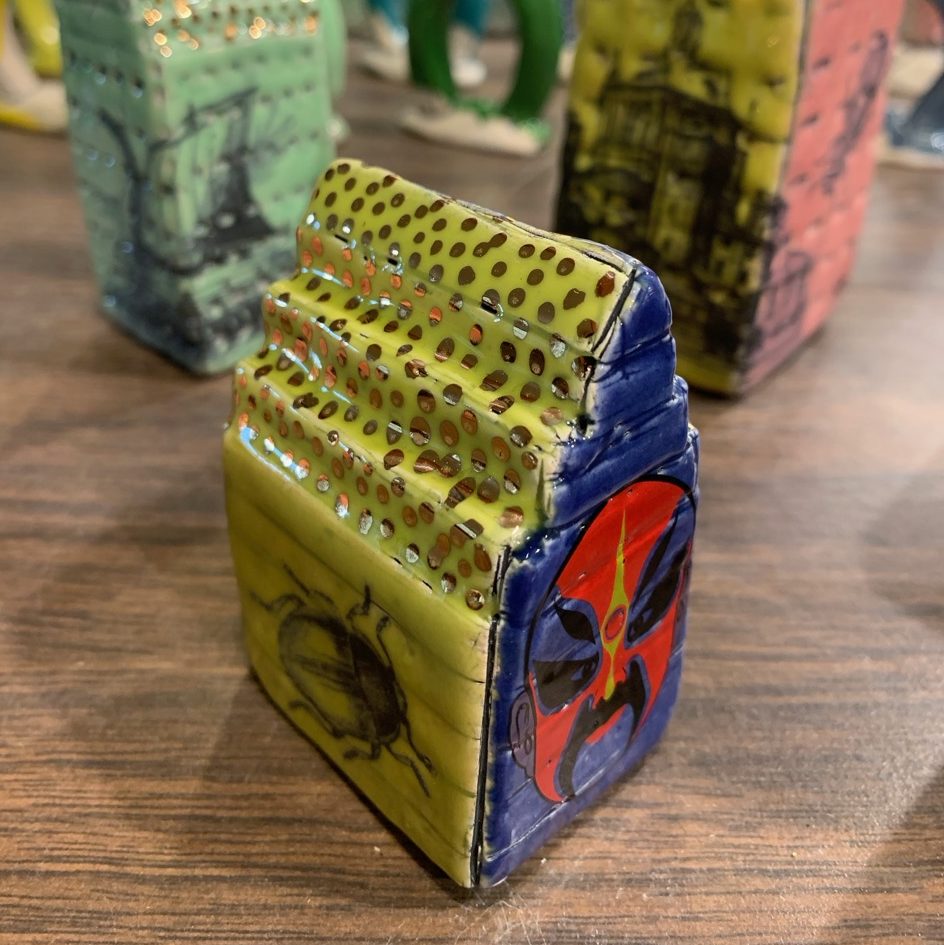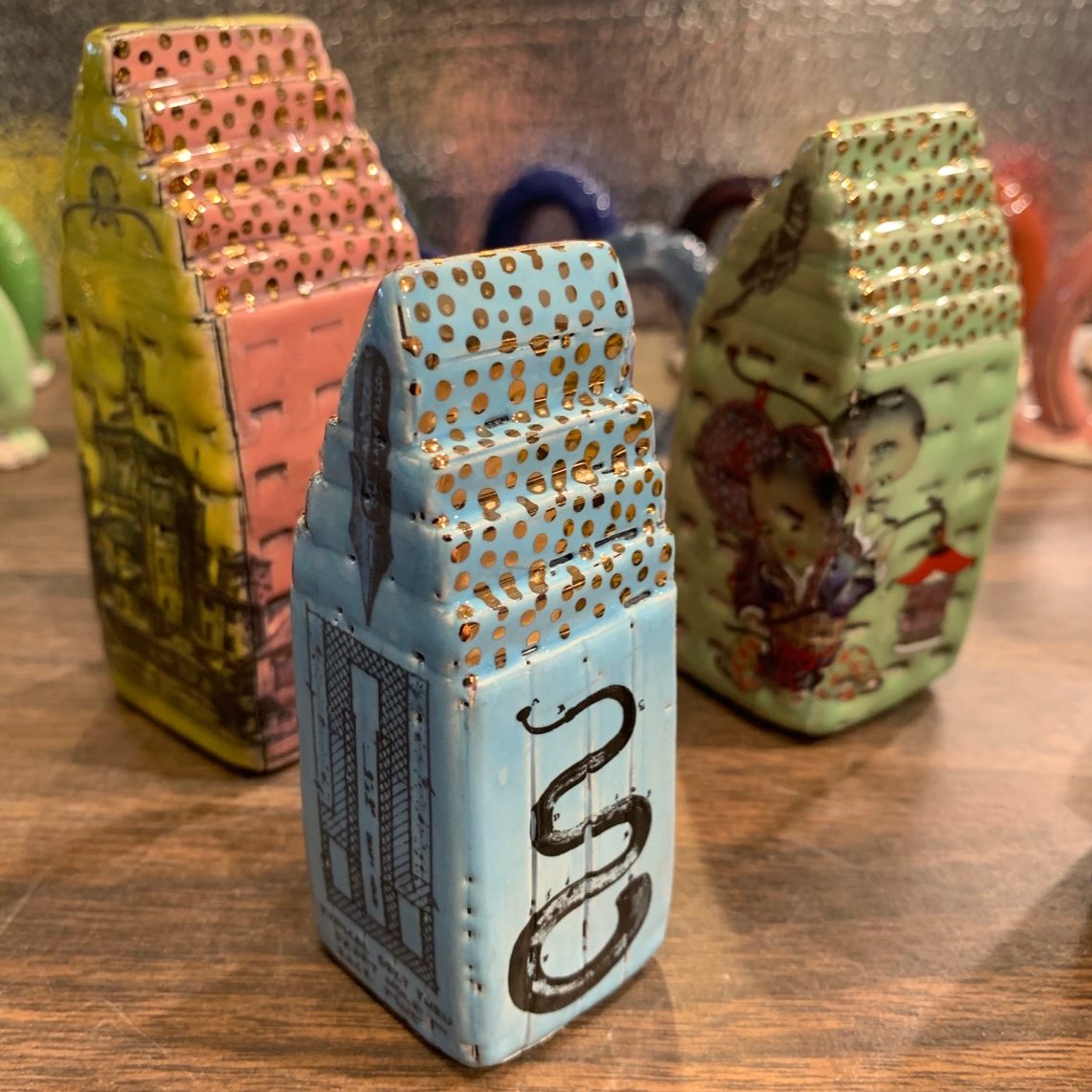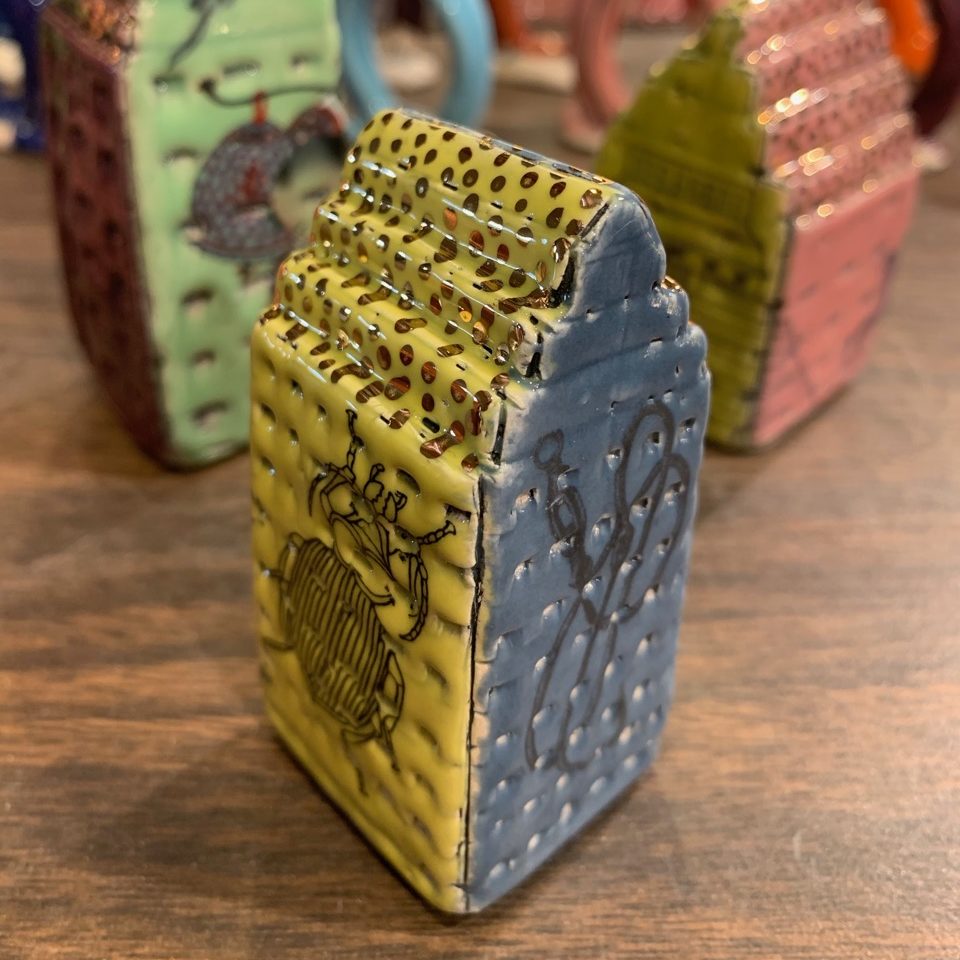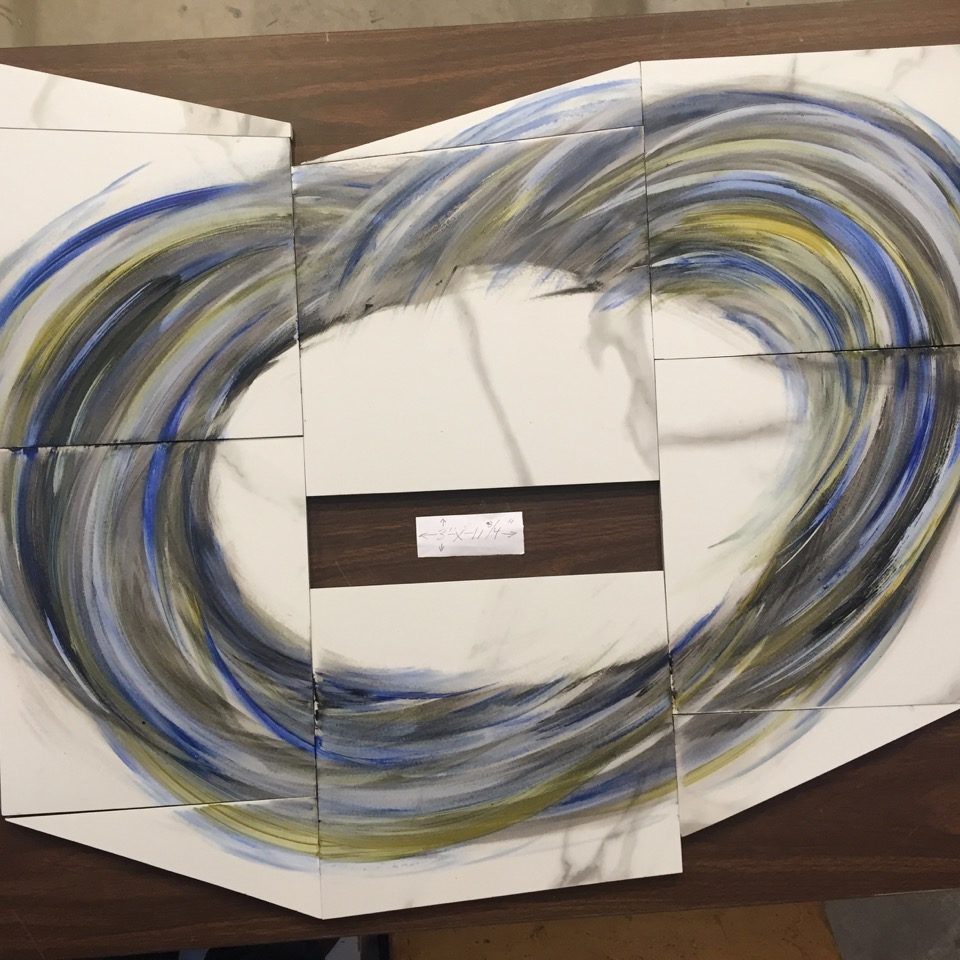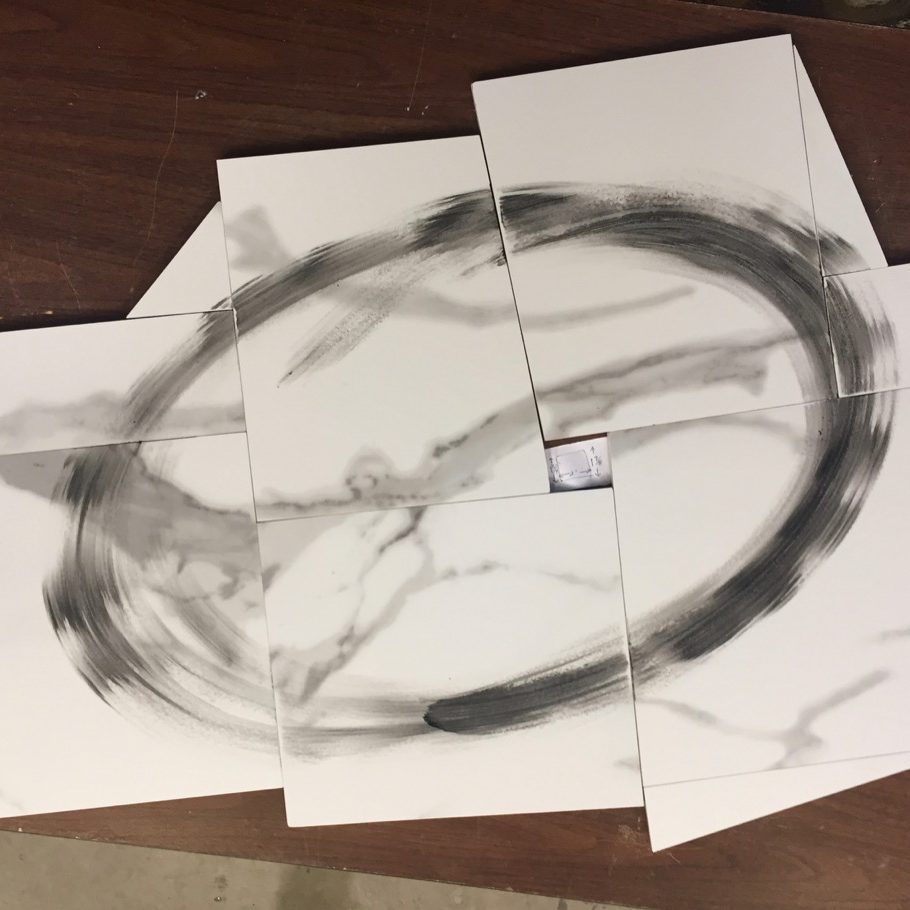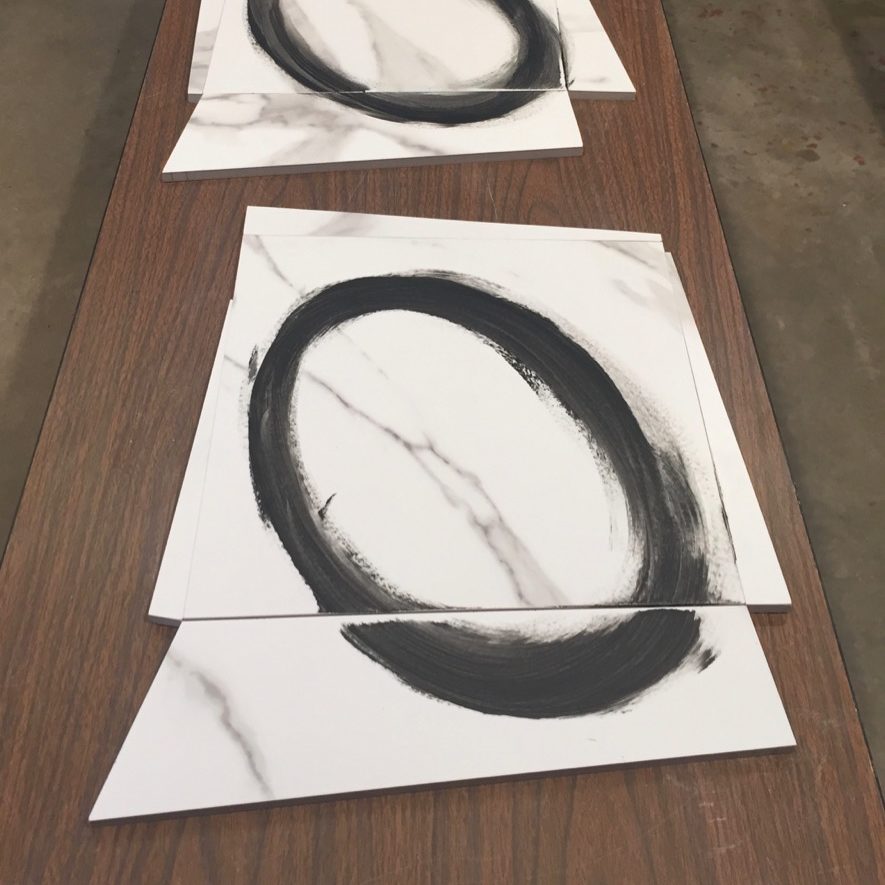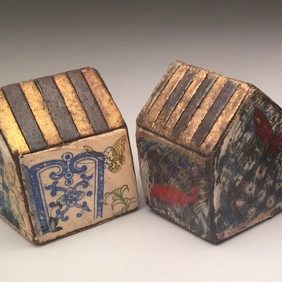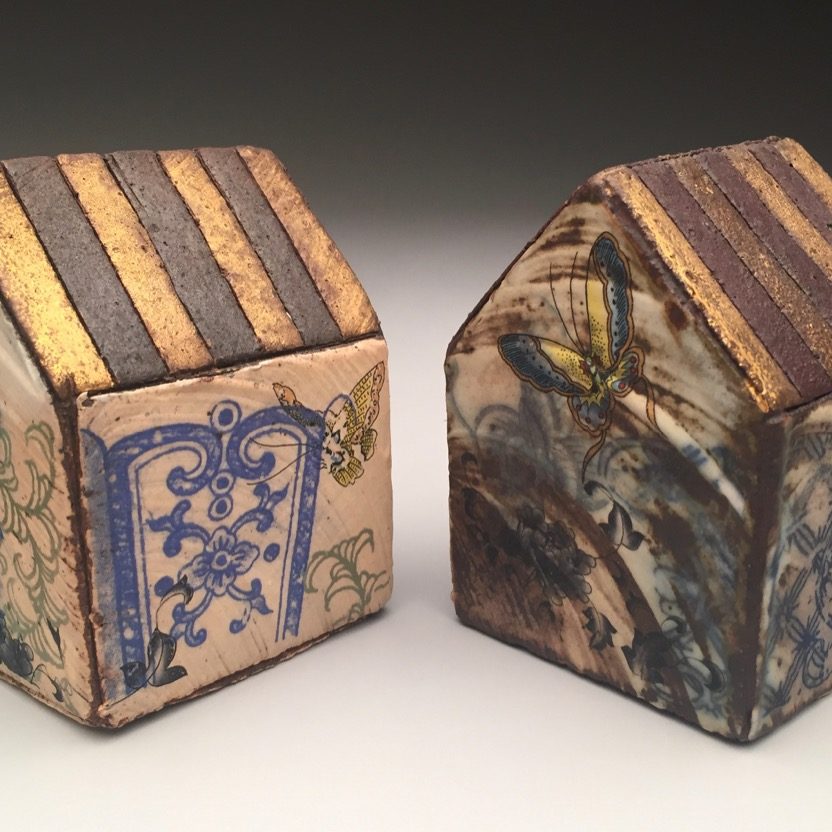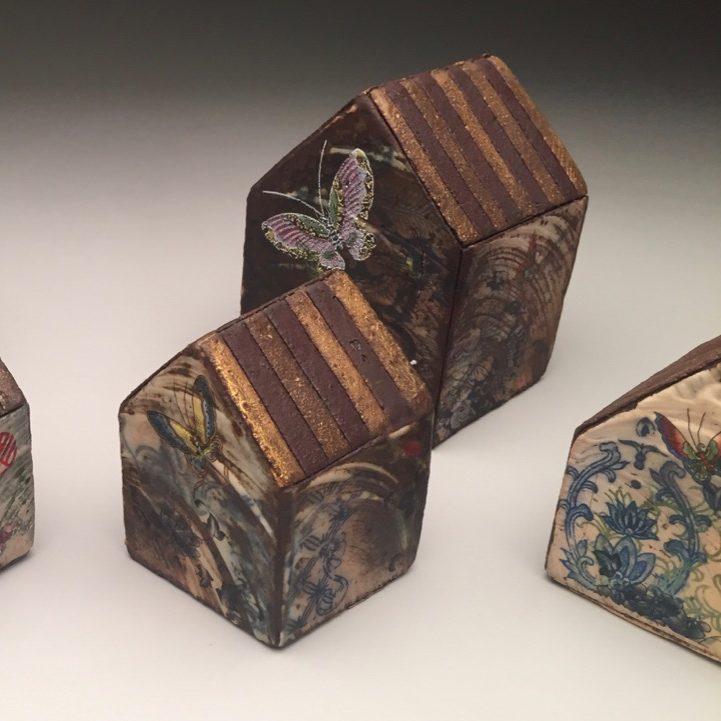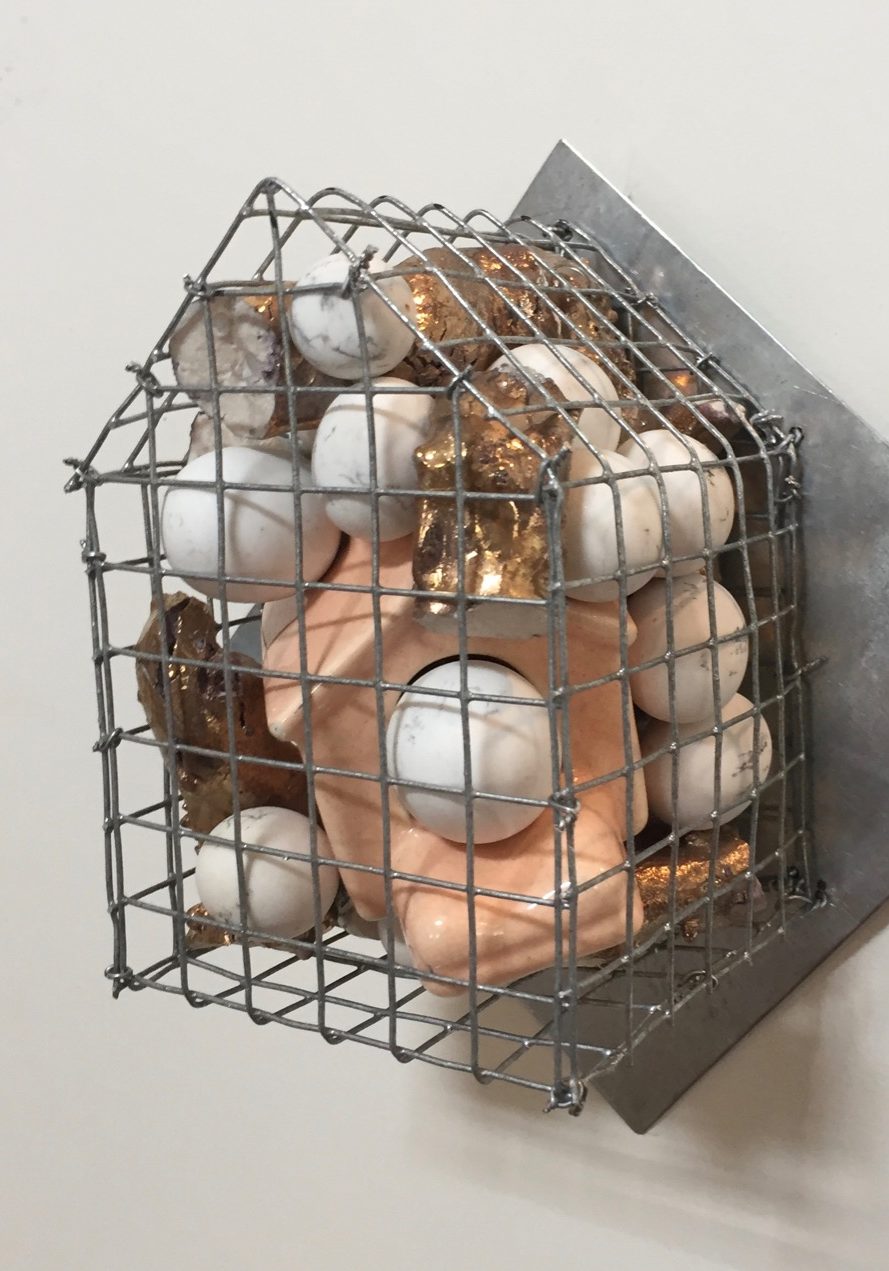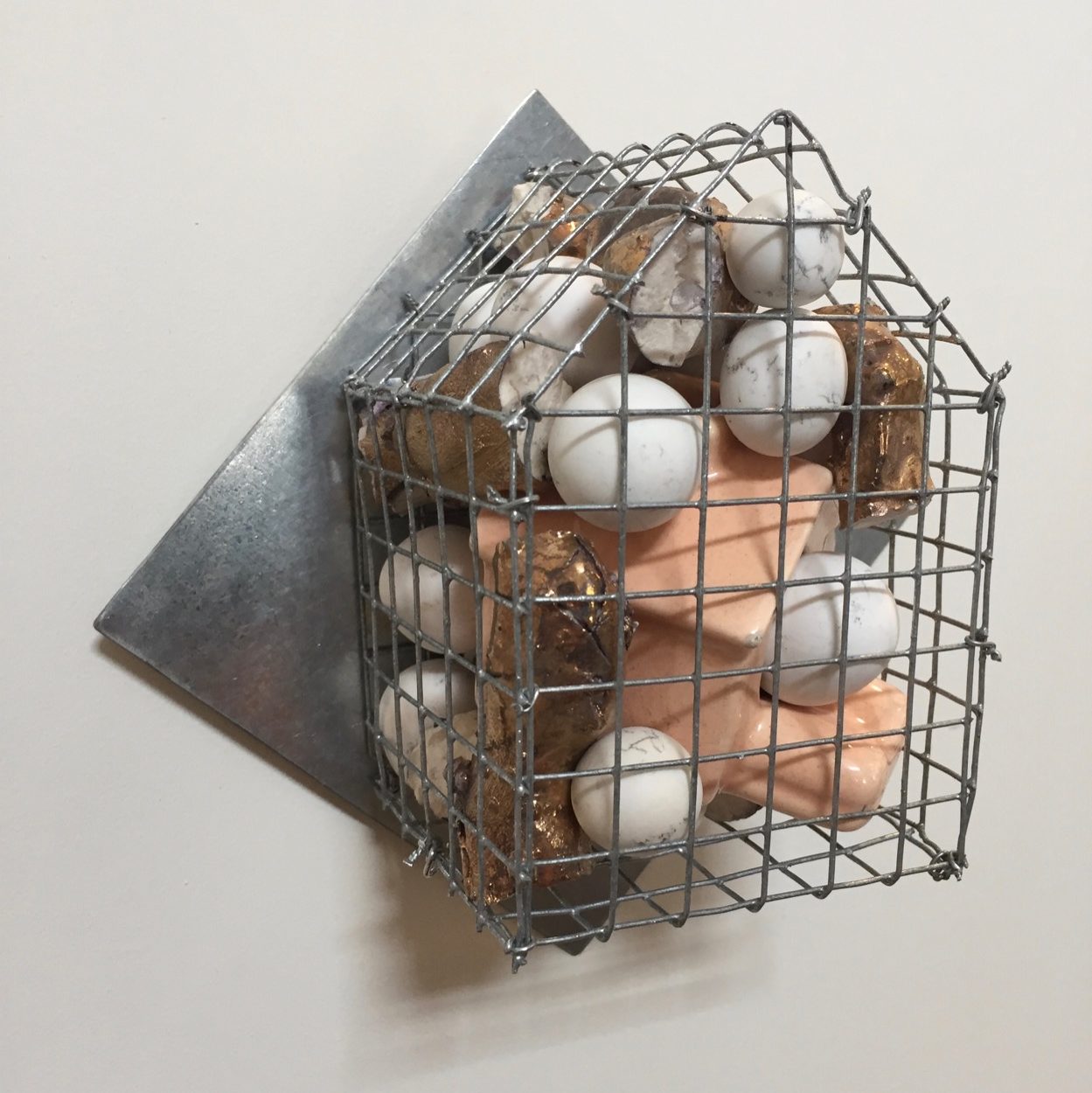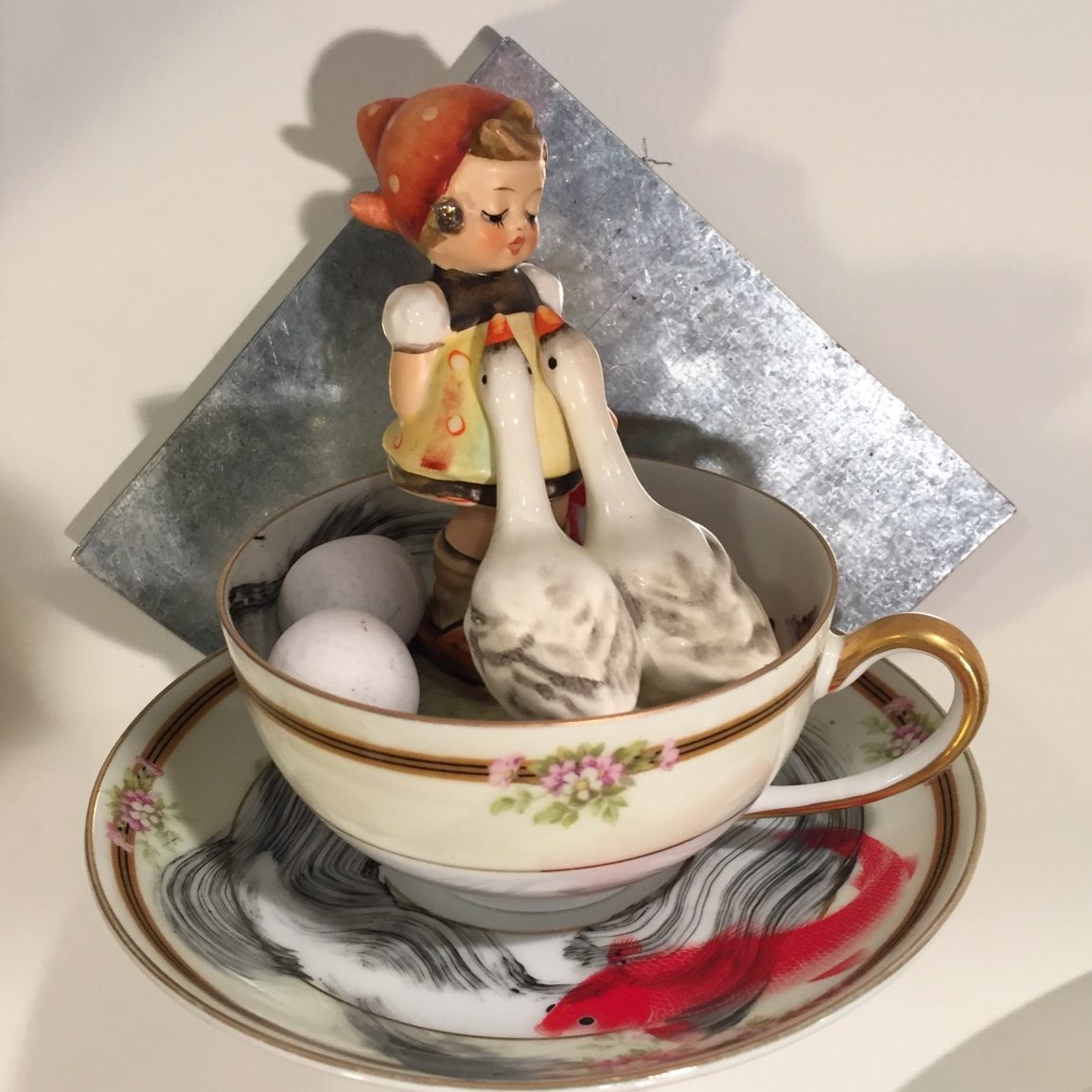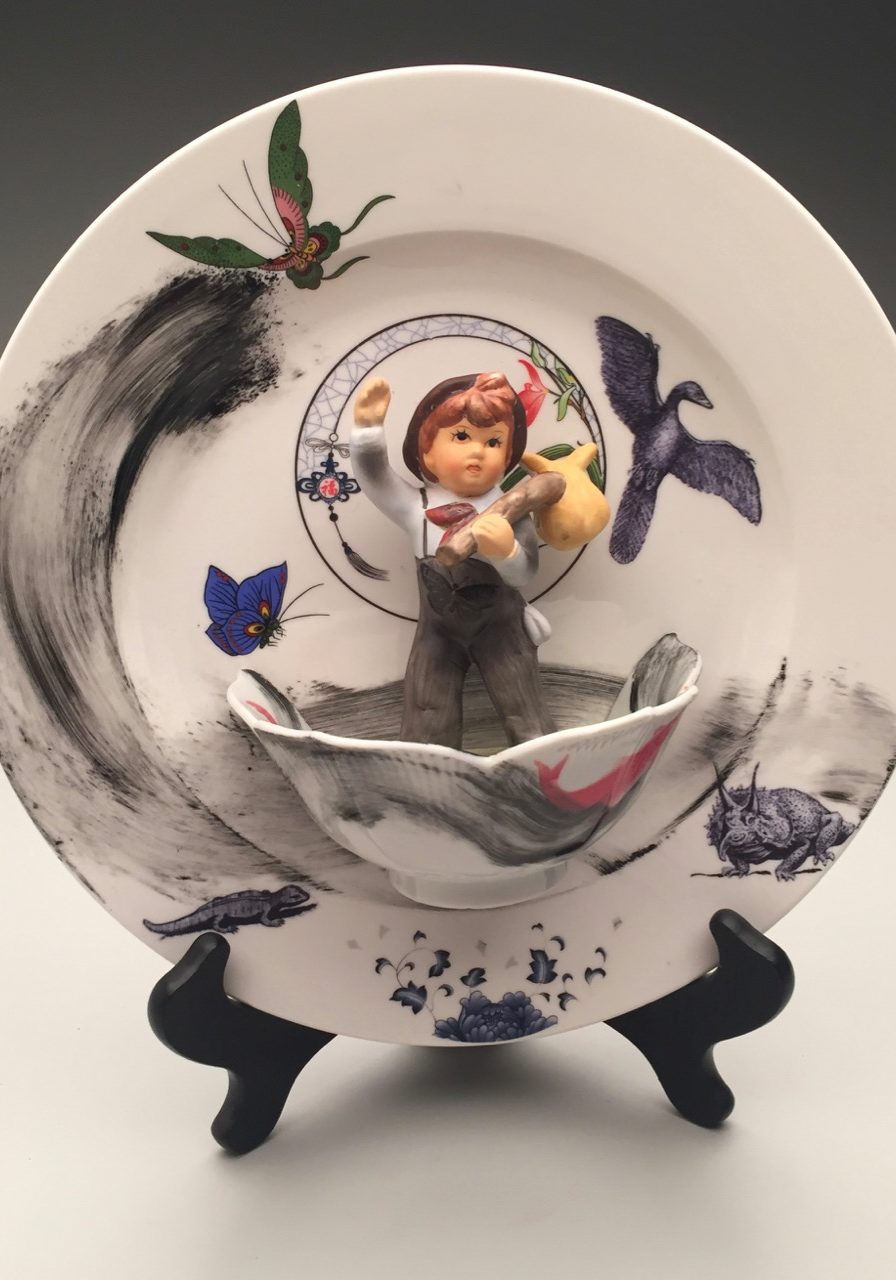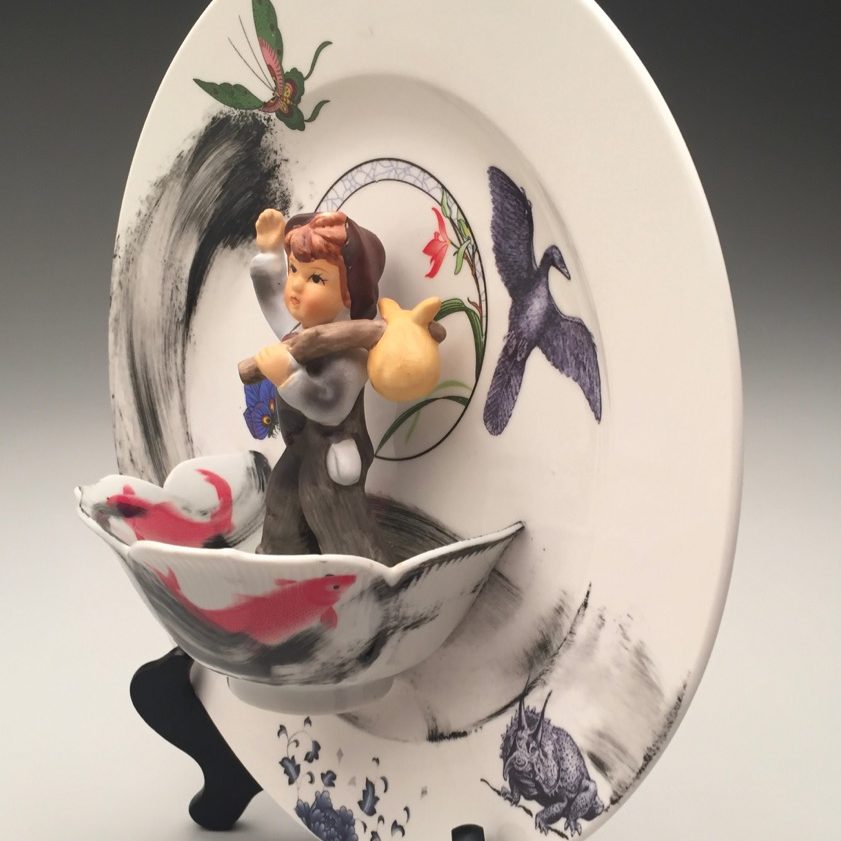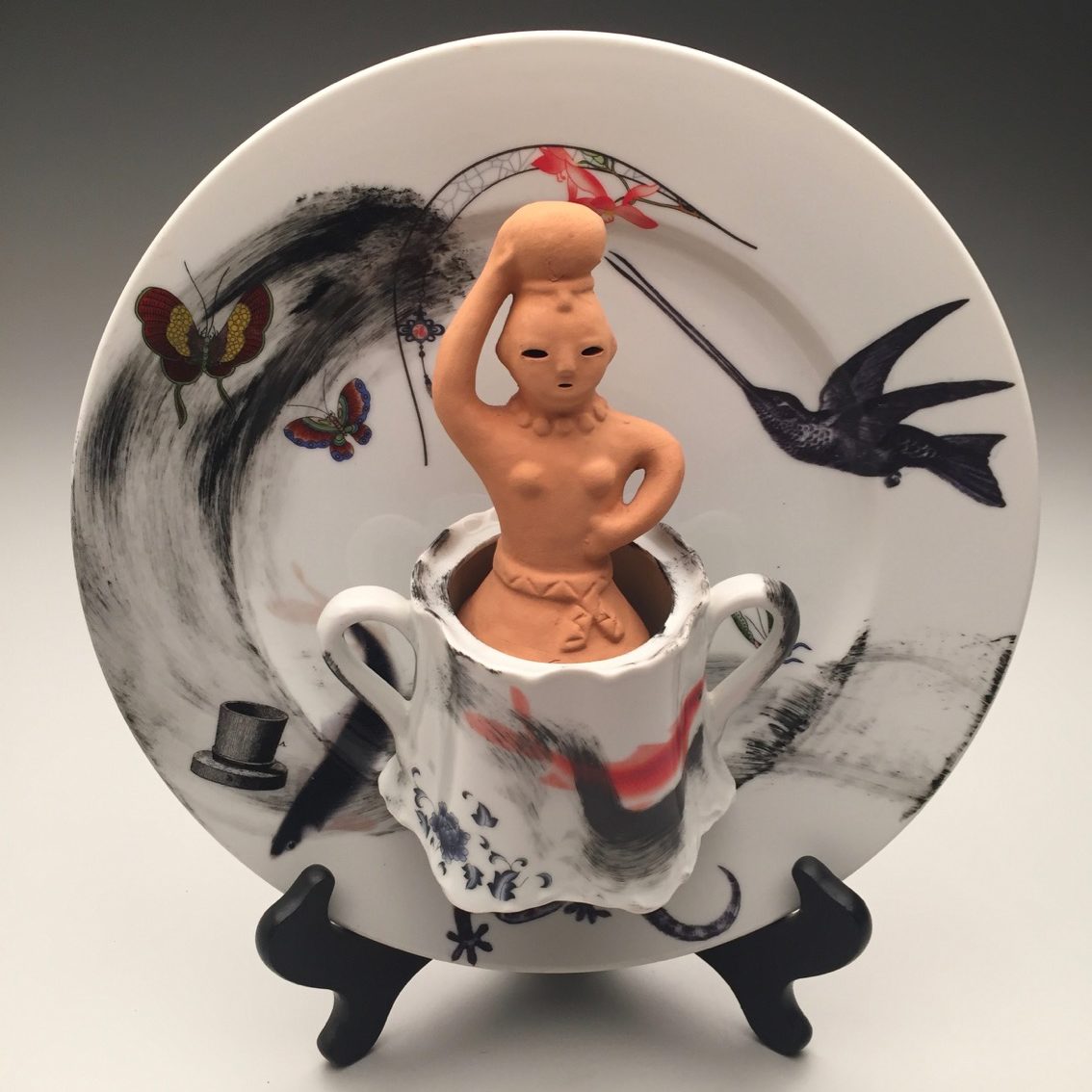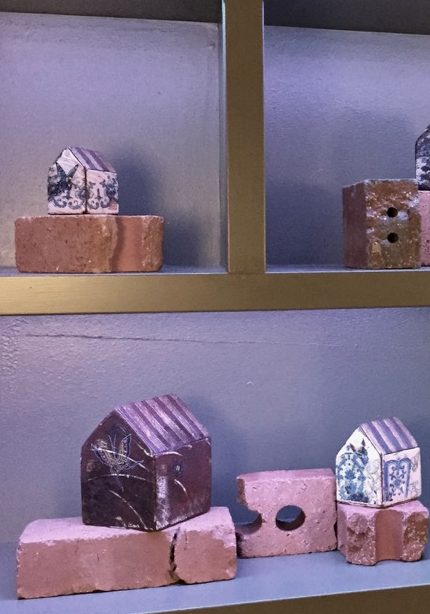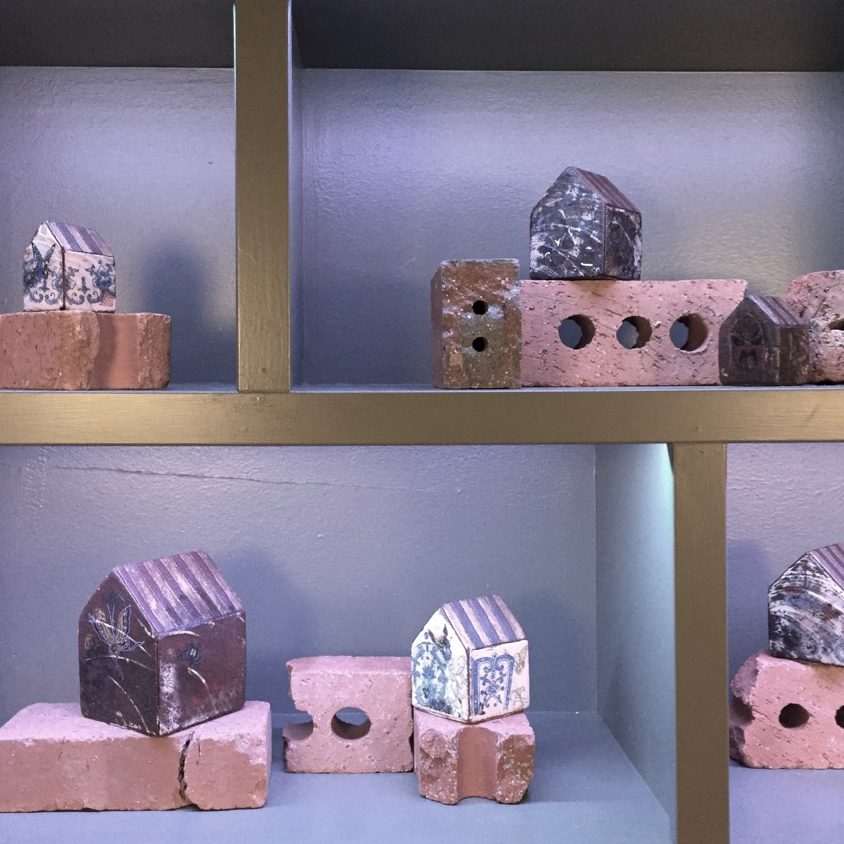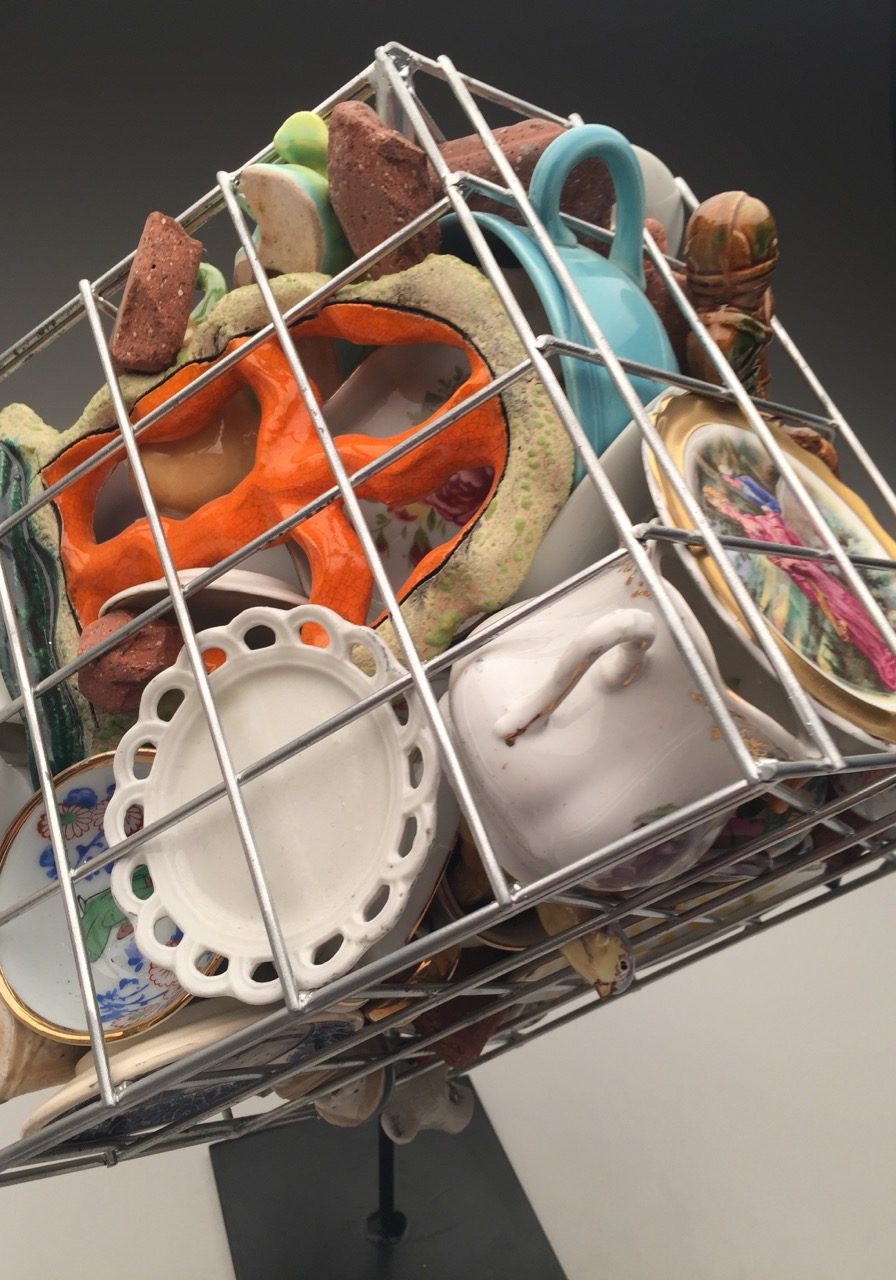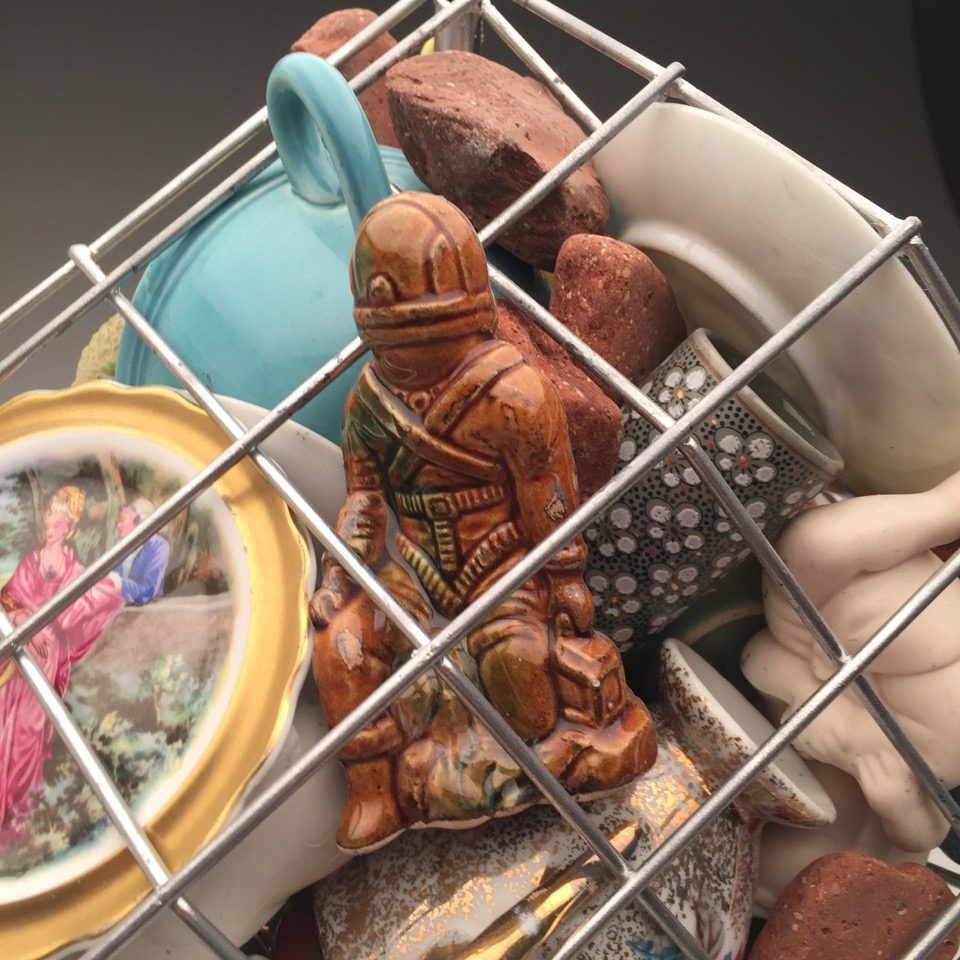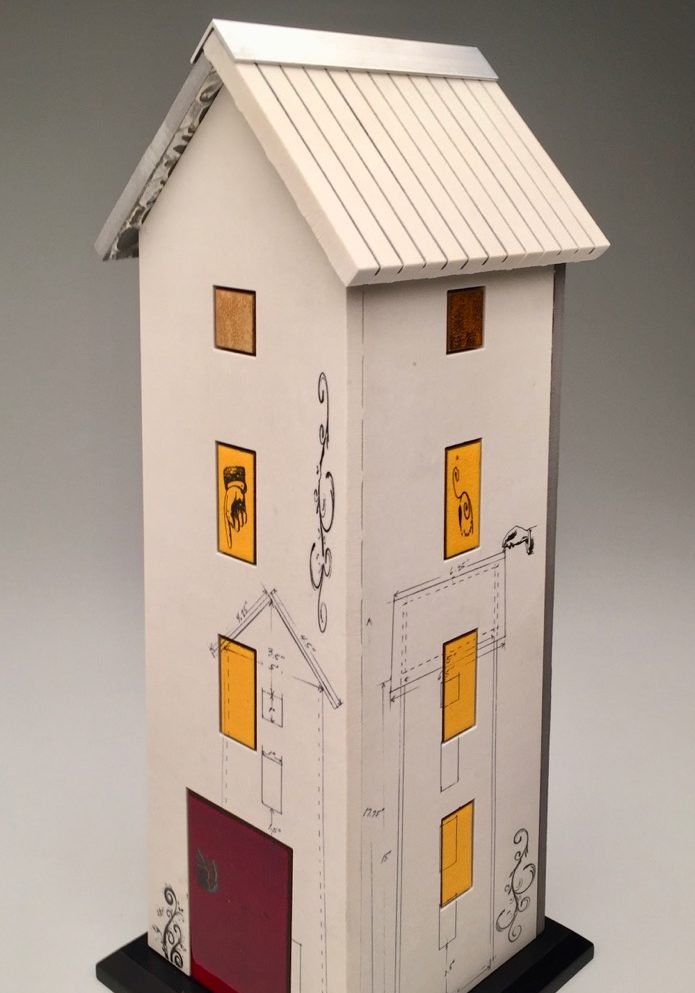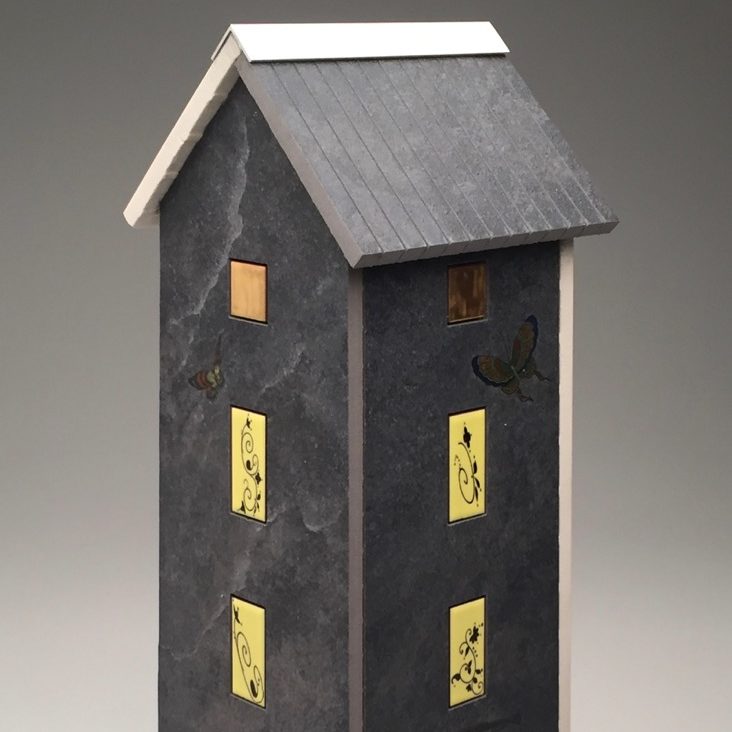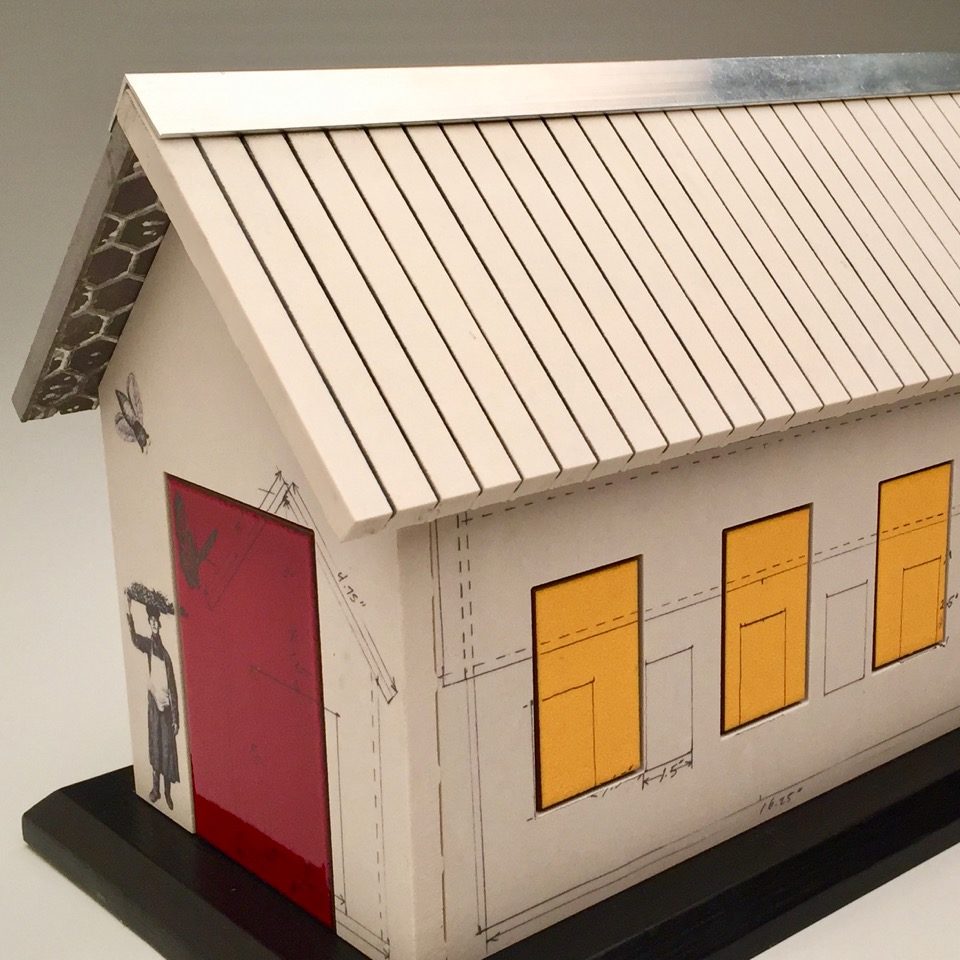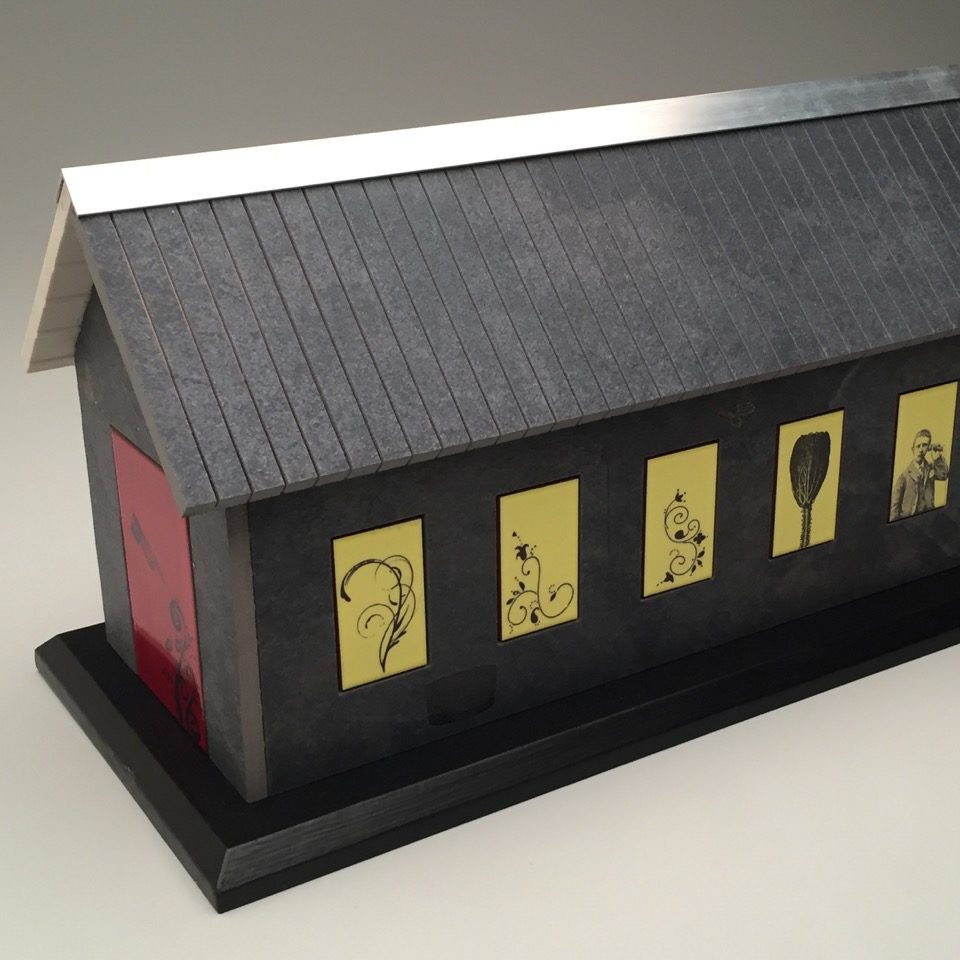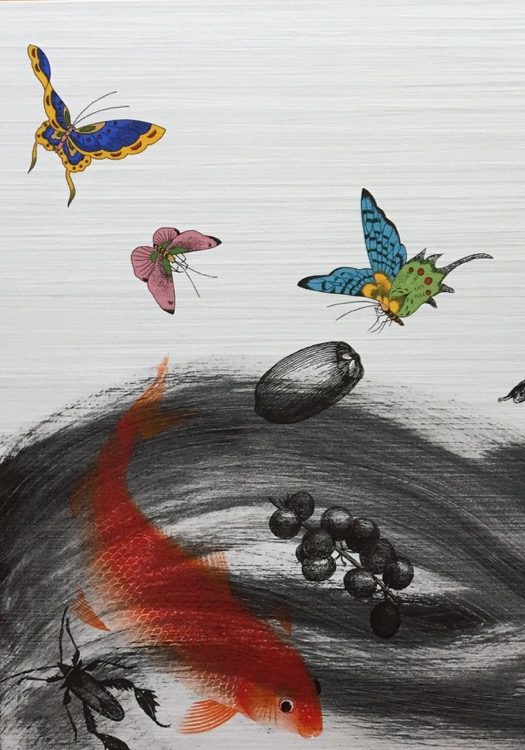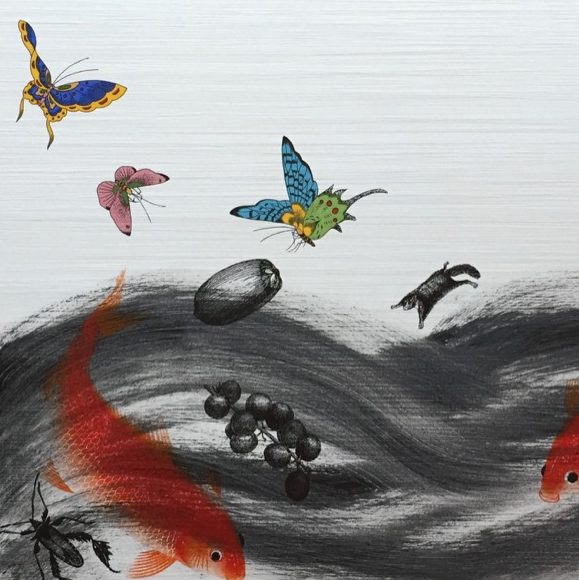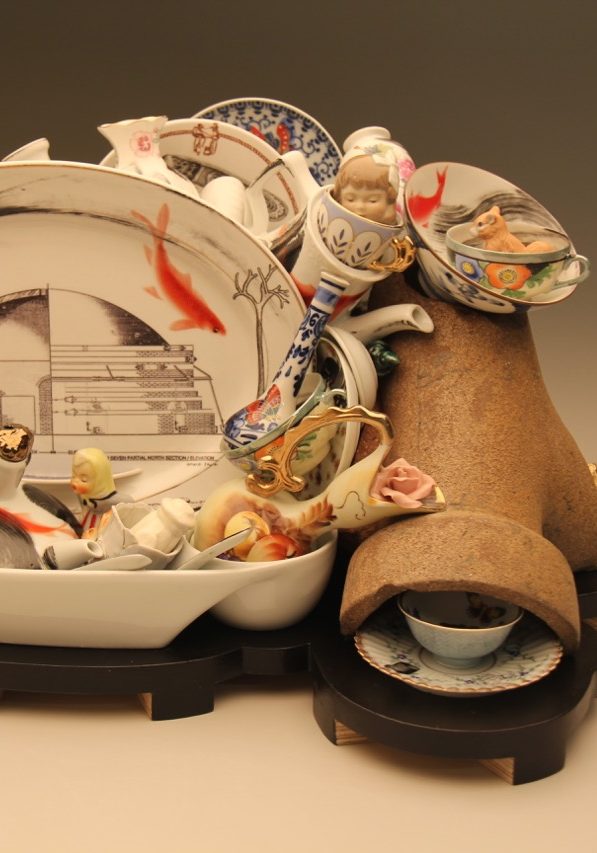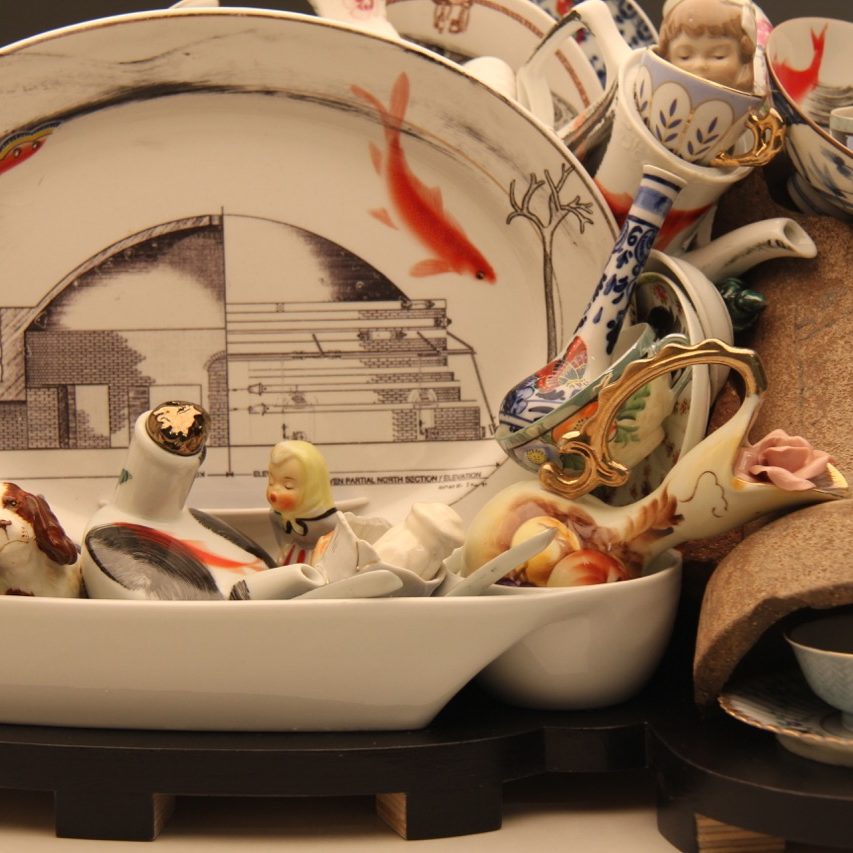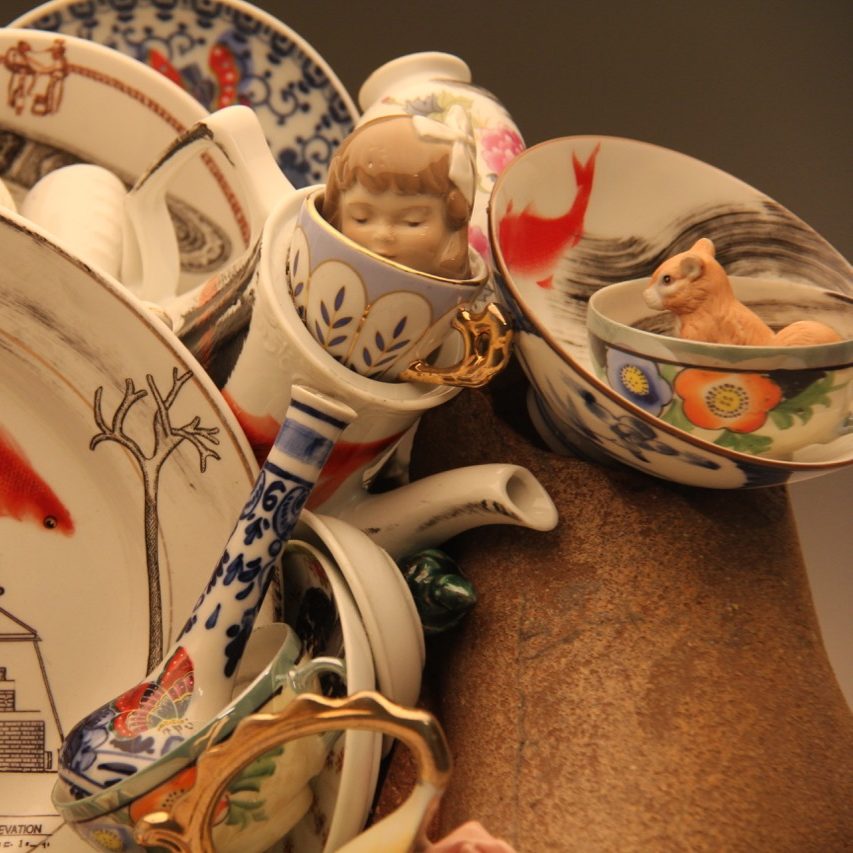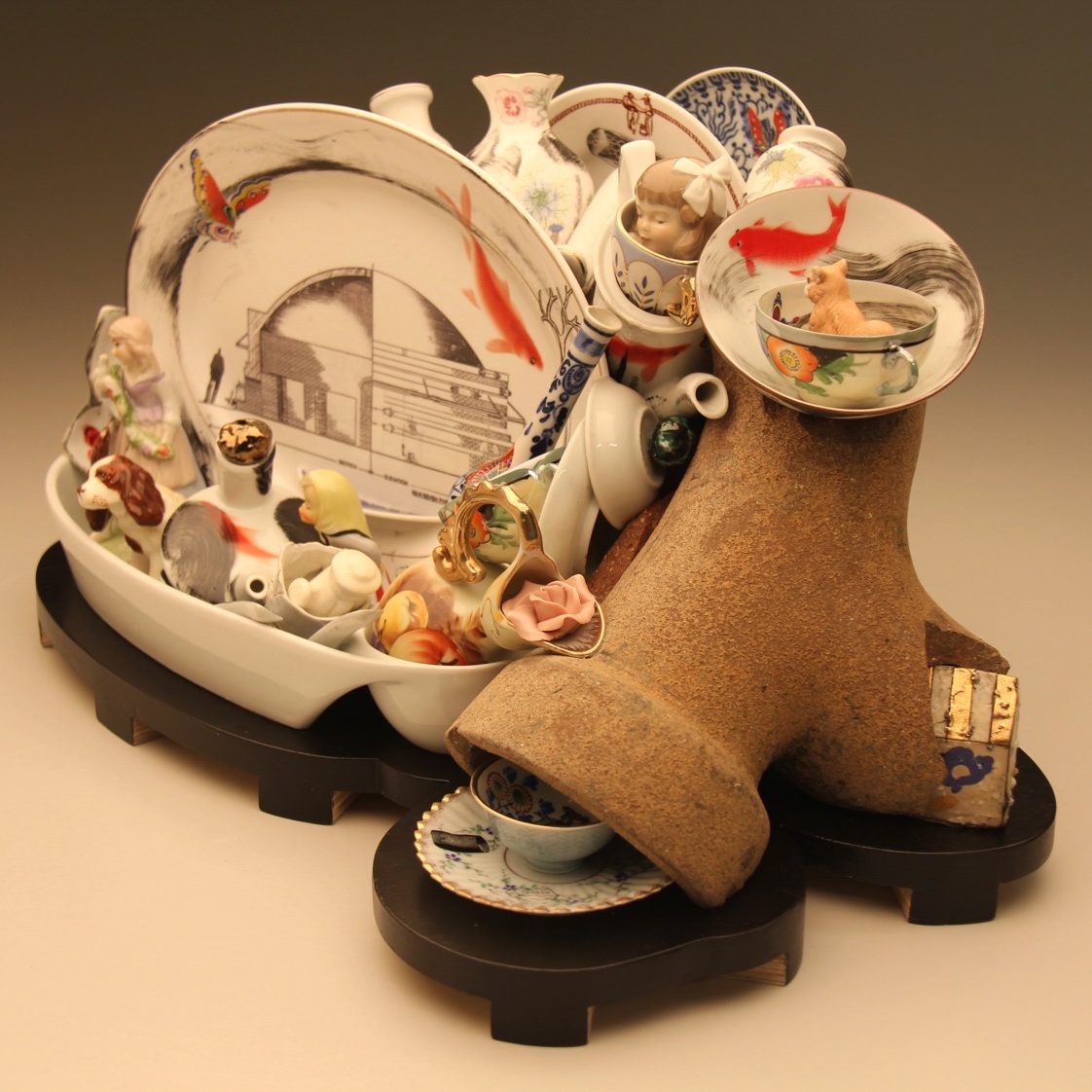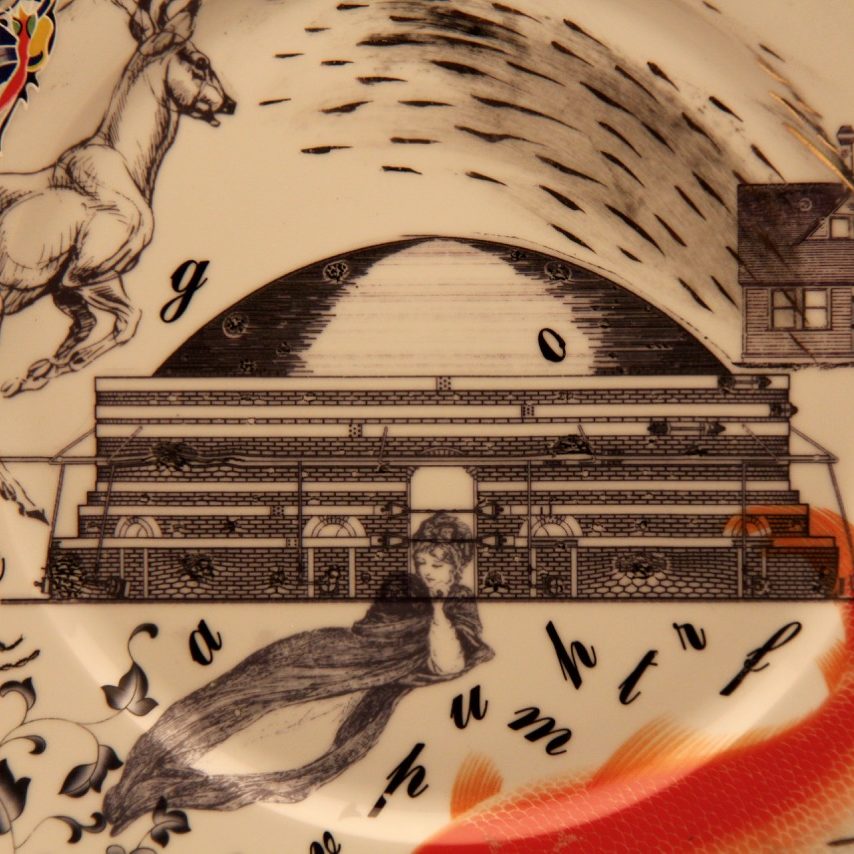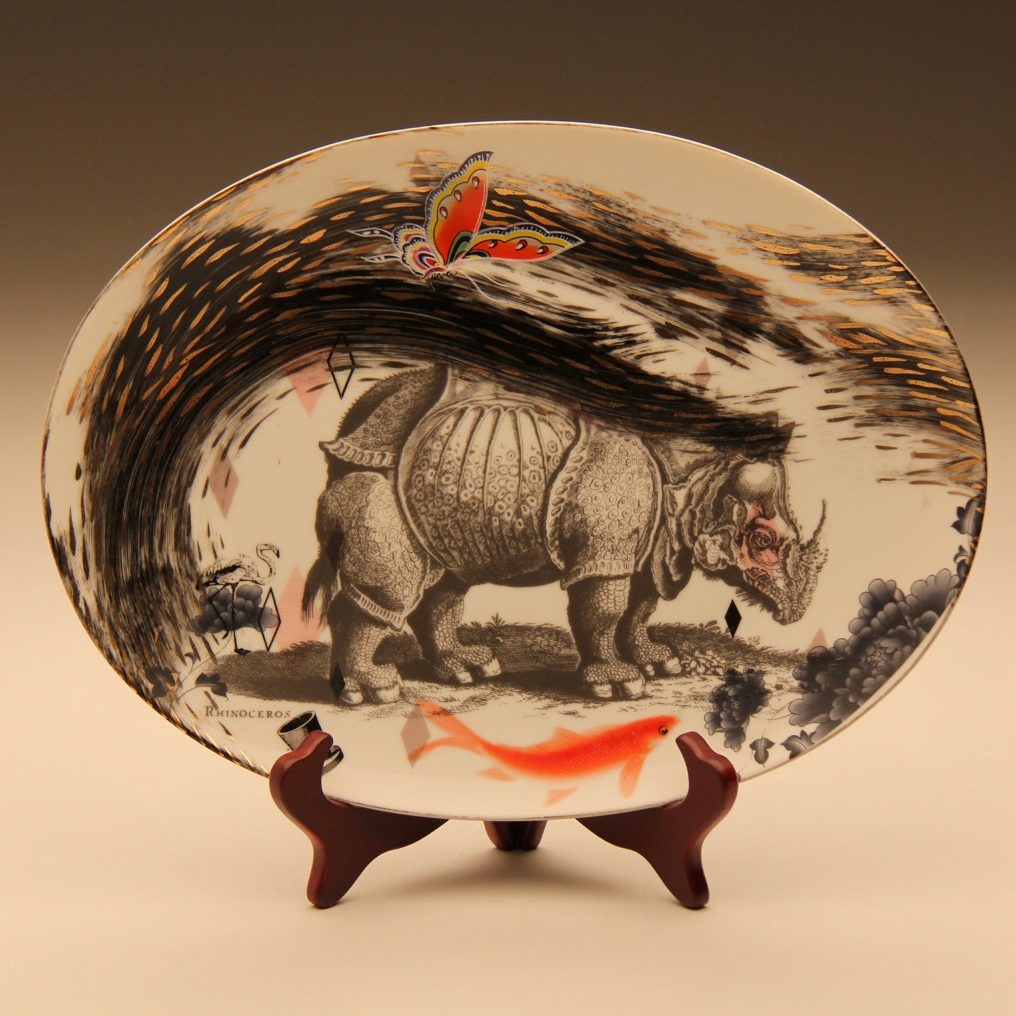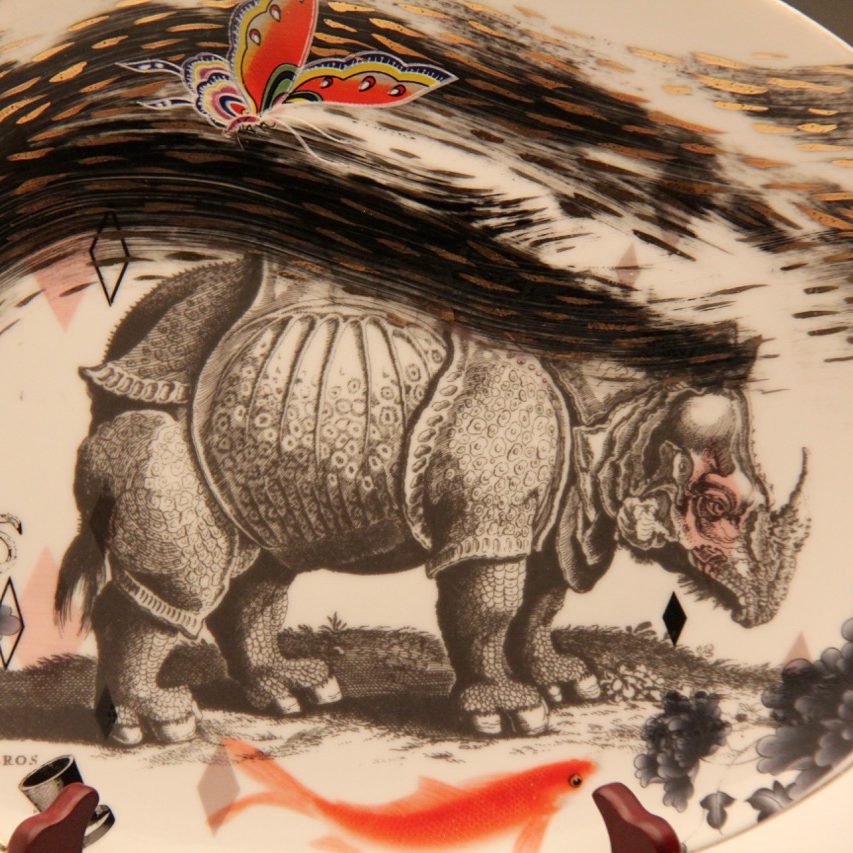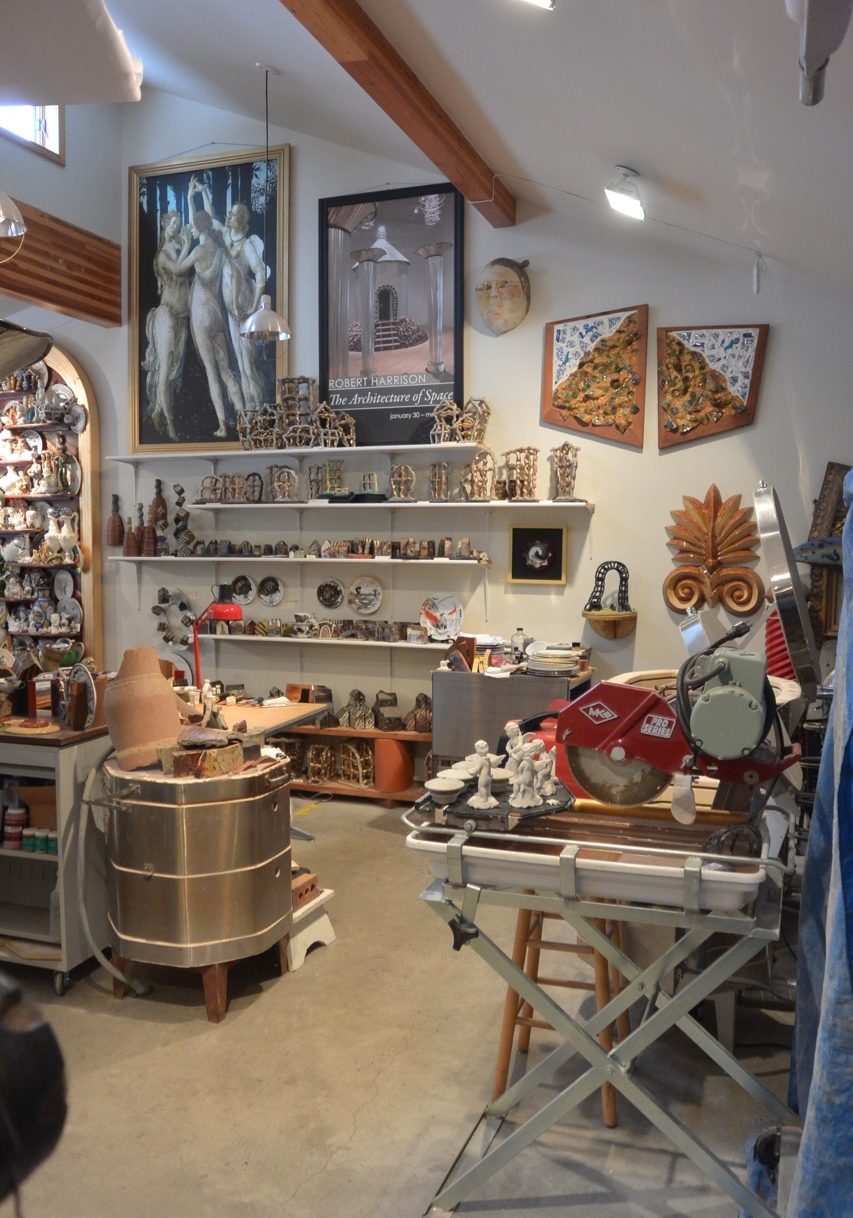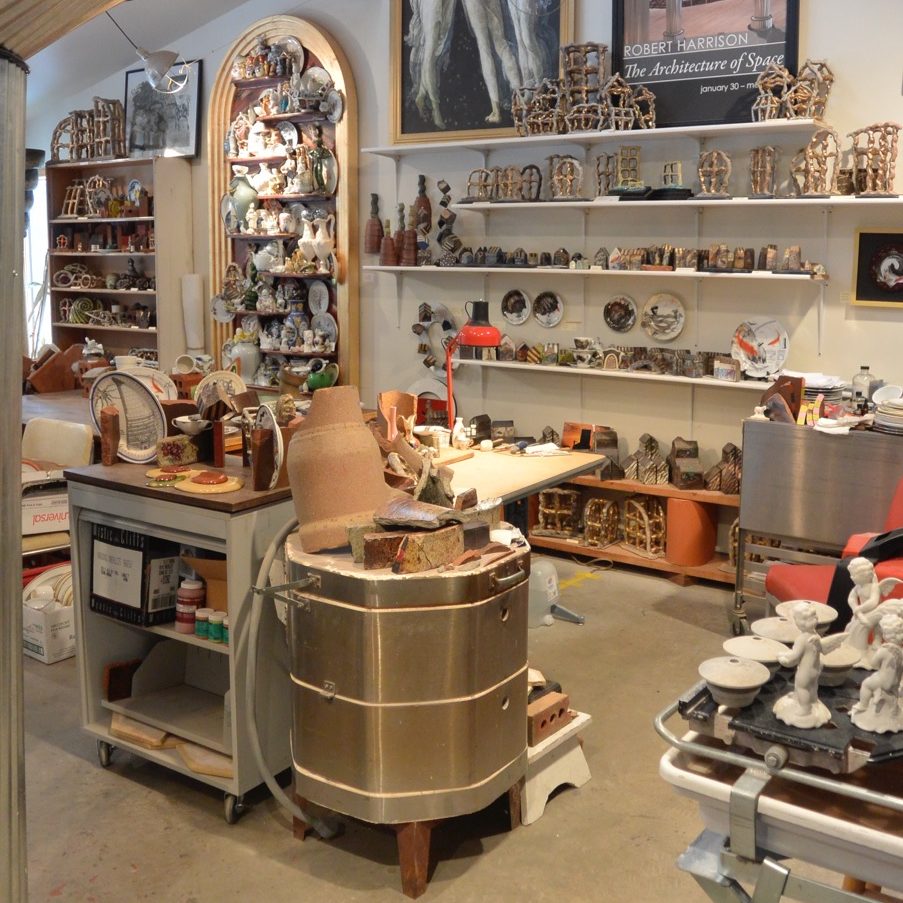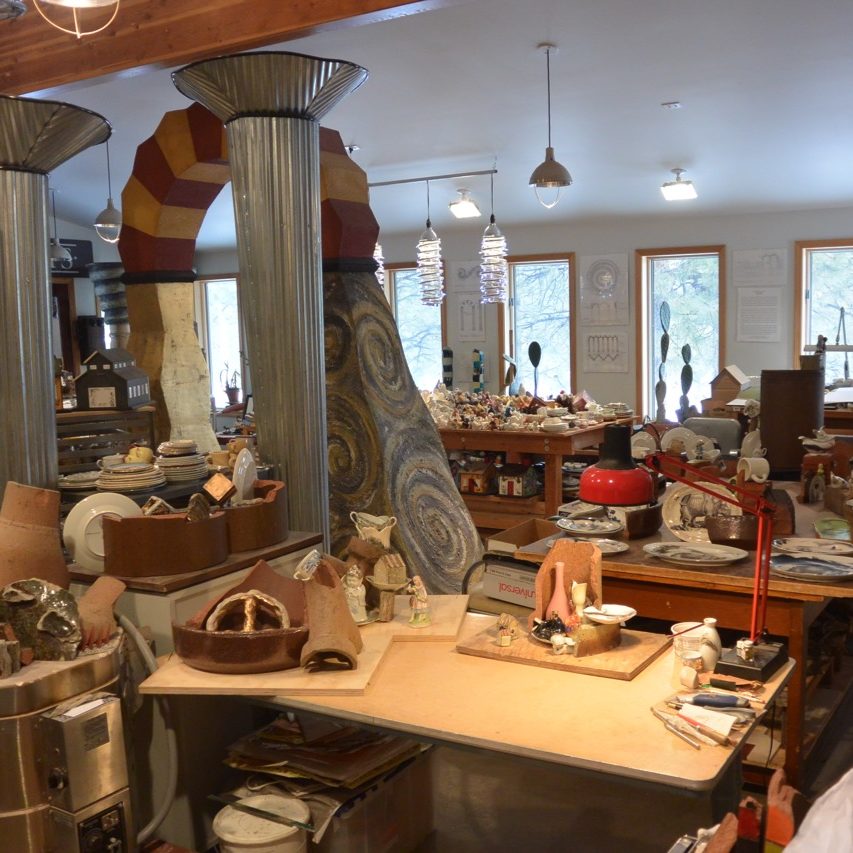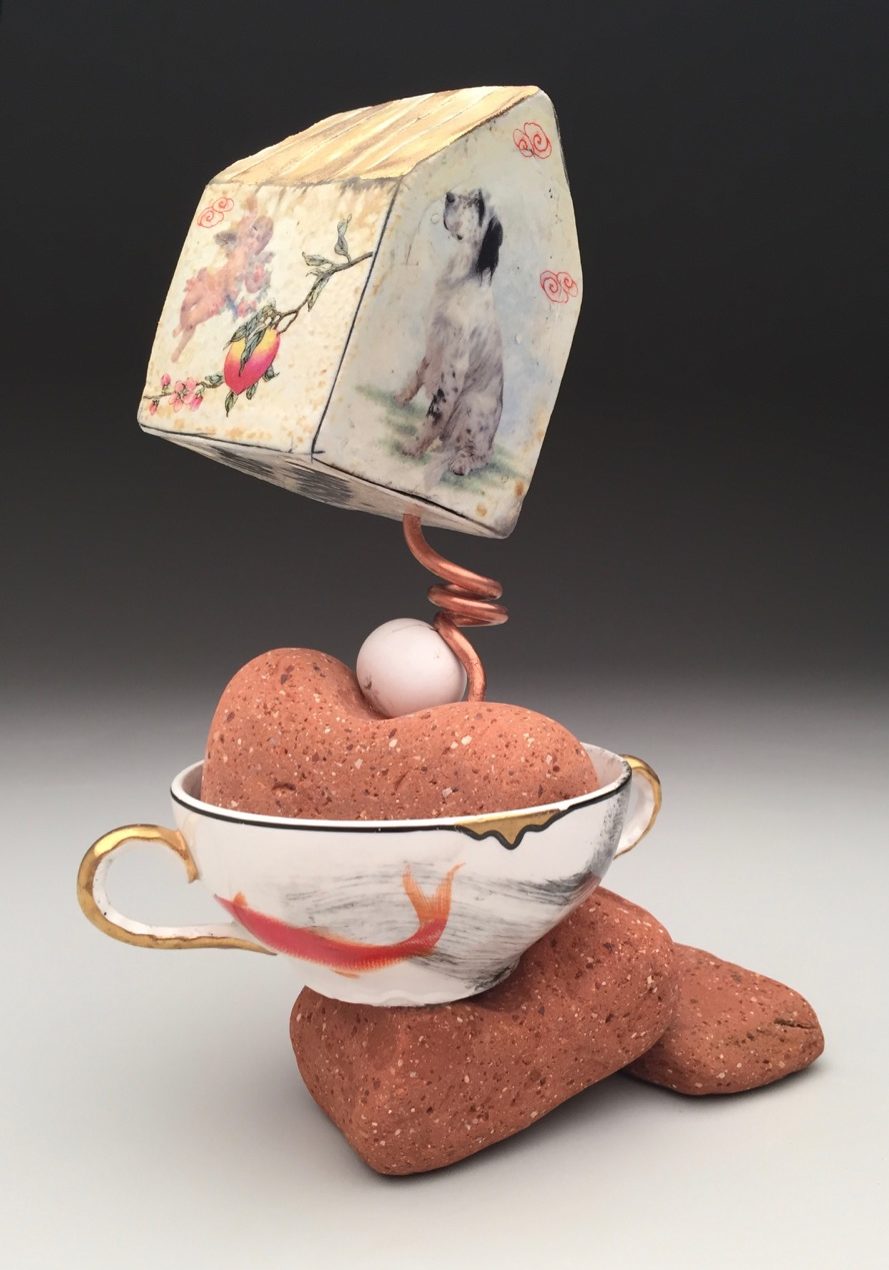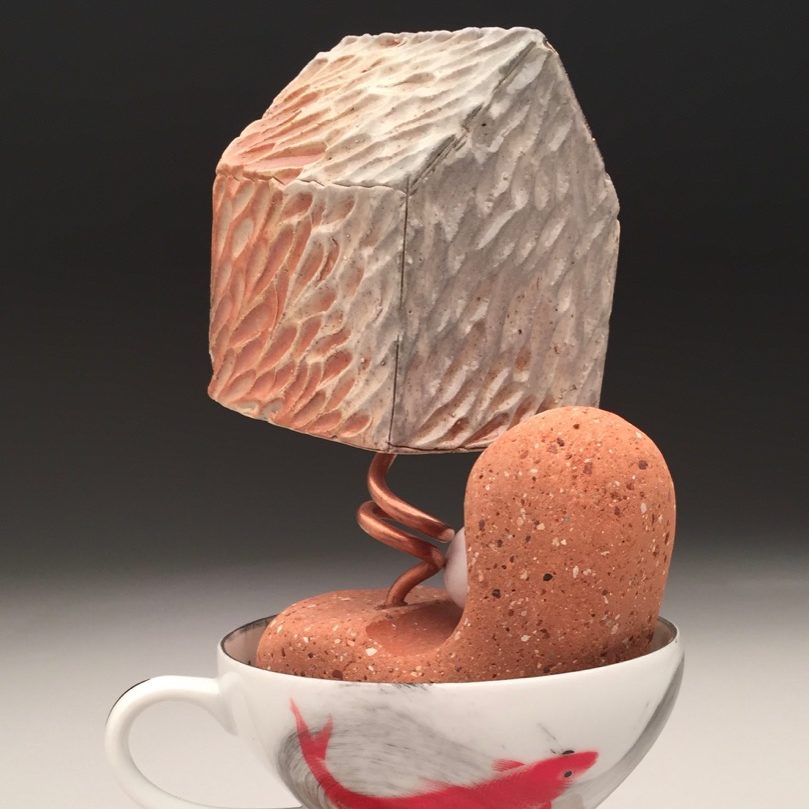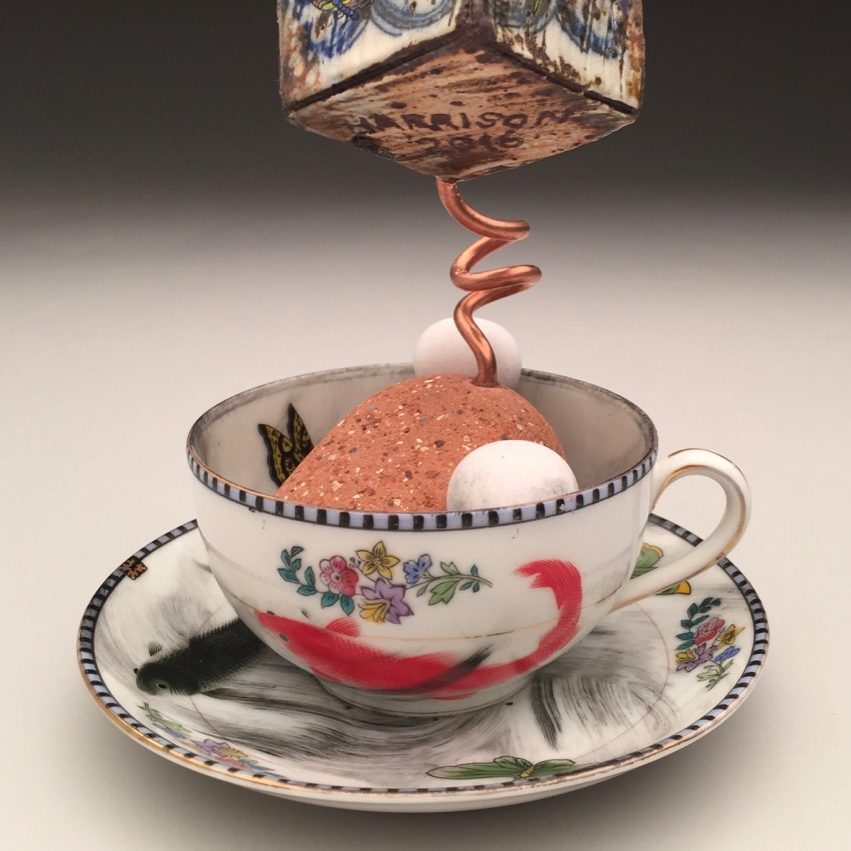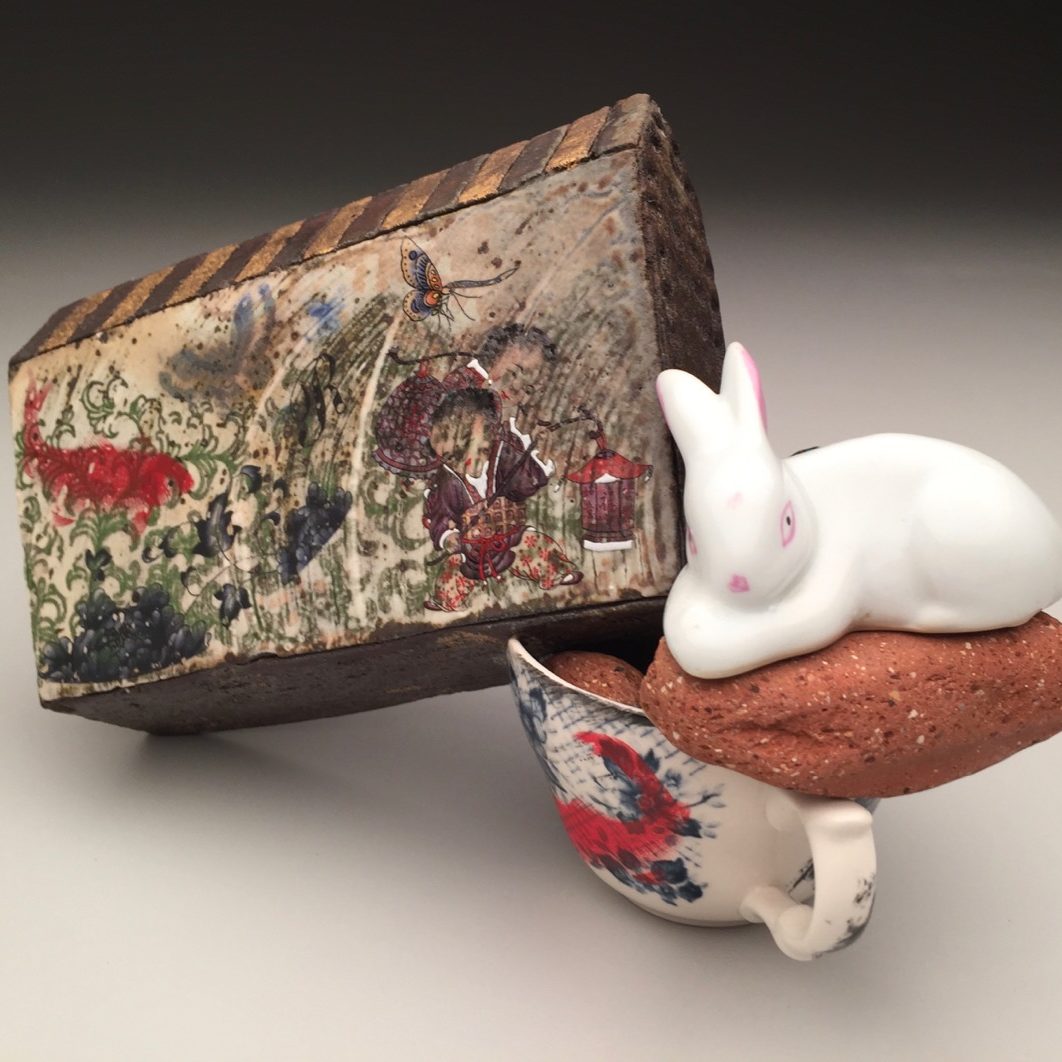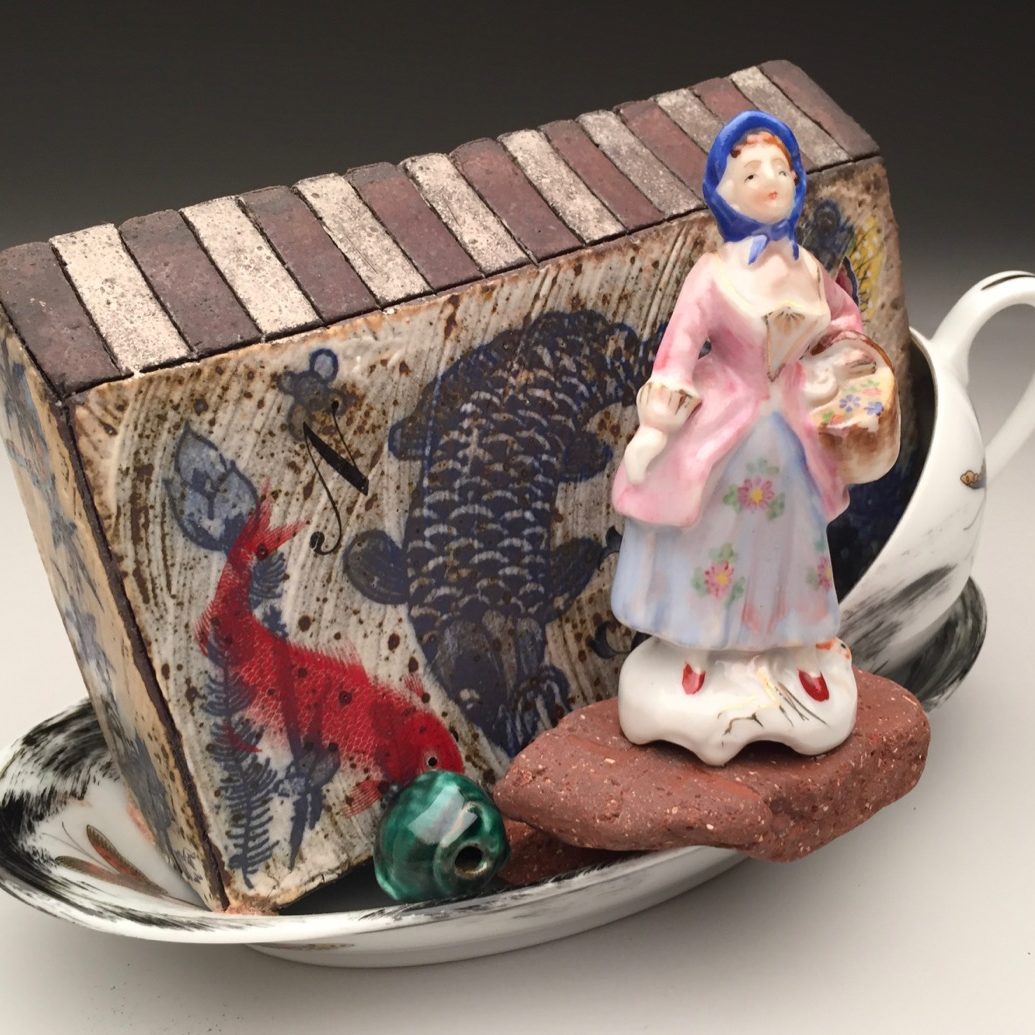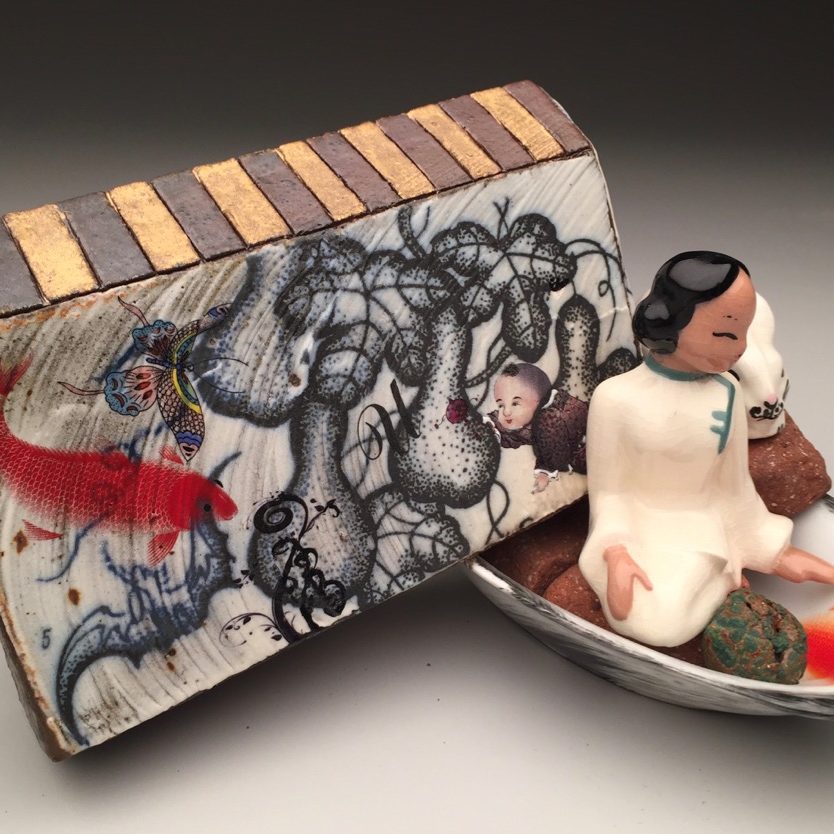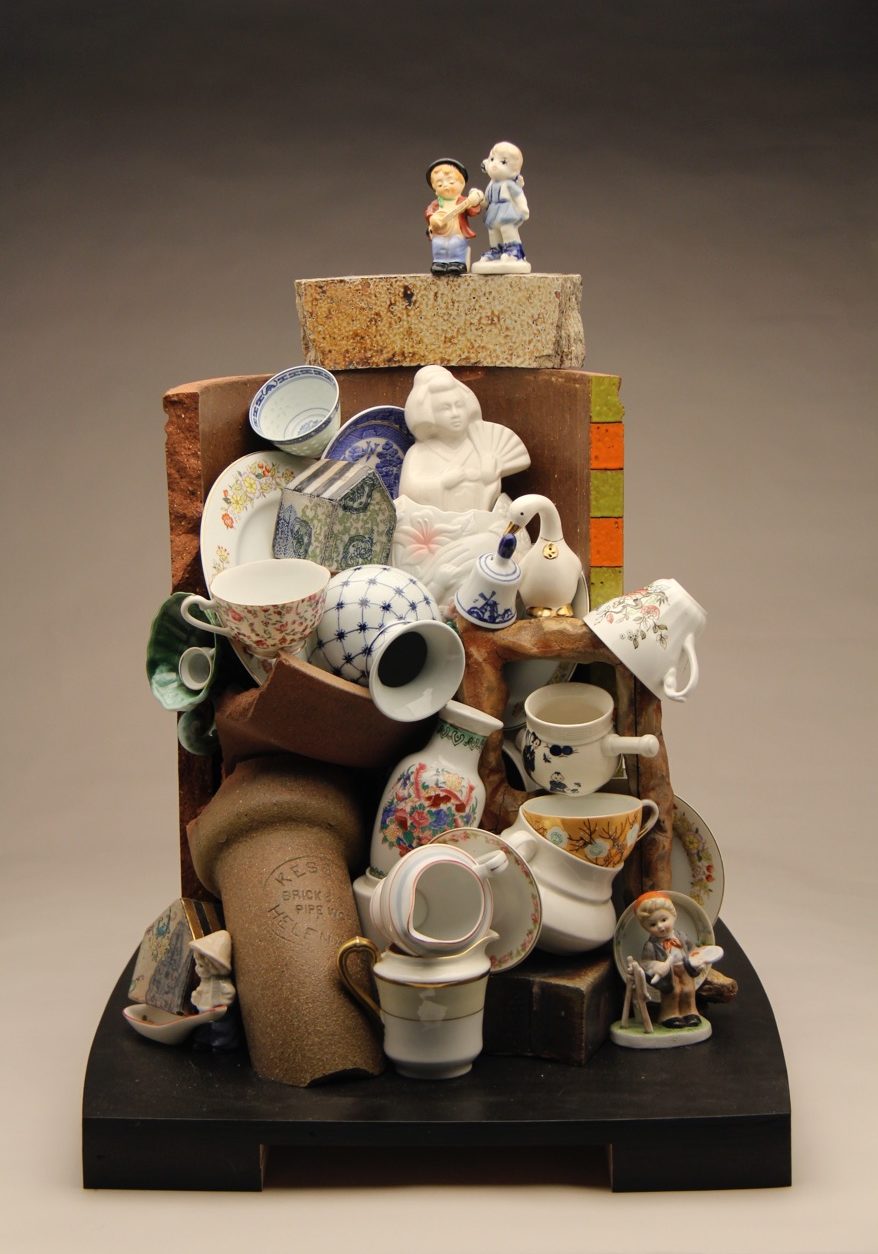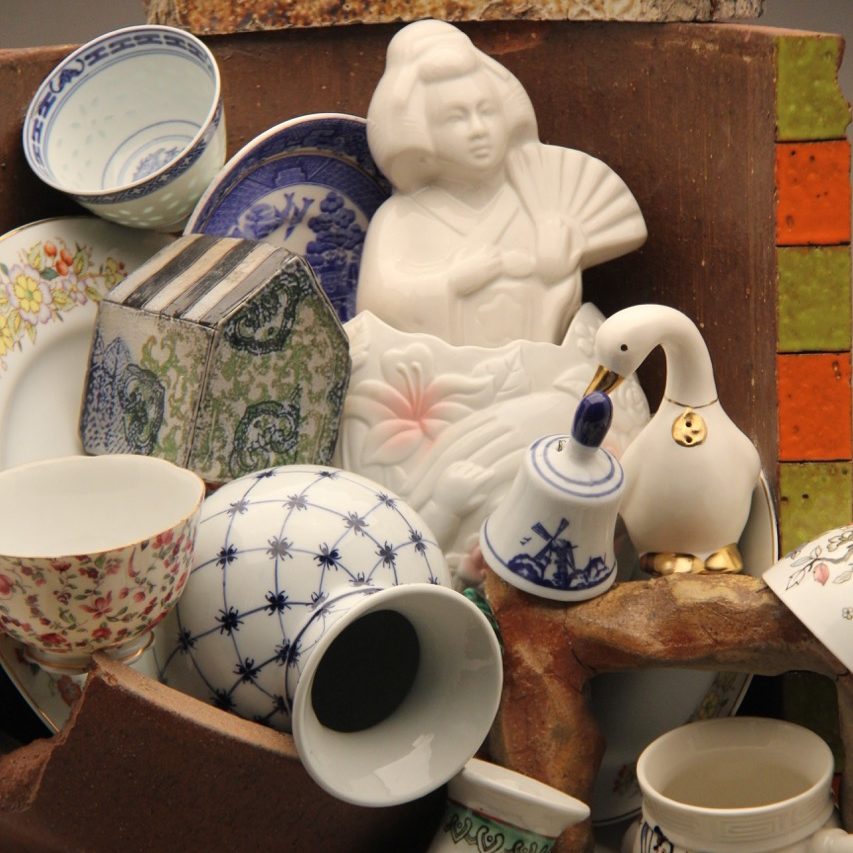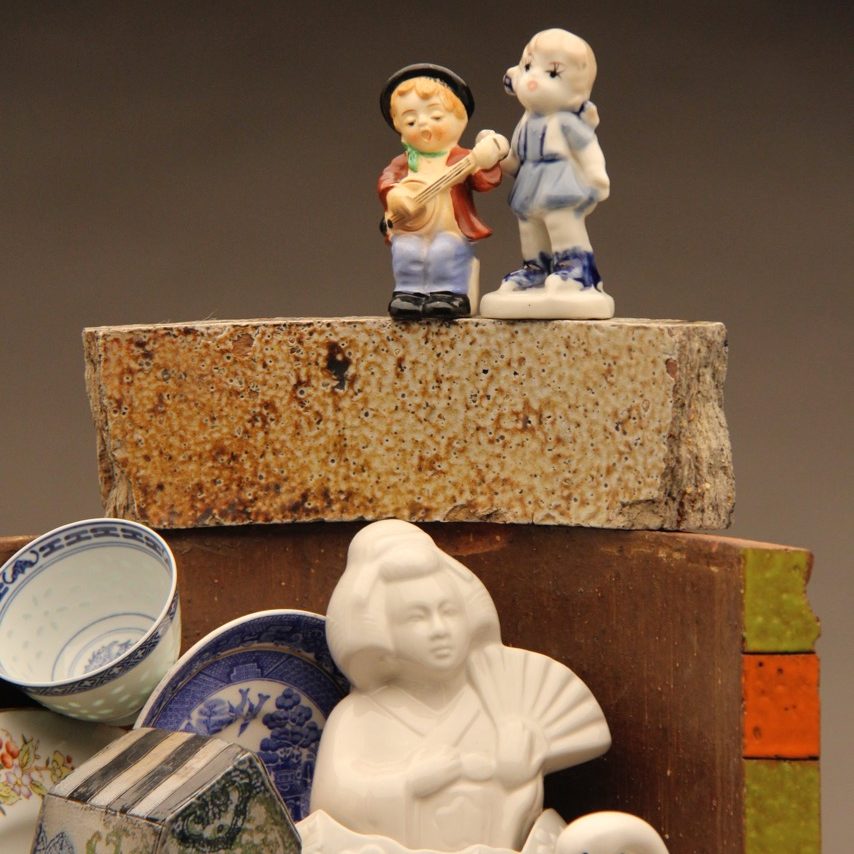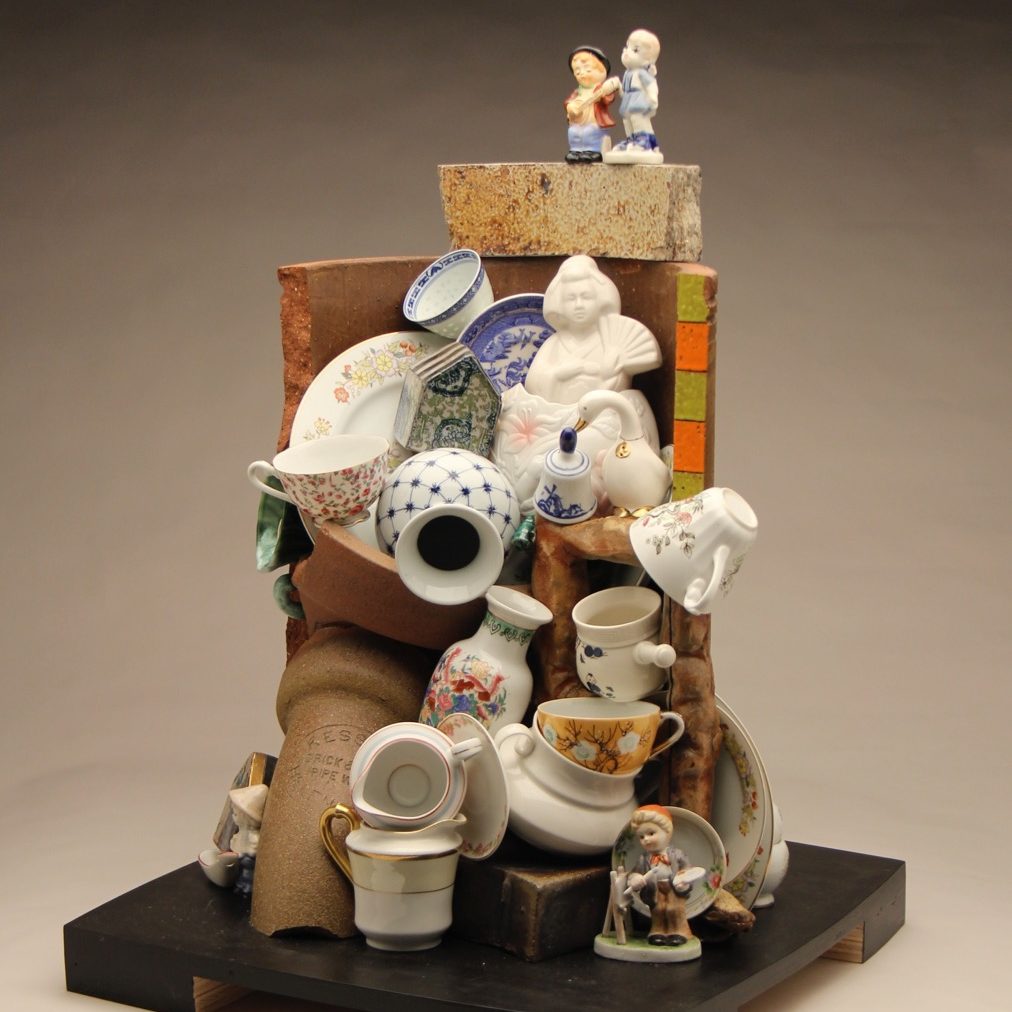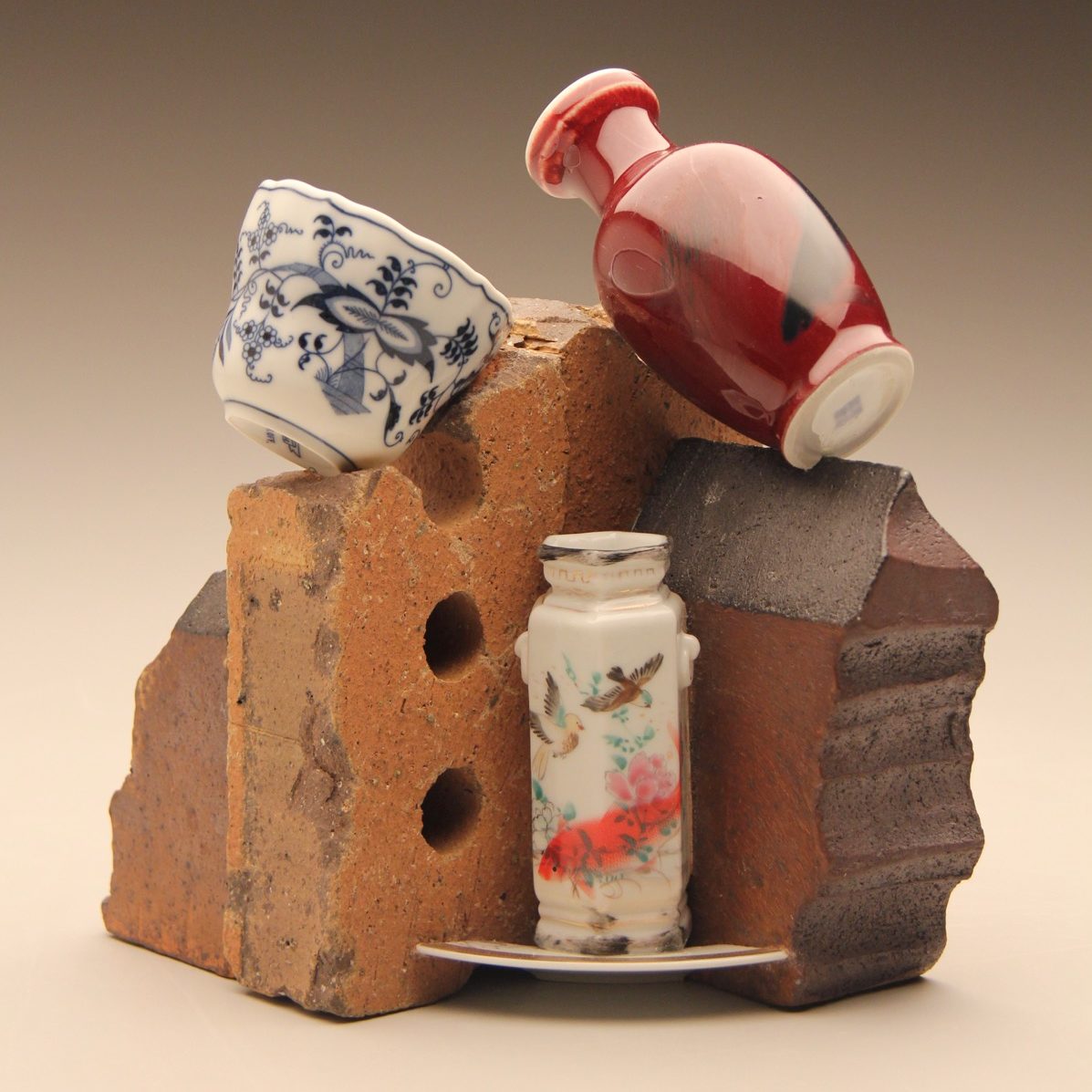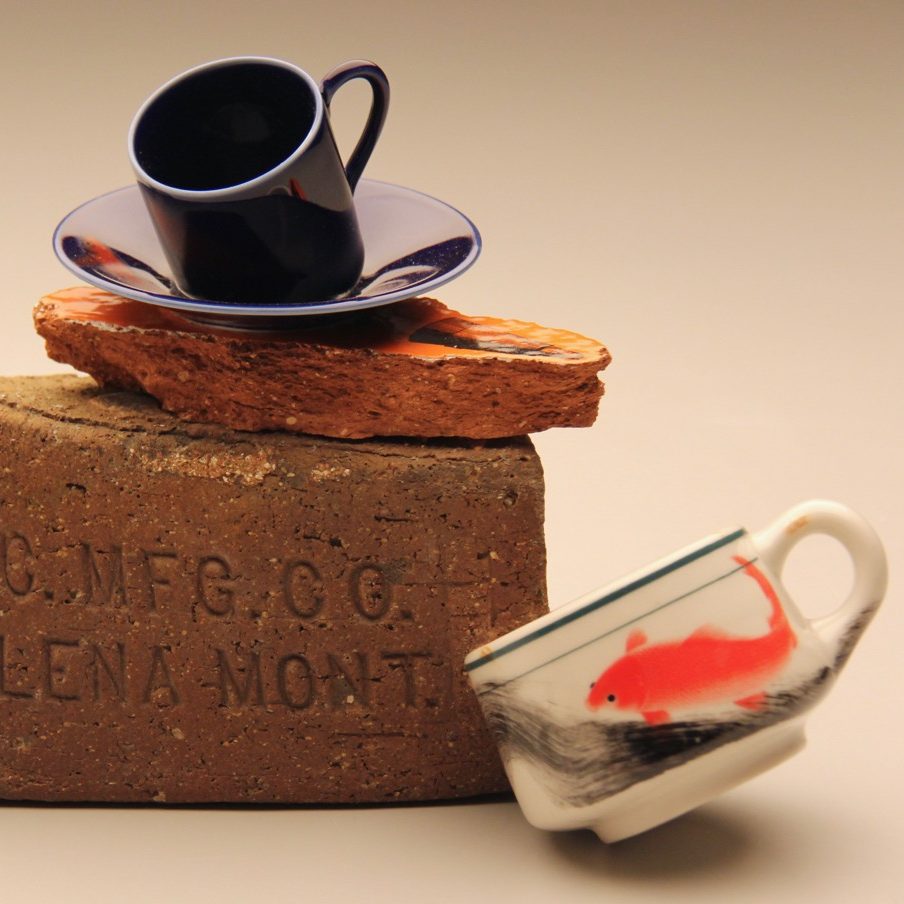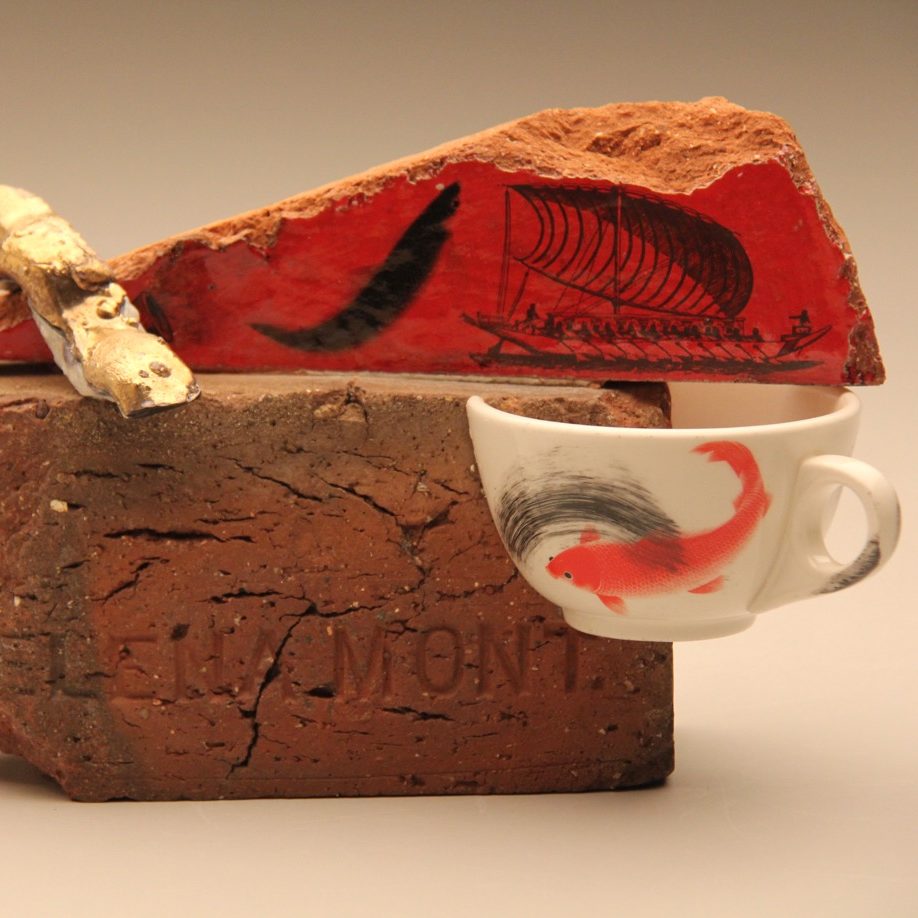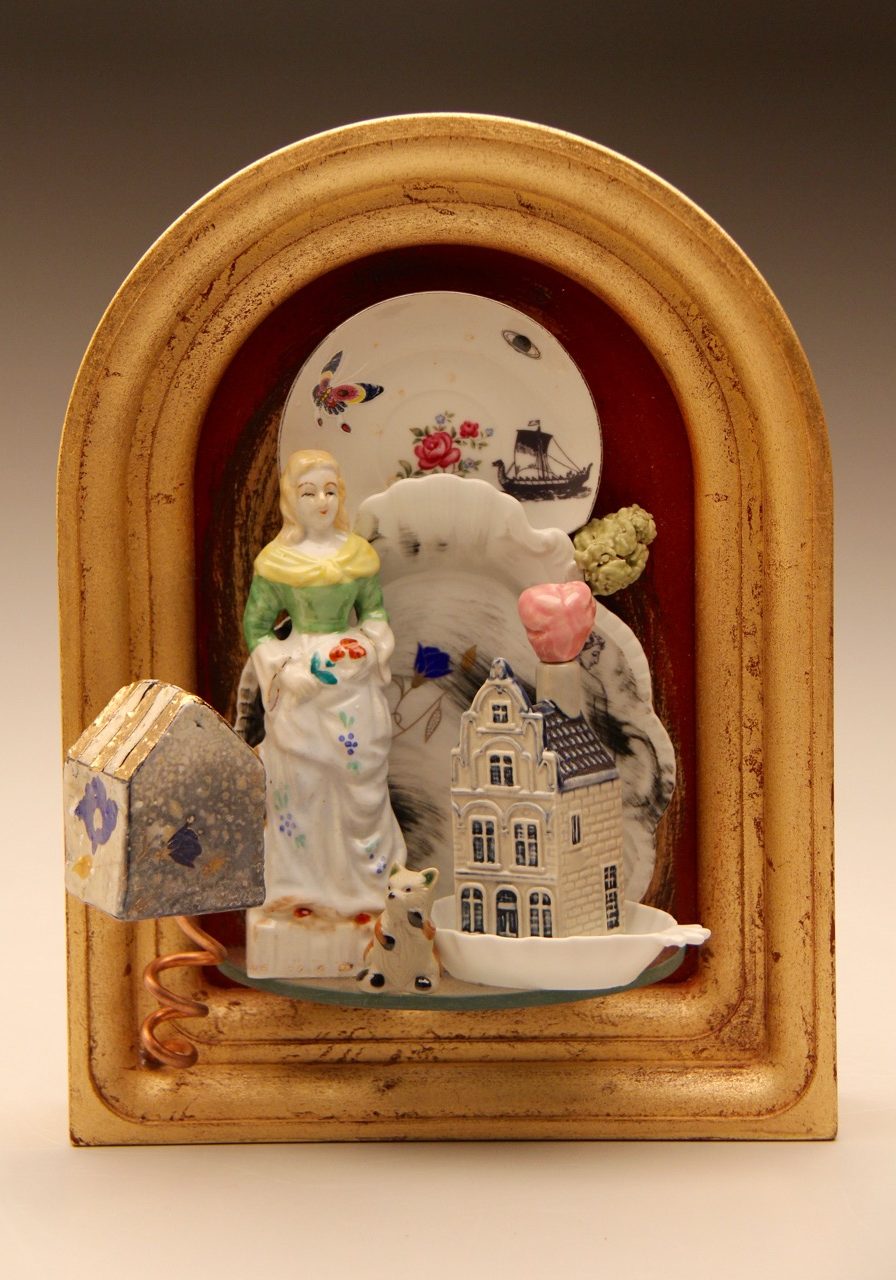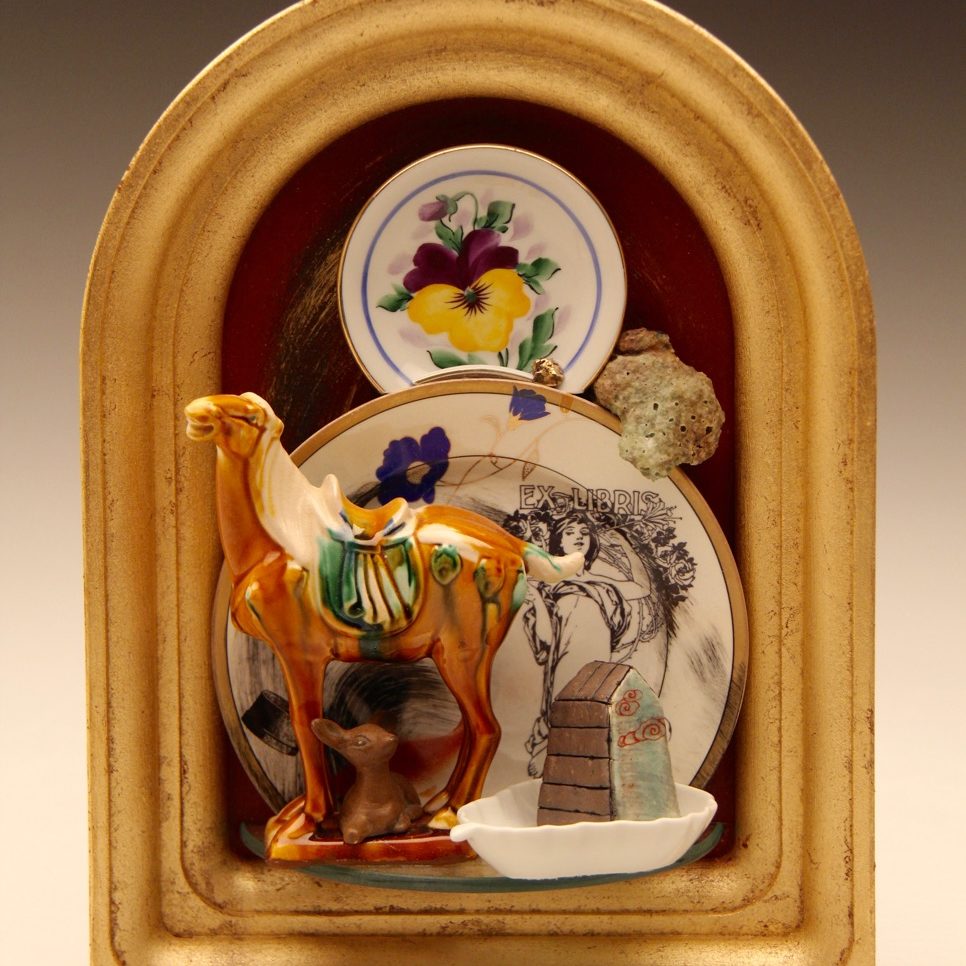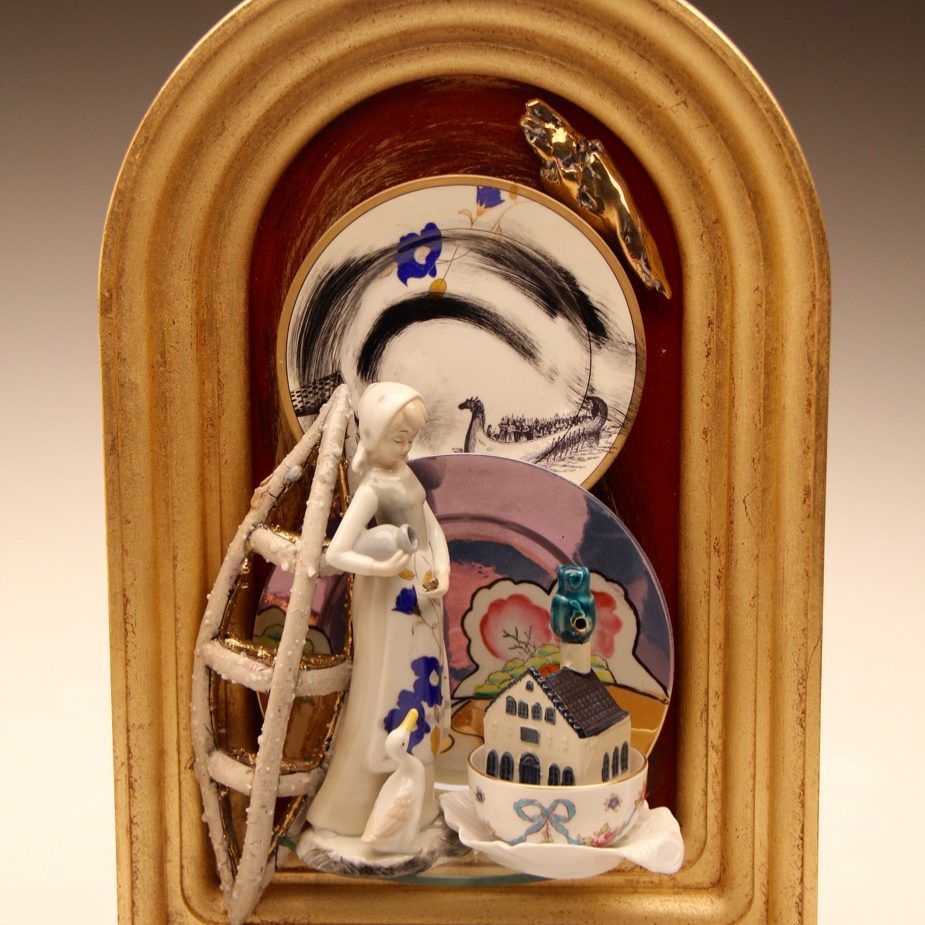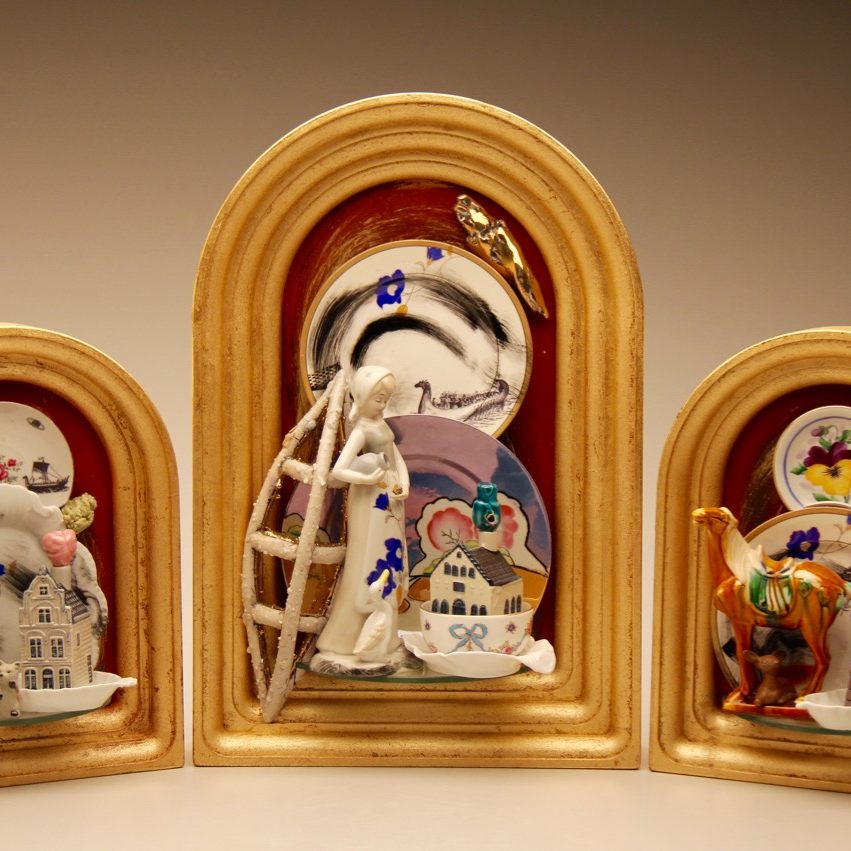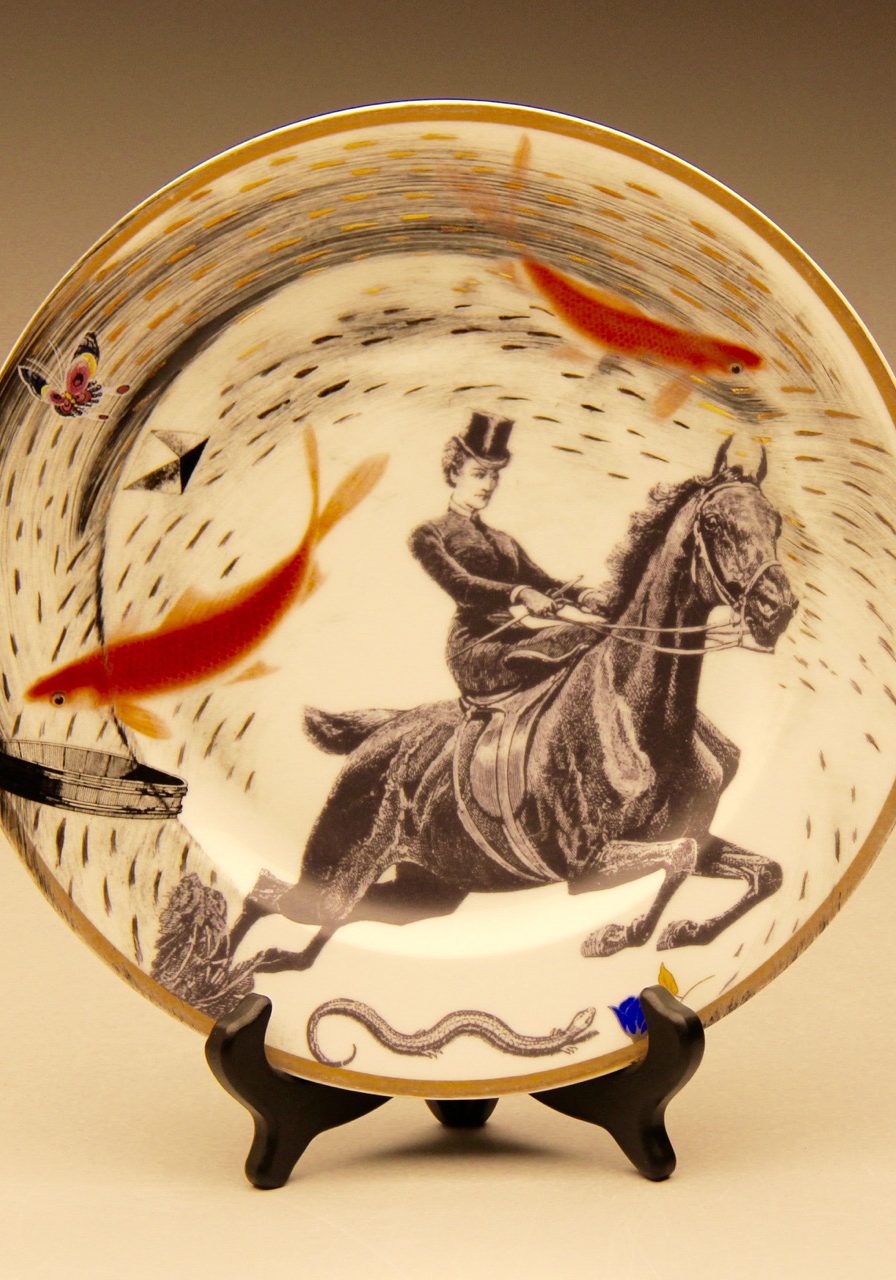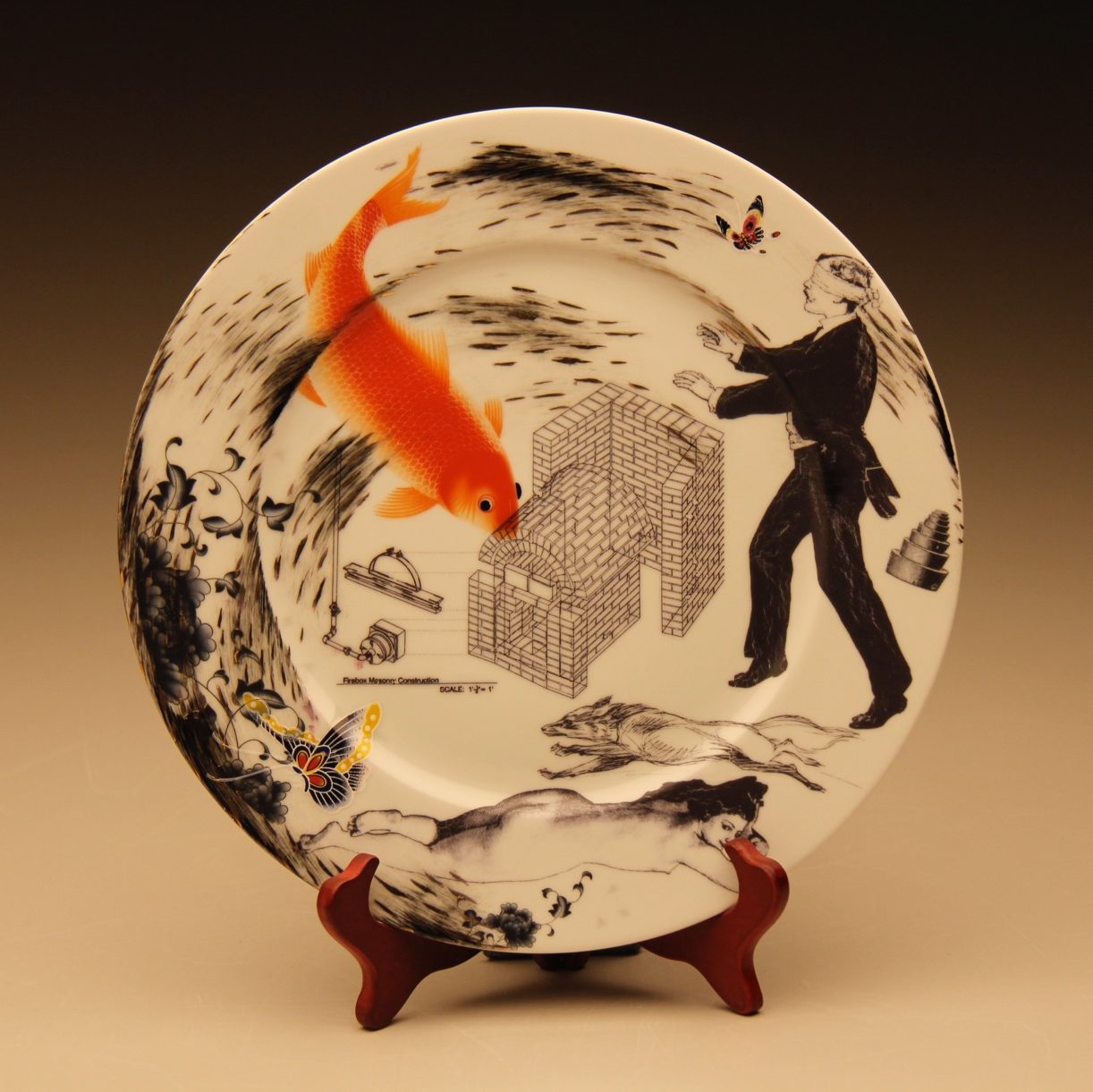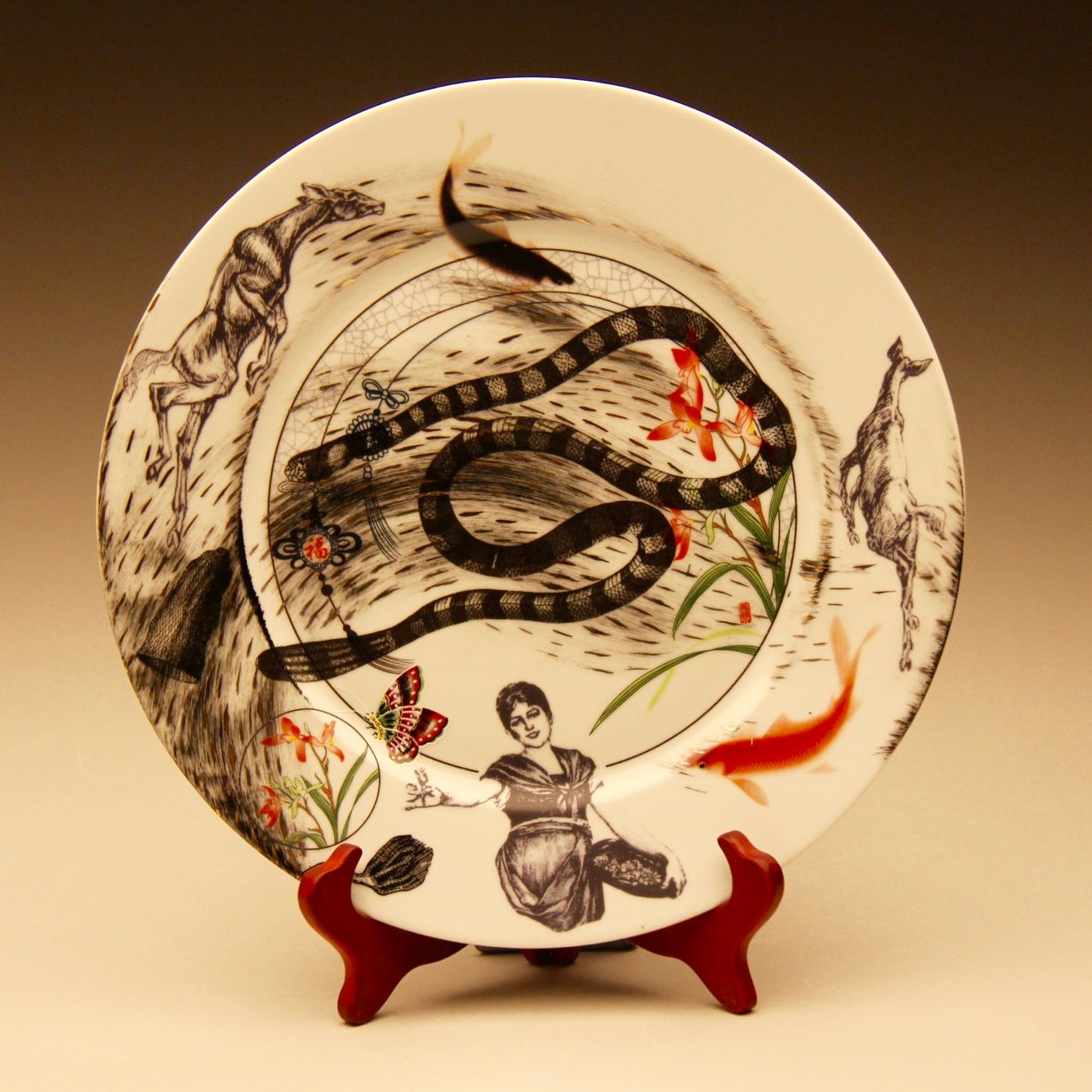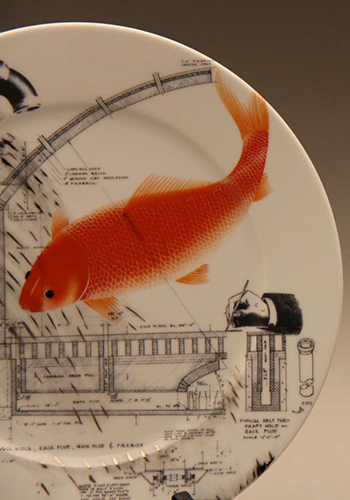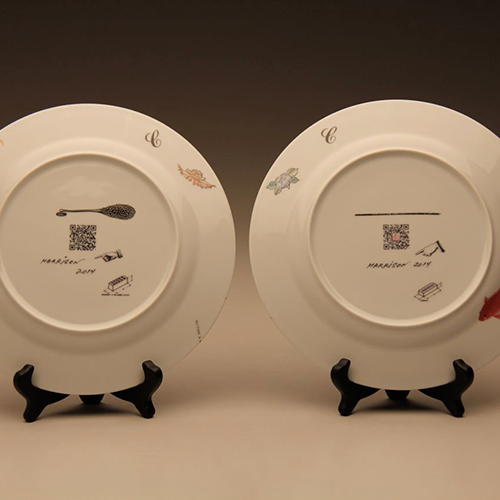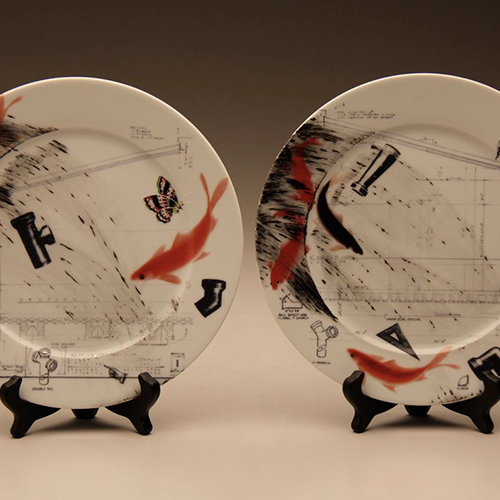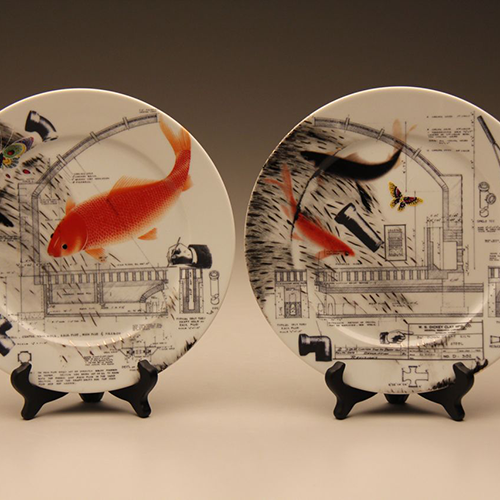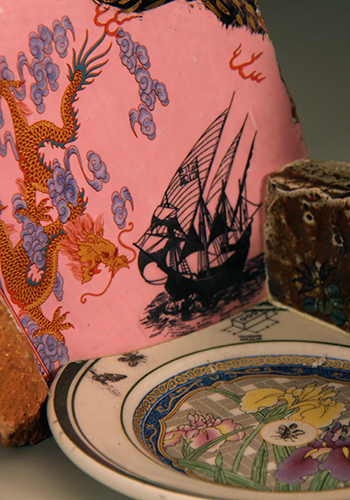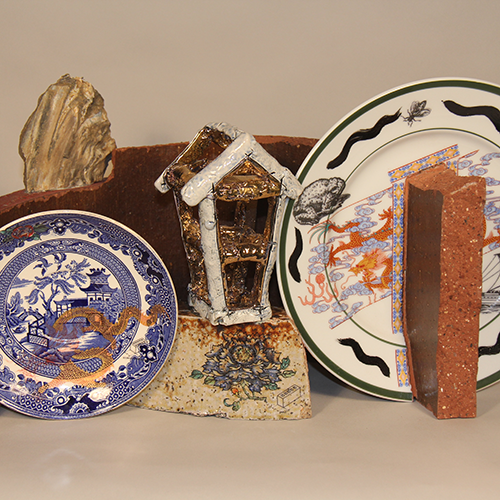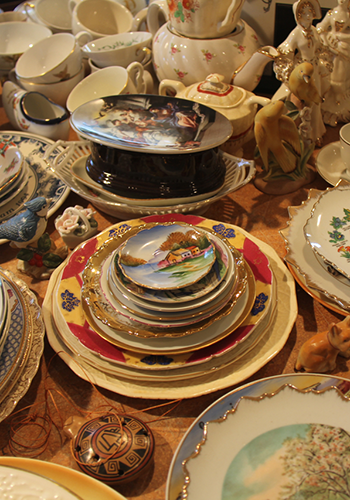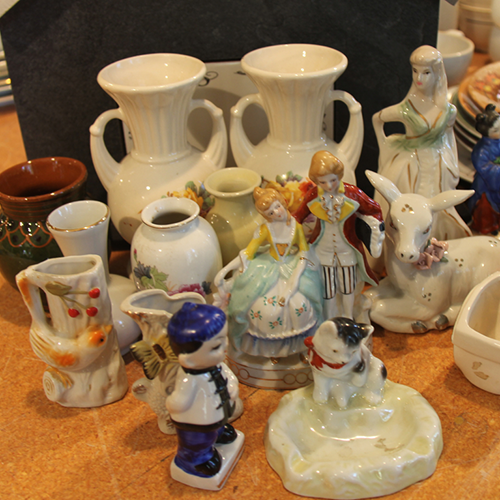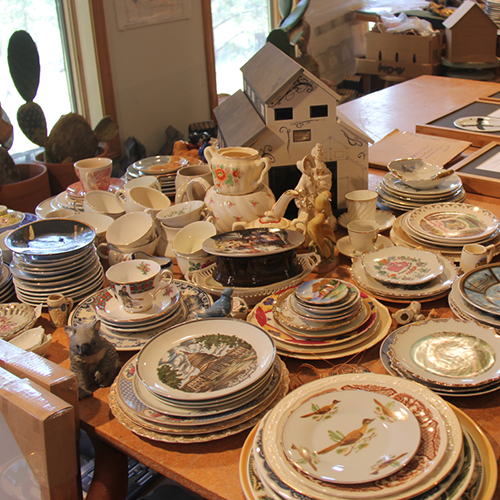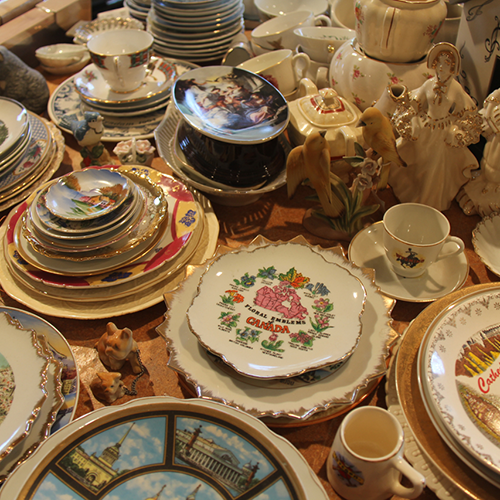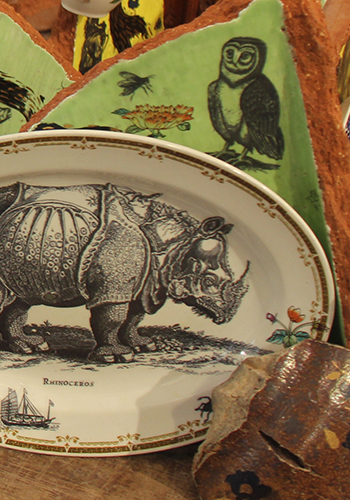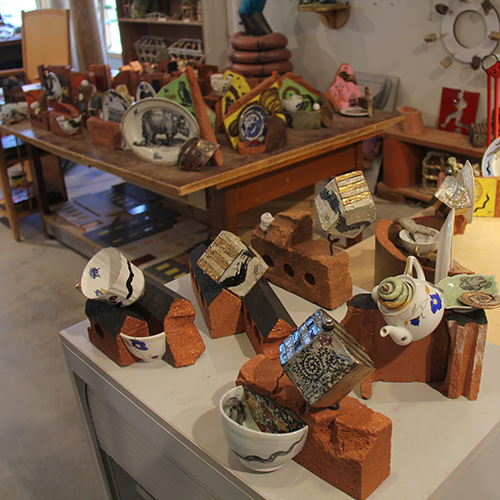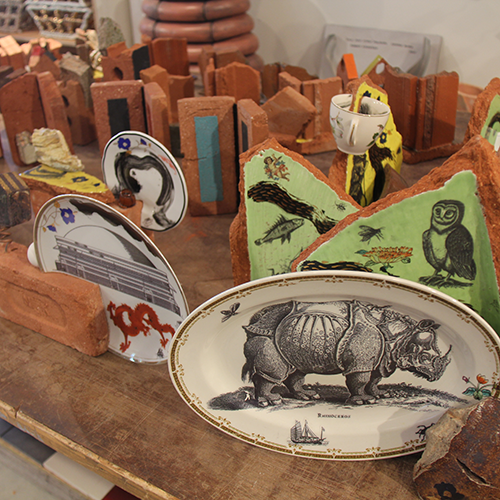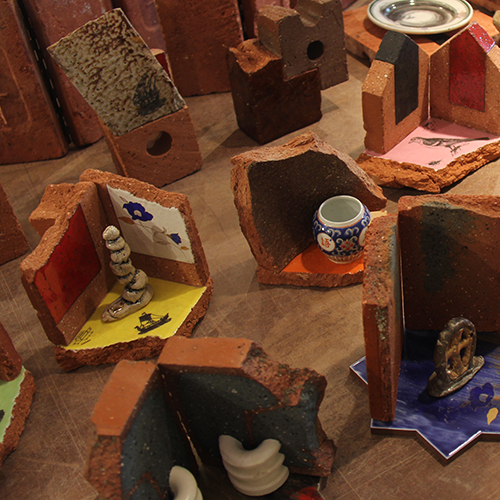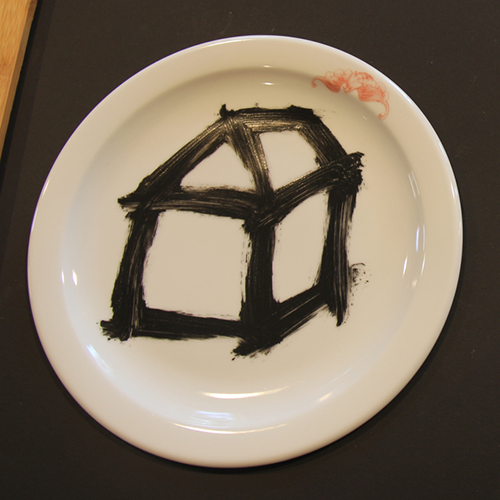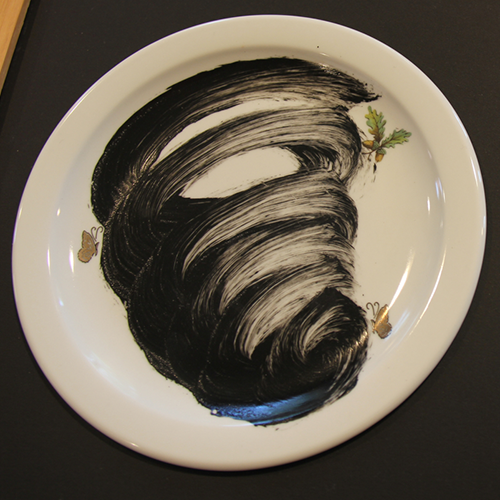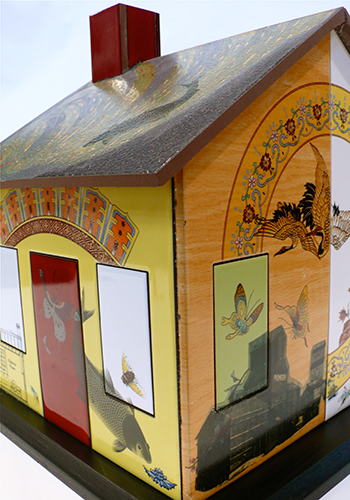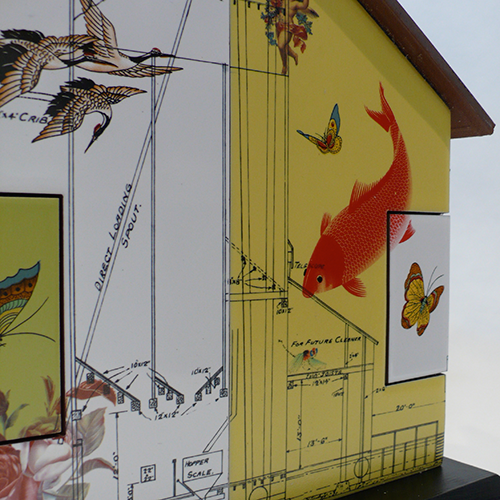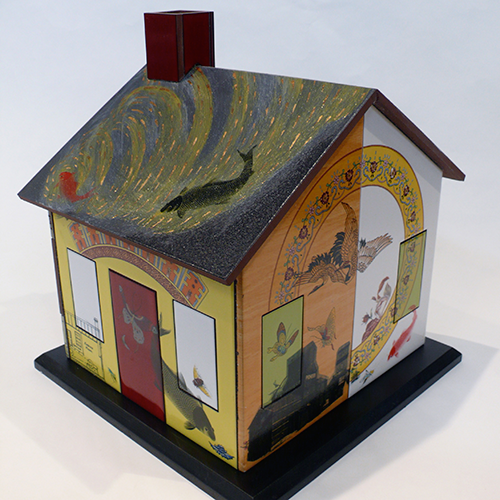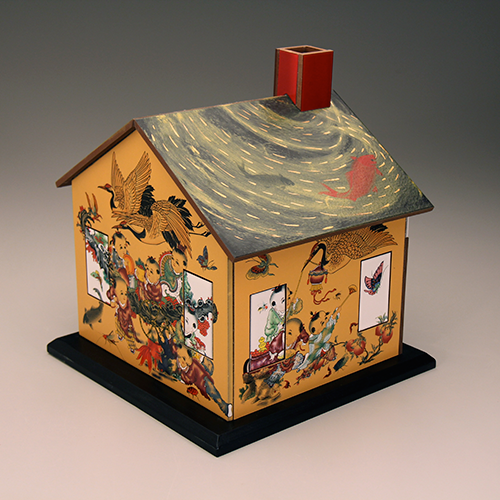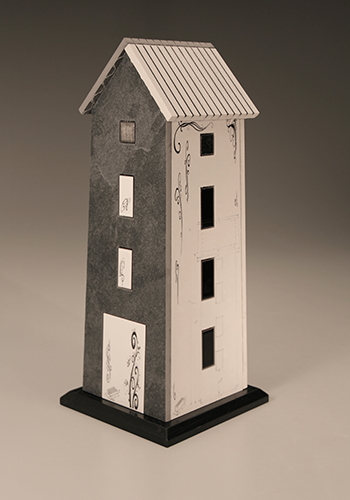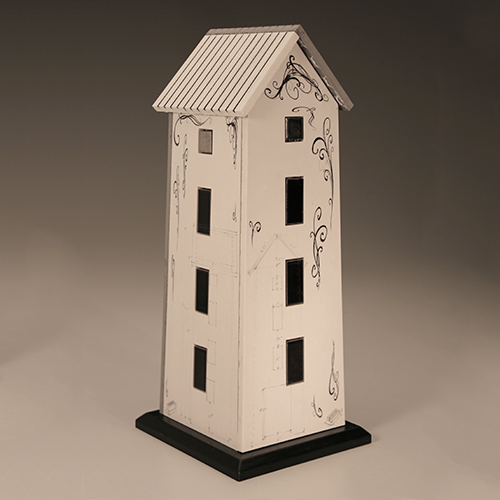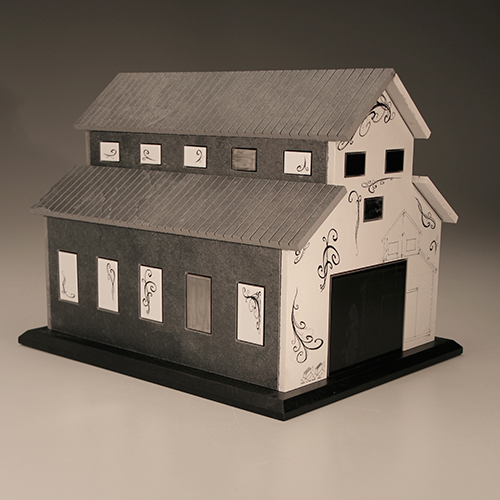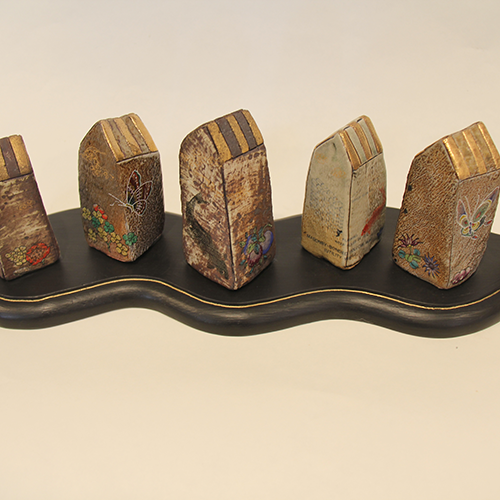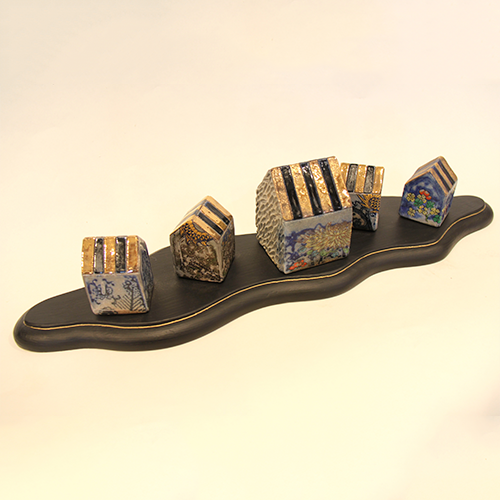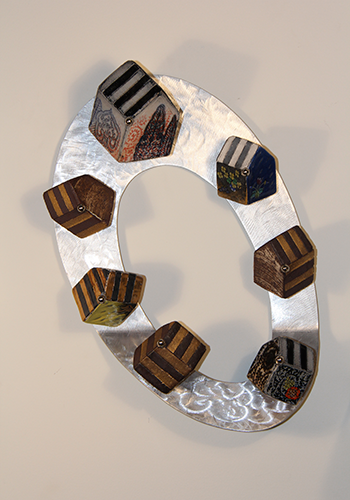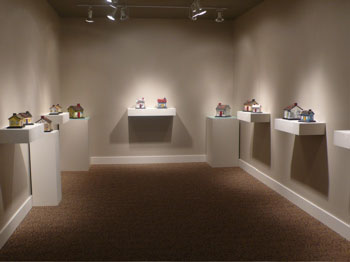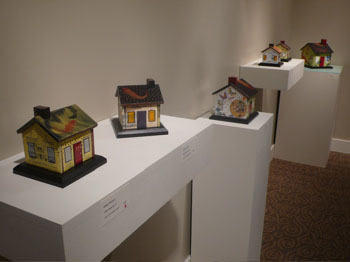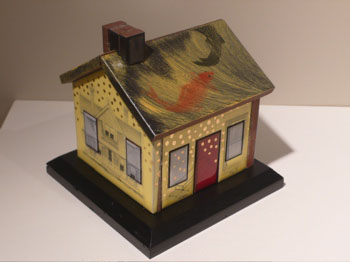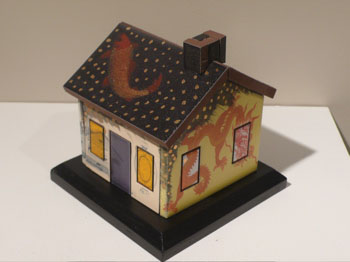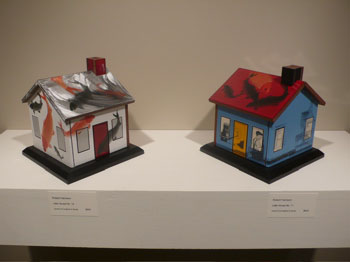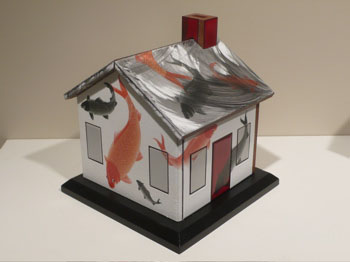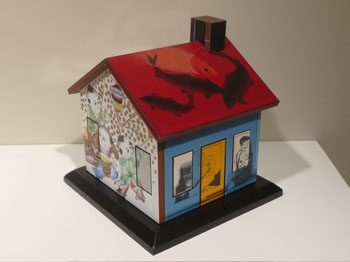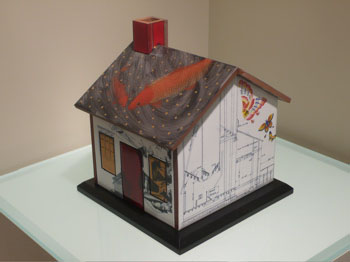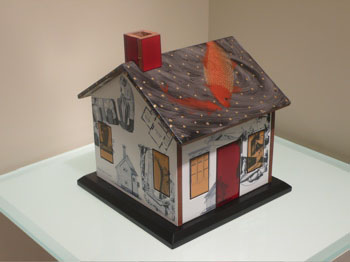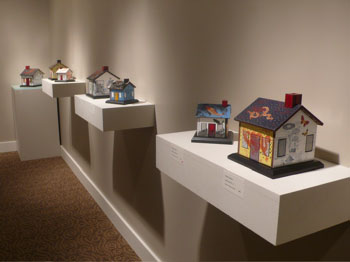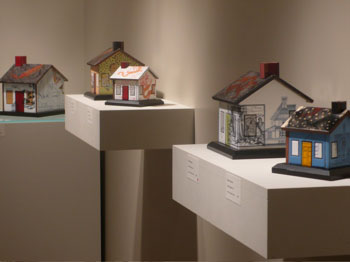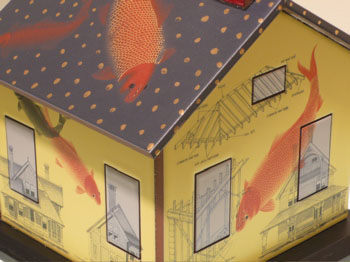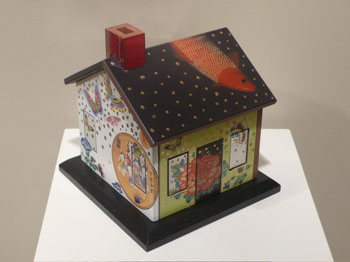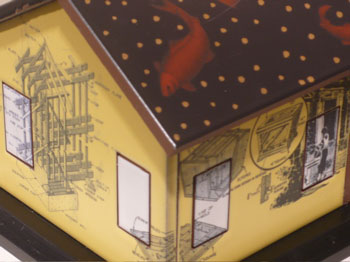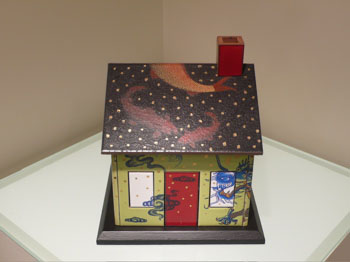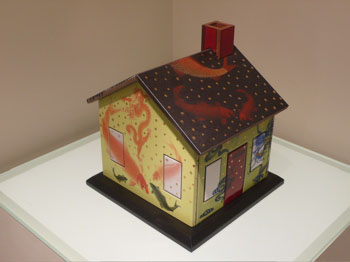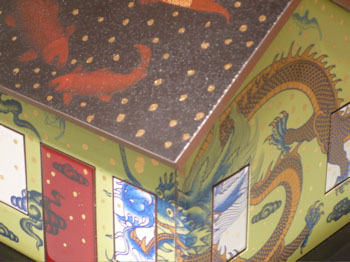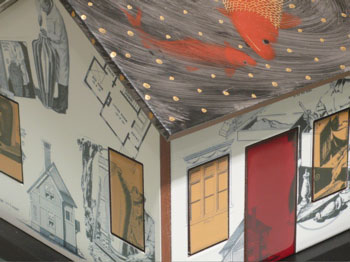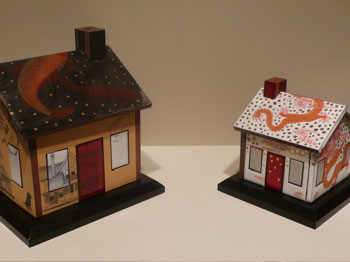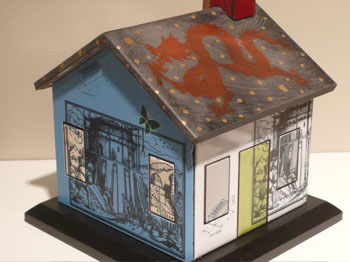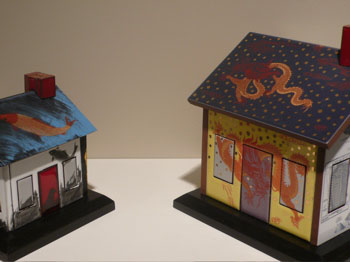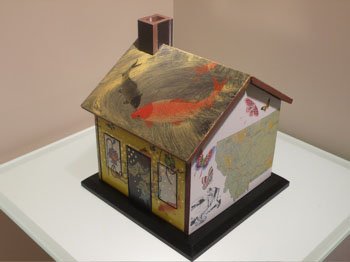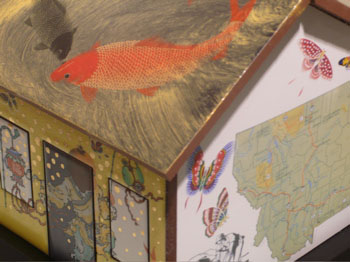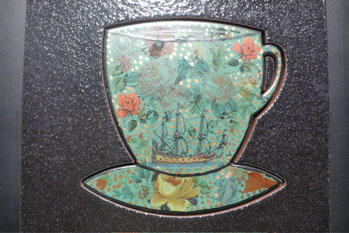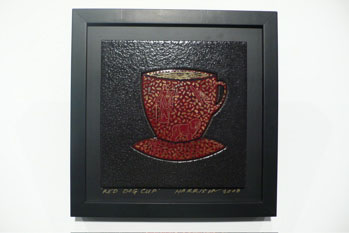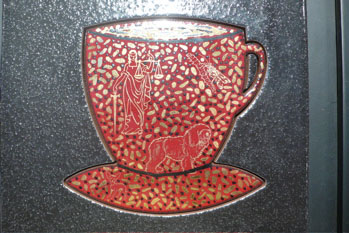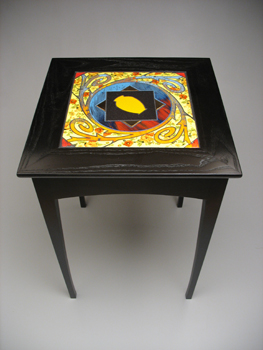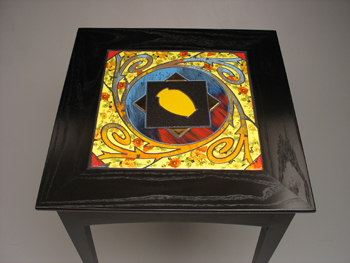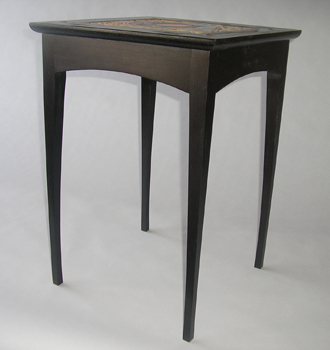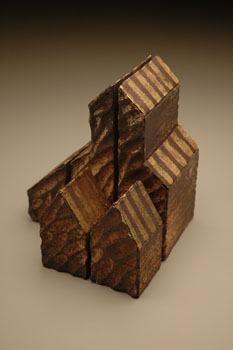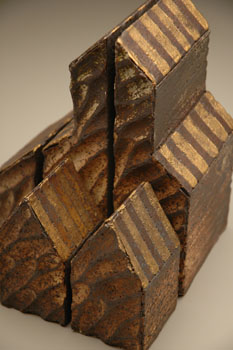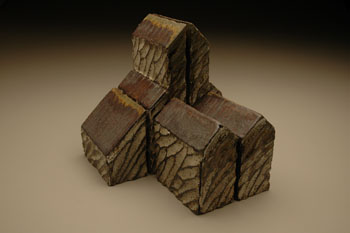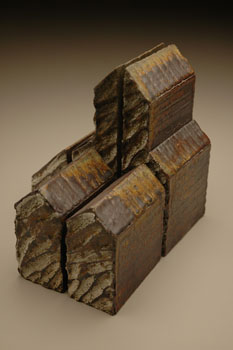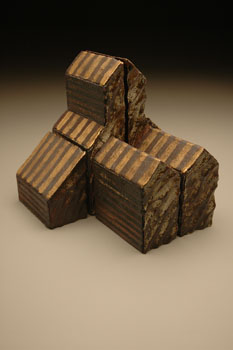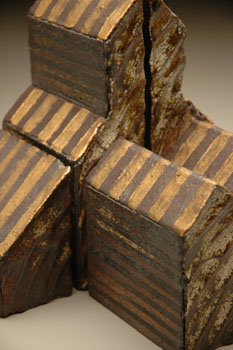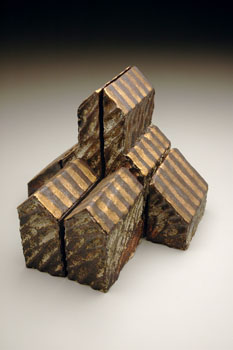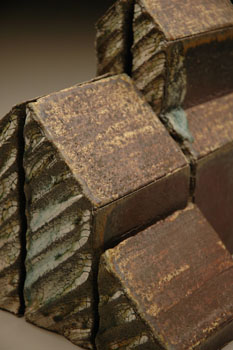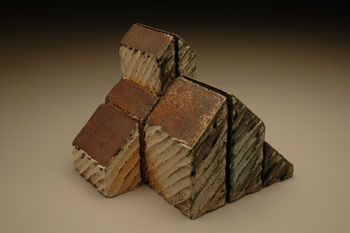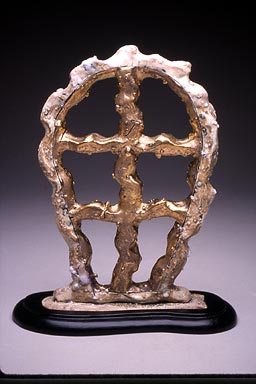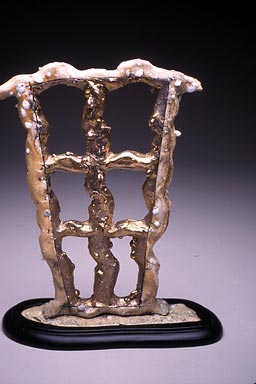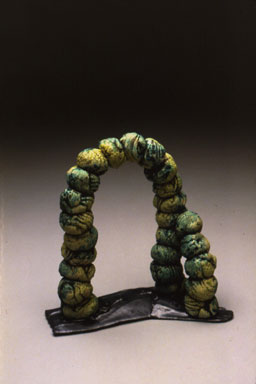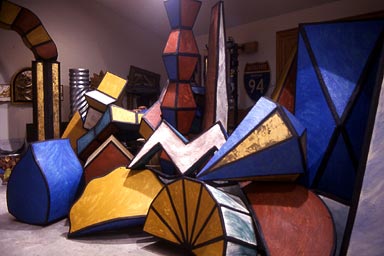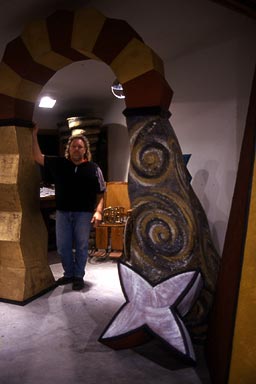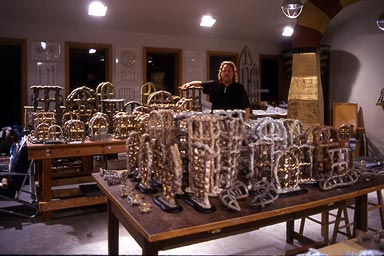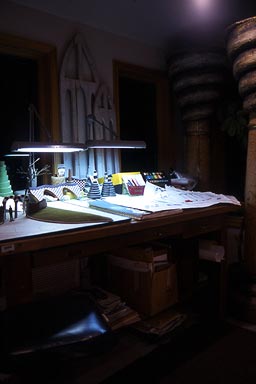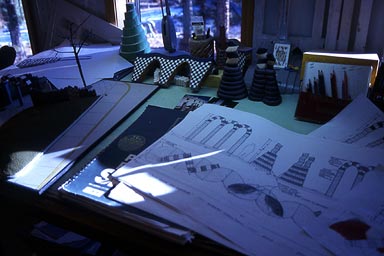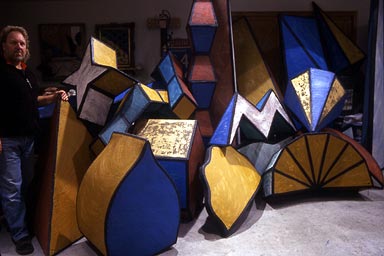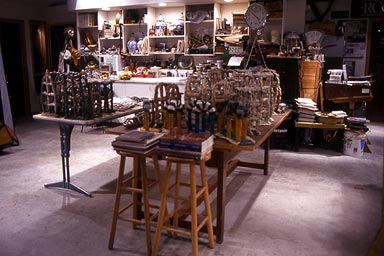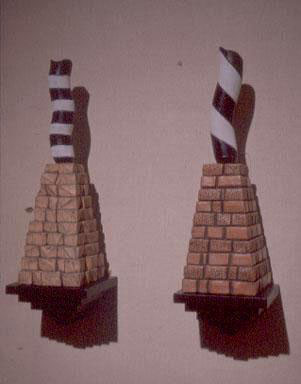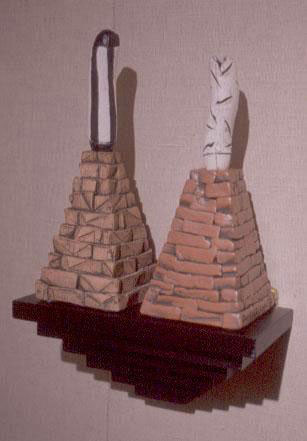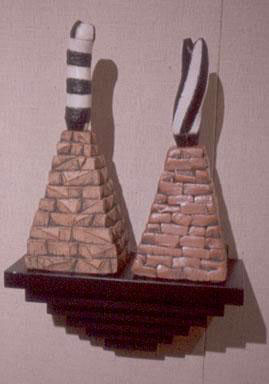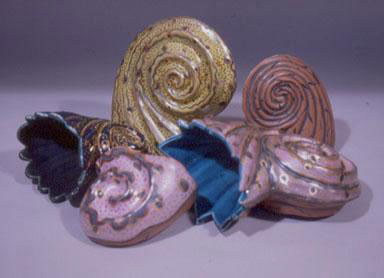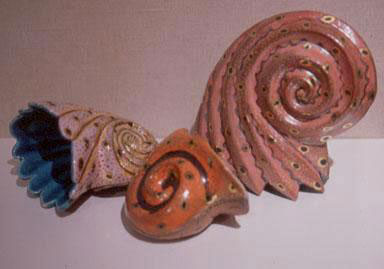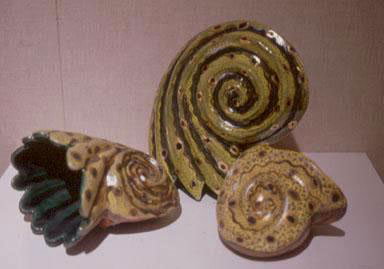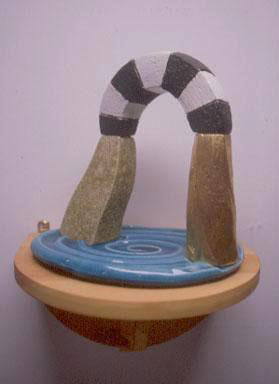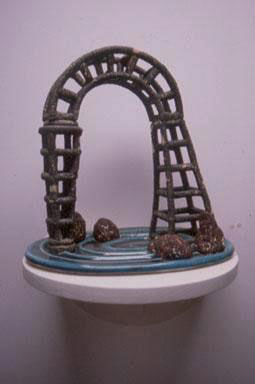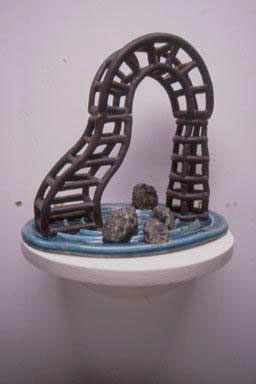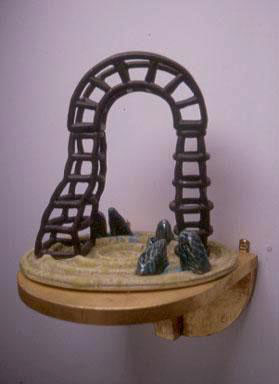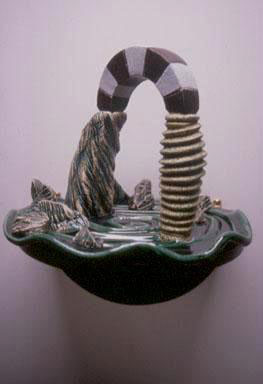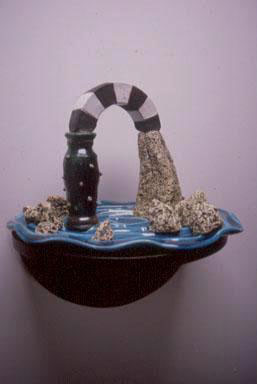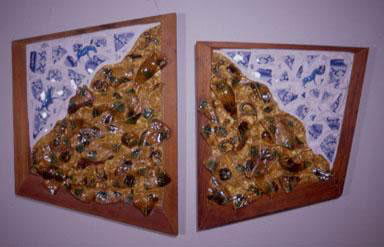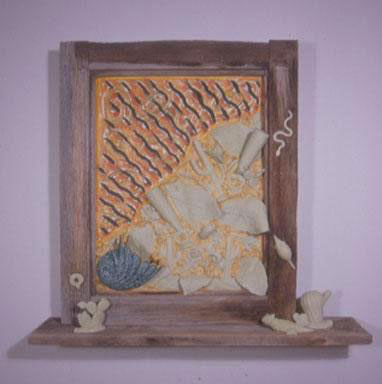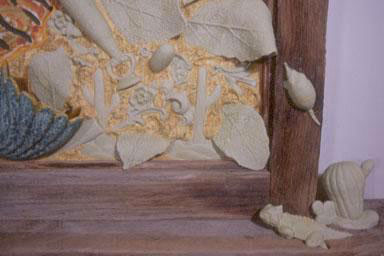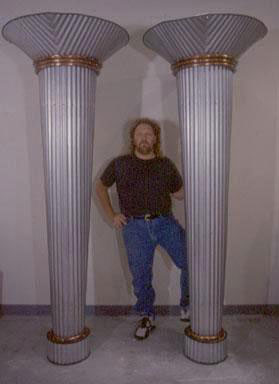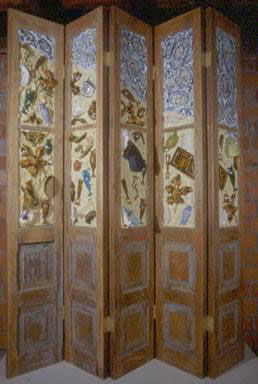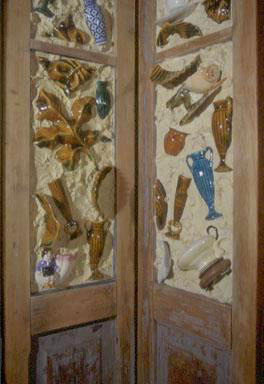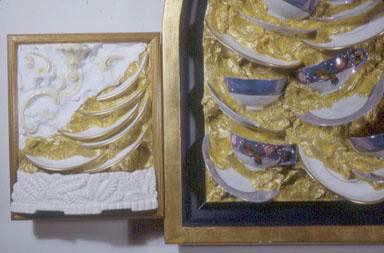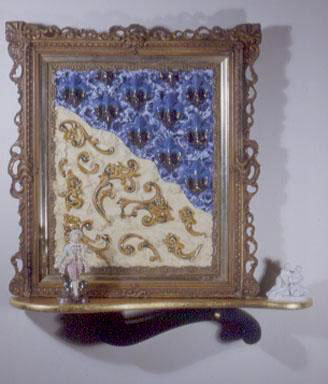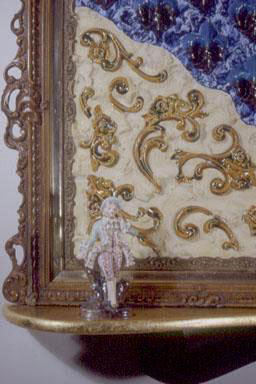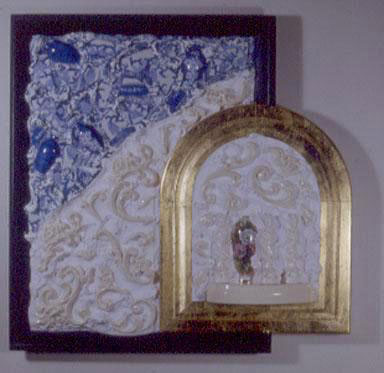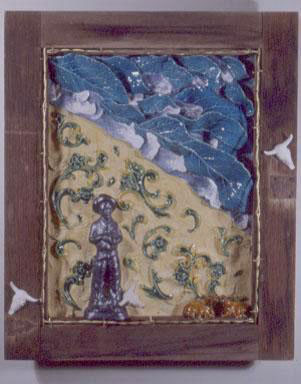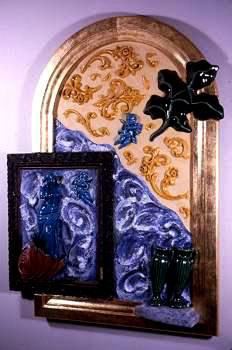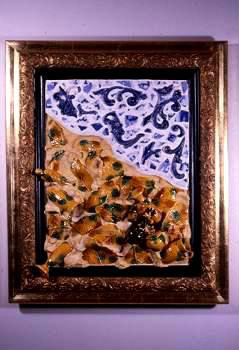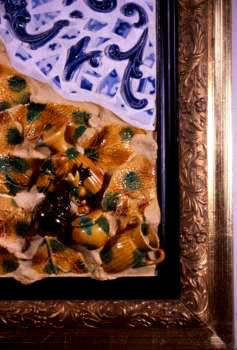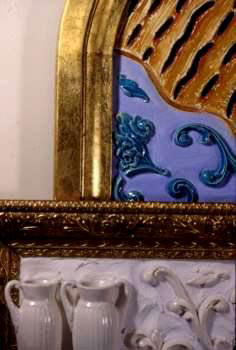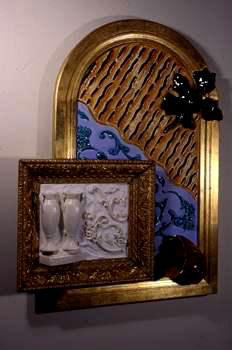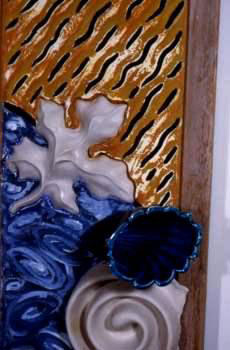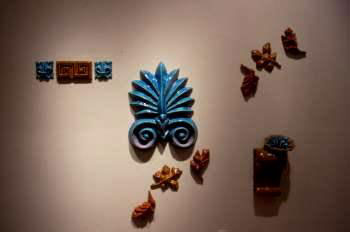Studio Sculpture
Conglomerate Compositions 2020
Challenged with creating new work for auctions and exhibitions for 2019 – 2020, I decided to utilize recently acquired vintage ceramic elements in a series of pedestal sized ceramic pieces. My inventory of collected vintage ceramic elements is reasonably extensive, primarily porcelain and split between functional ware and sculptural objects. I’ve been developing a vocabulary with these collected pieces over the past decade, utilizing the pieces in both pedestal sized pieces and installation work. Periodically, individuals who are aware of my creative use of this type of ceramic material in my art practice entrust a piece or even a collection of ceramic pieces for my use.
Recently I was gifted a wonderful collection of mid-20th C Japanese miniature figurines. The inspiration for these ‘conglomerate’ pieces came after examining the collection. I began each piece with a porcelain base; a plate or some type of container. Then I set about coming up with a composition of various elements, including using some of my own hand-built porcelain houses. Some of the elements have china paint, ceramic decals and gold luster applied to them and are re-fired. Once the additional firings are complete, the pieces are attached to one another, which may take a number of days. These pieces are available with prices on request.
- Winter 2019 - 2020
- 15" L x 8" H x 8" D
Celestial Bodies 2: Exploring the Milky Way Halo
After completing the first series of Celestial Bodies tile pieces, I embarked on a larger more ambitious effort in my research during the winter of 2019 – 2020. I decided to increase the scale from 8″ x 8″ to 24″ x 24″ porcelain tiles, choosing four colors to work with; black, white, green and blue. The expanded scale provided an expanded space to explore. The multiple firing schedule challenged my skill set as a ceramic artist (each piece is fired a minimum of four or five times). Utilizing ceramic china paint, ceramic decals and gold luster, each tile explores my interpretation of the Milky Way. Celestial Bodies 2: Exploring the Milky Way Halo are available as a group of four or individually; prices upon request.
- 2019 - 2020
- 24" x 24" each tile
Celestial Bodies: Exploring Black & White Spaces
I am fortunate to live in the country, where light pollution is low and observing the night sky is one of life’s pleasures. I have been intrigued with celestial activity since I was young and with the advent of modern space telescopes my interest has developed. This group of black and white porcelain tiles with ceramic enamels, ceramic decals and gold luster are my first explorations of ‘black holes’ in the far reaches of the universe. Made in 2019 the tiles can be viewed horizontally or hung on a wall. There are 2 sizes; 8×8 inches and 8×6 inches and are available for purchase. Prices on request.
- 2019
- 8"x8" & 8"x6"
Little Towers
I began working on some new ideas for a series of architectural pieces in the fall of 2020. I decided to use a low-fire white clay and bright low-fire glazes to switch things up. These first Little Towers pieces gave me the information I needed to inform larger pieces in this direction. Recalling research from a number of visits to the Yucatan years ago, this hybrid architectural form combines ancient cultural form with a contemporary interpretation. The colorful surfaces are highlighted with ceramic decals and gold luster. The pieces range in size from 1.5 to 4 inches in height. Working small is a great place to incubate new ideas. These pieces among others are available for purchase; price on request.
- November 2020
- 1.5 to 4 inches high
Ode to Archie Bray
Ode to Archie Bray was designed and constructed specifically for the 2016 Live Summer Auction to benefit the Archie Bray Foundation for the Ceramic Arts in Helena. It is composed of a combination of collected vintage porcelain pieces (many of which were re-fired a number of times, with additional china paint, decals and gold luster) along with a mid-20th C. clay pipe shard produced at the historic Western Clay Manufacturing Company. The piece sits on a painted wooded base.
The central image is a technical drawing (made into a ceramic decal and fired onto the surface of the plate) of one of the old beehive kilns at the Bray that has been restored by students and faculty from the University of Pennsylvania’s Architecture Program.
- 2016
Circular and Oval Porcelain Plates
Reclaimed, recycled and repurposed circular and oval porcelain plates with additions of china paint, decals and gold luster continue to evolve my visual vocabulary of storytelling.
- 2016
Granitewood Studio interior images
The ongoing collection of vintage porcelain continues to provide working material for both smaller scale studio pieces along with large-scale museum installations.
- 2016
Porcelain Plates
Honoring the WS Dickey Clay Mfg. Co. and the Mission Clay Products Co.
Commissioned by Mission Clay Products company of Corona, California to honor the 130 year history of clay pipe manufacturing in Pittsburg, Kansas and given to long time employees. Glazed porcelain plates were repurposed and the surfaces embellished with layers of china paint, decals and gold luster. Ceramic decals were made from the original beehive kiln plans from the WS Dickey clay pipe factory.
- 2014
- Each plate 11” Diameter x 1” Height
New studio work from Opposites Attract: A Marriage of Brick and Porcelain
The opportunity to mount a solo exhibition at Turman Larison Contemporary in 2013 was the pretext for an exploration of new ideas I began last year. Raw material for the concept included porcelain vessels, figurines and objects, along with a selection of historic bricks and brick shards I had acquired over the years.The concept for the exhibition was to marry the two seemingly opposite ceramic materials with precise cuts and commercial grade epoxy.
- 2013
Porcelain objects as raw material await assembly
Recent images from my Granitewood studio where a collection of porcelain objects await a new life. Vessels and figurines from every corner of the world have found their way to Helena, Montana. Plans are to create an installation based on a museum experience I had at the Zwinger Museum in Dresden, Germany in 2013.
- 2013
Recent Brick and Porcelain Pieces in the Studio
A mass of new work from the winter and spring of 2013 occupying a couple of studio tables. I chose 15 pieces from the 36 or so shown here to exhibit at Turman Larison Contemporary. Some were chosen for the exhibition and found new homes, others remain in the studio. In surveying the studio as pieces were being composed, I chose to re-purpose some of my own small pieces into these new brick and porcelain 3-D collages.
- 2013
Ten Quick Sketches: A Collaboration
A collaboration between my good friend, poet, writer and publisher Rick Newby and myself, continues our efforts to create art together (we have previously collaborated on Queen City Gateway, a site-specific architectural sculpture in downtown Helena). I asked Rick to consider writing a poetic response to a series of sumi ink drawings I had created based on elemental line drawings (serpentine lines, water, circle, square, house, arch, spiral) I had been using regularly in my work over the past 30 years. Rising to the challenge, Rick came up with an amazing 10 part poem titled Ten Quick Sketches, written while traveling in Italy.
- 2013
- Each framed panel: 13.5" Wide x 13" High x 1.5" Depth
Danish Wall Pieces at Petersen TEGL
These images of large brick slab plates and tiny soft brick villages were made and fired in the brick factory kilns at Petersen TEGL during the WABA symposium in 2011. The large brick plates had thick white slip applied to them and then I raked through the slip surface into the soft brick clay with my hands, incising one of my elemental symbols on each plate. The plates were dried slowly and black fired at the brick factory, with gold leaf was applied to selected areas of some of the plates post firing.
- 2013
Tile Houses
I started my first series of Tile Houses in 2009 for a solo exhibition at the Turman Larison Contemporary gallery in Helena, Montana. The glazed fired tiles are water-jet cut to my specifications and re-fired at Quarry Tile Company in Spokane, Washington. Once in my Granitwood Studio, I fire ceramic decals (both custom and commercially produced), china paint and gold luster onto the ceramic tile surfaces prior to final assembly.
- 2009 - 2012
- Four sizes from 6" to 13.5" square at base
Black and White Houses
I received an invitation to participate in a Black and White themed exhibition at Turman Larison Contemporary in 2012, which forced me to reduce my usually colorful tile palette to it’s most elemental form. I chose to produce 3 new tile pieces, using black and white Italian porcelain tiles. I took my inspiration for the new architectural forms from structures that had fascinated me in my travels; a Danish tower, a single story long-house and the ubiquitous barn structure found in Montana. I sent my drawings for the pieces to Quarry Tile Company in Spokane, Washington, who then produced CAD drawings for the computer directed cutting of their on-site water-jet saw.
- 2012
- Largest piece: 20" Long x 14" wide x 16" High
Organic House Villages
These Organic House Villages came about after returning from some of my international travels. On these overseas adventures, often building a large-scale site-specific architectural sculpture, I would take some time to build and fire some small hand-sized house pieces. I would make the small houses out of local clay and try to get them dried and fired in some sort of salt/soda or atmospheric wood firing. Decals, china paint and lusters are then applied and fired onto the surfaces.
- 2012
- Largest Village: 20" Wide x 5" Depth x 4" High
Tiny House Groupings
I continue to make groupings of my small tiny houses on a regular basis. They have been a good counter point to the large-scale sculptural activity, and each new piece takes me on another aesthetic adventure. I have made the houses in low-temperature terracotta, mid-range stoneware clays and high fired porcelains. I have often wedged chunks of natural feldspar stone into the high fired clays to add an additional texture to the surfaces. I will group them, mount them in totemic form or in ovals, spirals and circles on the wall. Decals, china paints and lusters intensify the atmospheric fired surfaces.
- 2009 - 2011
- Various sizes from 1.5" High to 4" High each house
Little Houses
A series of 19 ceramic tile houses for a one-person exhibition at Turman Larison Contemporary, Helena, Montana
- February - March 2009
Table Collaboration
A collaboration between Helena furniture maker and gallery owner Al Swanson and Robert Harrison. Water-jet cut glazed terra-cotta tile, with ceramic decals and gold luster
- 2007
- 12" x 12" square inlayed into hand-made black-stained wood table 18" square by 28" tall
Prairie Icon Series
Hand-altered wet brick, fired to cone 10 in a salt/soda atmosphere, with slips and gold luster
- 2005 - 2006
- Multiple sections average 9" High x 9" Wide x 9" Deep
Clay Windows: Light Radiators 2003
Hand built porcelain, with wedged feldspar, wood-fired to cone 12, with gold luster and wood bases
- 2003
- Pieces range between 12" and 14" High x 7" Wide x 3" Deep
Stack Arch Studies
Hand-built earthenware with glazes
- 2001
- Sizes range from 8.5" High x 8" Wide x 4.5" Deep to 9.75" High x 11" Wide x 5.5" Deep
New Clay Windows: Light Radiators 2001
Wood-fired porcelain, gold luster
- 2001
- Sizes range from 9" High x 9" Wide x 5" Deep to 17" High x 13.5" Wide x 8" Deep
Studio Interior
A selection of images taken of the interior of the studio. Works in progress include: large-scale architectural installation works, planning for site-specific architectural works and ongoing ceramic sculptural pieces.
Clay Windows
Handbuilt earthenware with glazes, wood base
- 2000
- Sizes range from 8" Wide x 2" Deep x 8" High to 10" Wide x 2" Deep x 11"
Stack Studies
Glazed ceramic elements, wood
- 1999
- Sizes range from 27" High x 7" Wide x 7" Deep to 20" High x 10" Wide x 5" Deep
Millennium Shell Cups (Groupings)
Sculptural slip-cast cups, glazed and lustered
- 1999
- Sizes range from 4" to 8" diameter
Arch Studies
Glazed ceramic elements, wood, gold leaf
- 1997
- Sizes range from 16" High x 12" Wide x 9" Deep to 19" High x 15" Wide x 11" Deep
Chinese Dyptych
Glazed ceramic elements, hydrocal plaster, wood, paint
- 1996
- 30" High x 48" Wide x 5" Deep
Desert Dream
Glazed ceramic elements, hydrocal plaster, wood, paint
- 1996
- 29" High x 30" Wide x 6" Deep
Broadwater Divider: Starry Night Revisited
Glazed ceramic elements, hydrocal plaster, wood, paint
- 1993
- 96" High x 72" Wide x 12" Deep
Rococo Teacup Icon
Glazed ceramic elements, hydrocal plaster, wood, paint, gold leaf
- 1993
- 24" high x 40" Wide x 5" Deep
Who is Madame DeLis?
Glazed ceramic elements, hydrocal plaster, wood, paint, gold leaf
- 1993
- 32" high x 30" Wide x 7" Deep
The Three Graces: Chinese Memories
Glazed ceramic elements, hydrocal plaster, wood, paint, gold leaf
- 1993
- 27" High x 27" Wide x 3" Deep
Blue Leaves Over Montana: Charlies Paisley Meadow
Glazed ceramic elements, hydrocal plaster, wood, paint, gold leaf
- 1991
- 29" High x 24" Wide x 4" Deep
The Birth of Venus DeMilo
Cast ceramic elements, hydrocal plaster, wood, paint, gold leaf
- 1991
- 36" High x 27" Wide x 4" Deep
T’ang Meets Yuan
Cast ceramic elements, hydrocal plaster, wood, gold leaf
- 1991
- 30" High x 25" Wide x 4" Deep
Palladian Dream: Rococo Reality
Cast ceramic elements, hydrocal plaster, wood, paint, gold leaf
- 1991
- 36" High x 28" Wide x 6" Deep
Architectural Window
Cast ceramic elements, hydrocal plaster,wood, paint
- 1990
- 38" High x 28" Wide x 6" Deep
Architectural Elements: Series Three
Hand pressed earthenware elements with terra sigelattas and glazes
- 1989
- 72" Long x 50" High x 10" Deep
